Allison Collection Photos
January, 1945
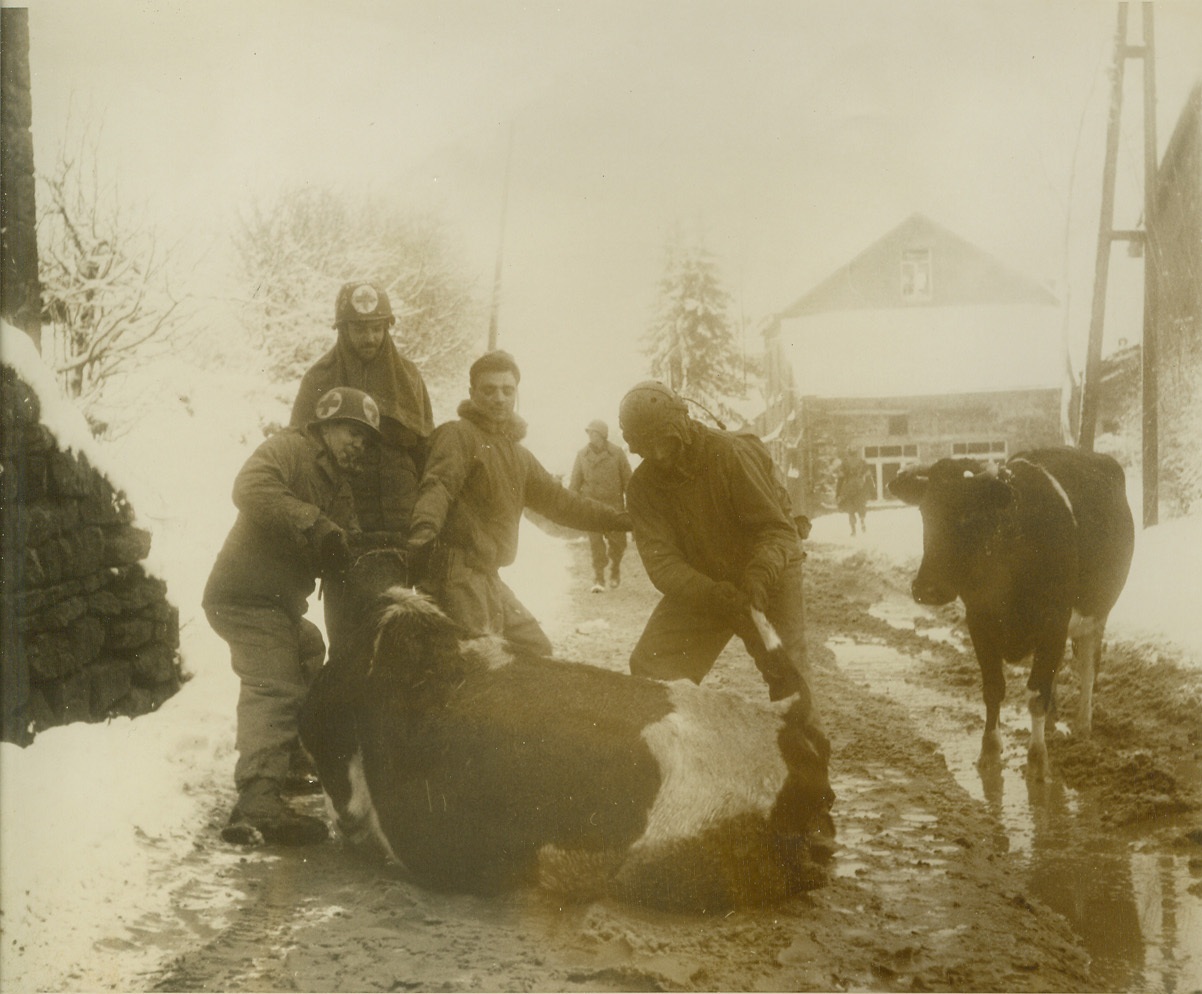
Bovine is Bottleneck for Yank Troops, 1/14/1945. Tri-Le-Cheslaing, Belgium – Performing what may be termed an extra-curricular duty, medical corpsmen of the US 1st Army pull and tug this reluctant cow, placidly sitting in the middle of the slushy road leading from Tri-Le-Cheslaing. Behind them, troops are waiting to advance into the Grandmenil Area. Photo by Harold Siegman, ACME War Pool Correspondent Credit (ACME);
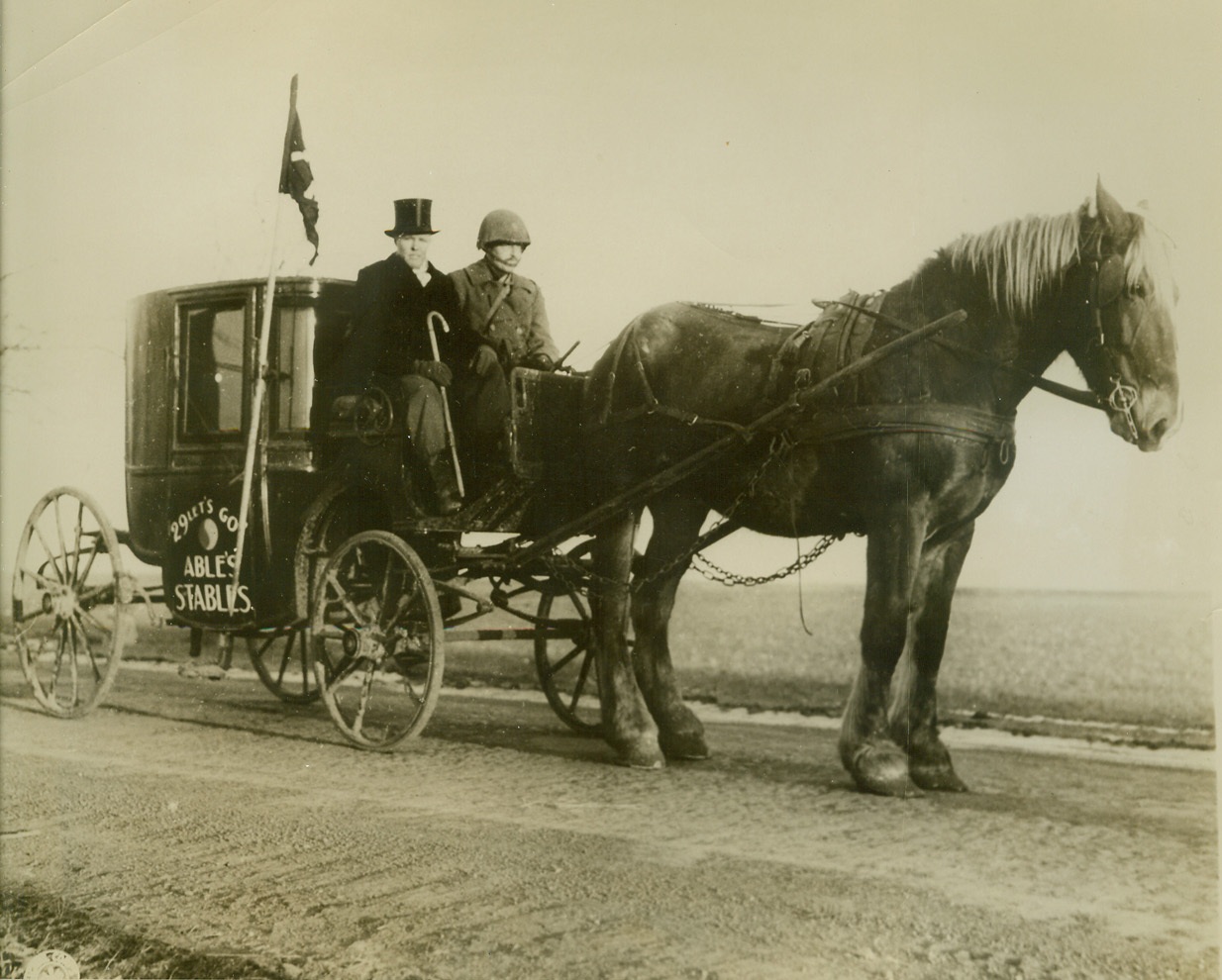
Just Joy Riding, 1/12/1945. Germany – the stables may be able, but the horse doesn’t look very. At any rate, Lt. Frank Bishop, Jr. (Left) suitably attired in frock coat and topper, and Pvt. Hermann Wilford, Winner, S.D., seem to be enjoying their buggy ride somewhere in Germany. Both are members of the 29th Division. Lt. Bishop is from Norman, Okla. Credit (Signal Corps Photo from ACME);
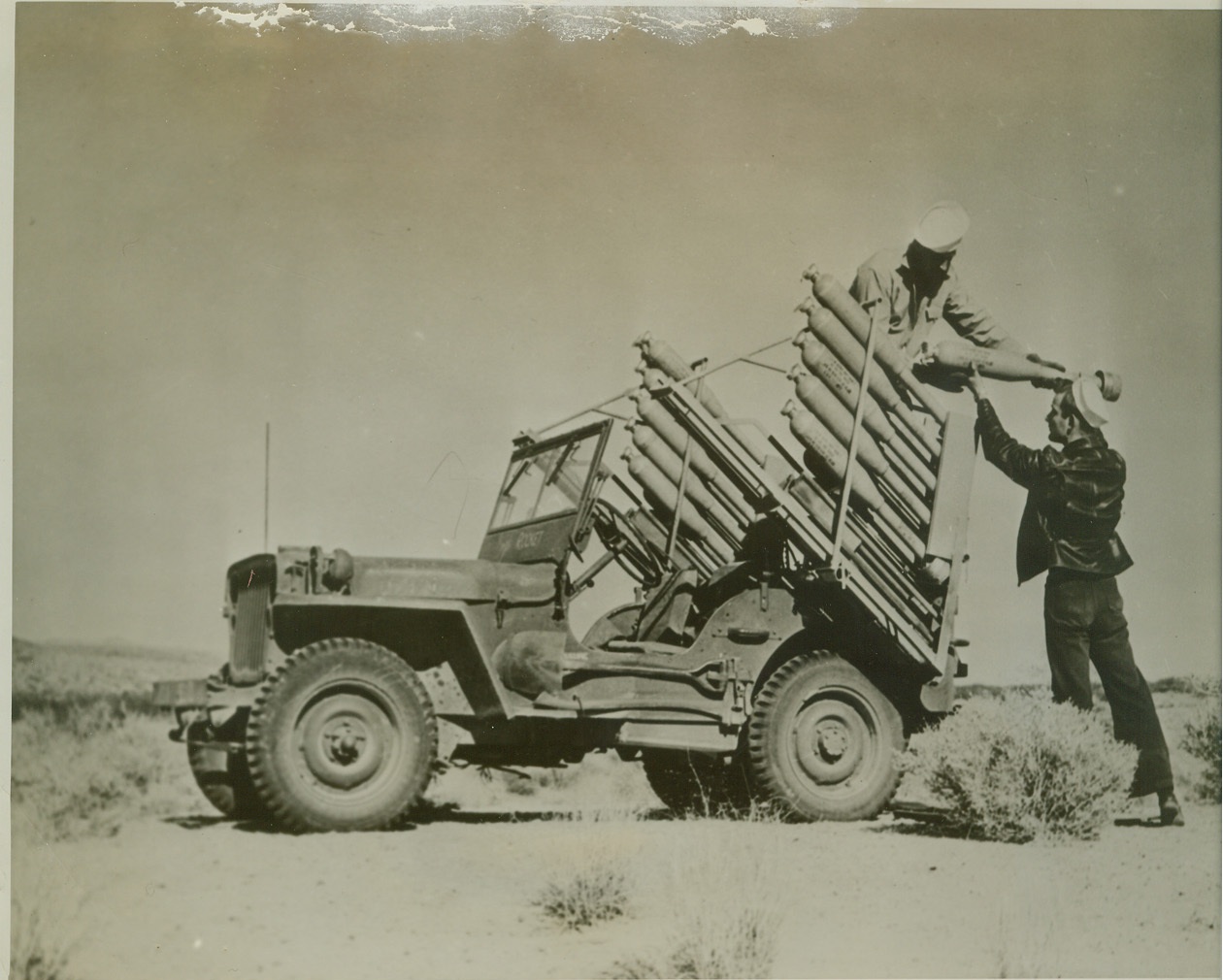
Fire Rockets From Jeep, 1/26/1945. InYokern, Calif. – At the Inyokern, Calif. government reservation where Navy and Marine Corps Air and ground crew forces train, engineers are experimenting with all possible methods in the use of the rocket. This Jeep has been turned into a launching platform. Reservation, which is 1025 square miles in area, is used as a testing ground for the rockets. Credit (U.S. Navy Photo from ACME);
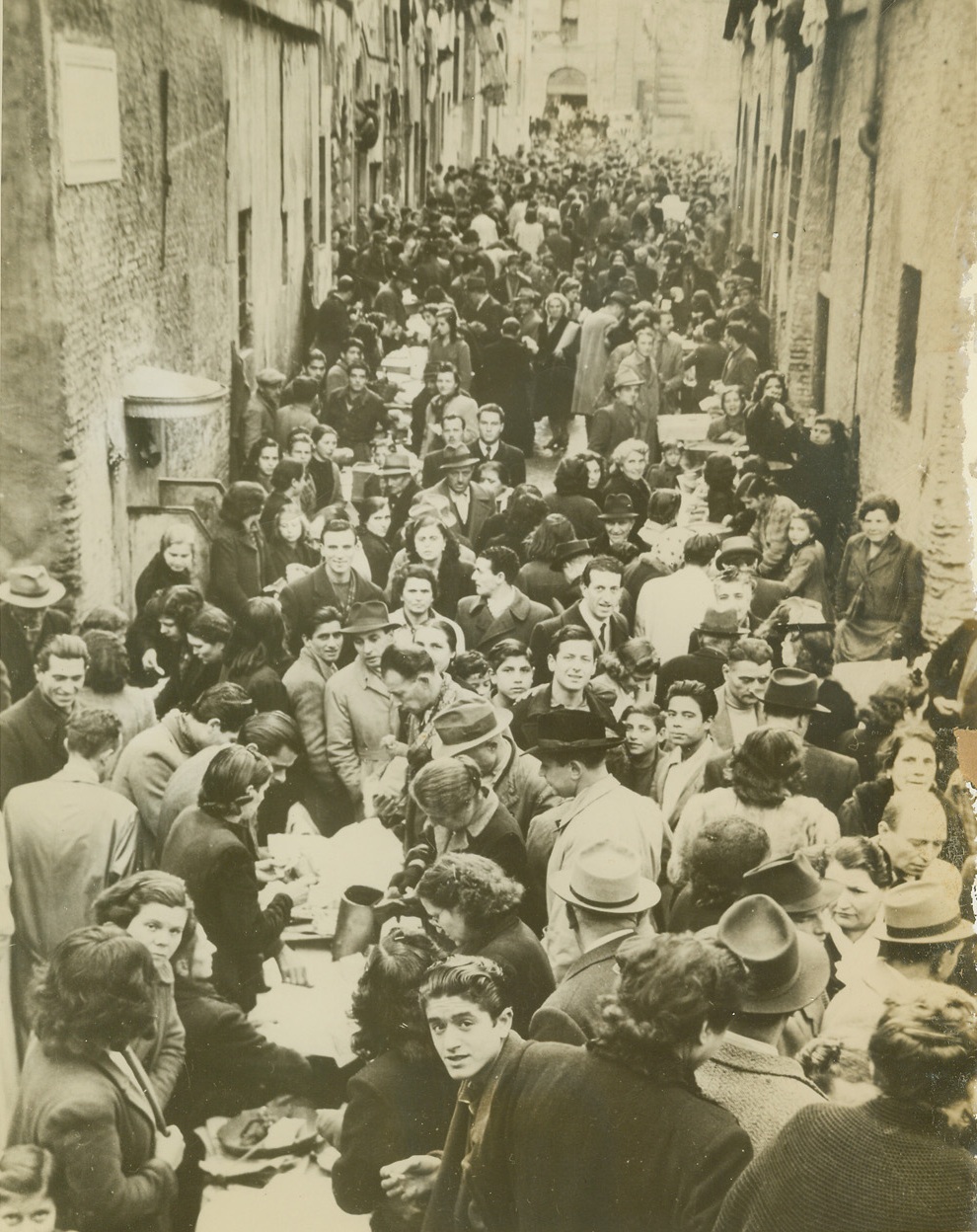
BLACK MARKET OPERATES IN BROAD DAYLIGHT, 1/2/1945. ROME, ITALY – At Via Tor di Nona, one of Rome’s chief black markets, business is going on as usual. There was a slight slackening of pace following several recent incidents where black market pastry shops were looted, but in two or three days the crowd was back in full force. Credit: ACME;
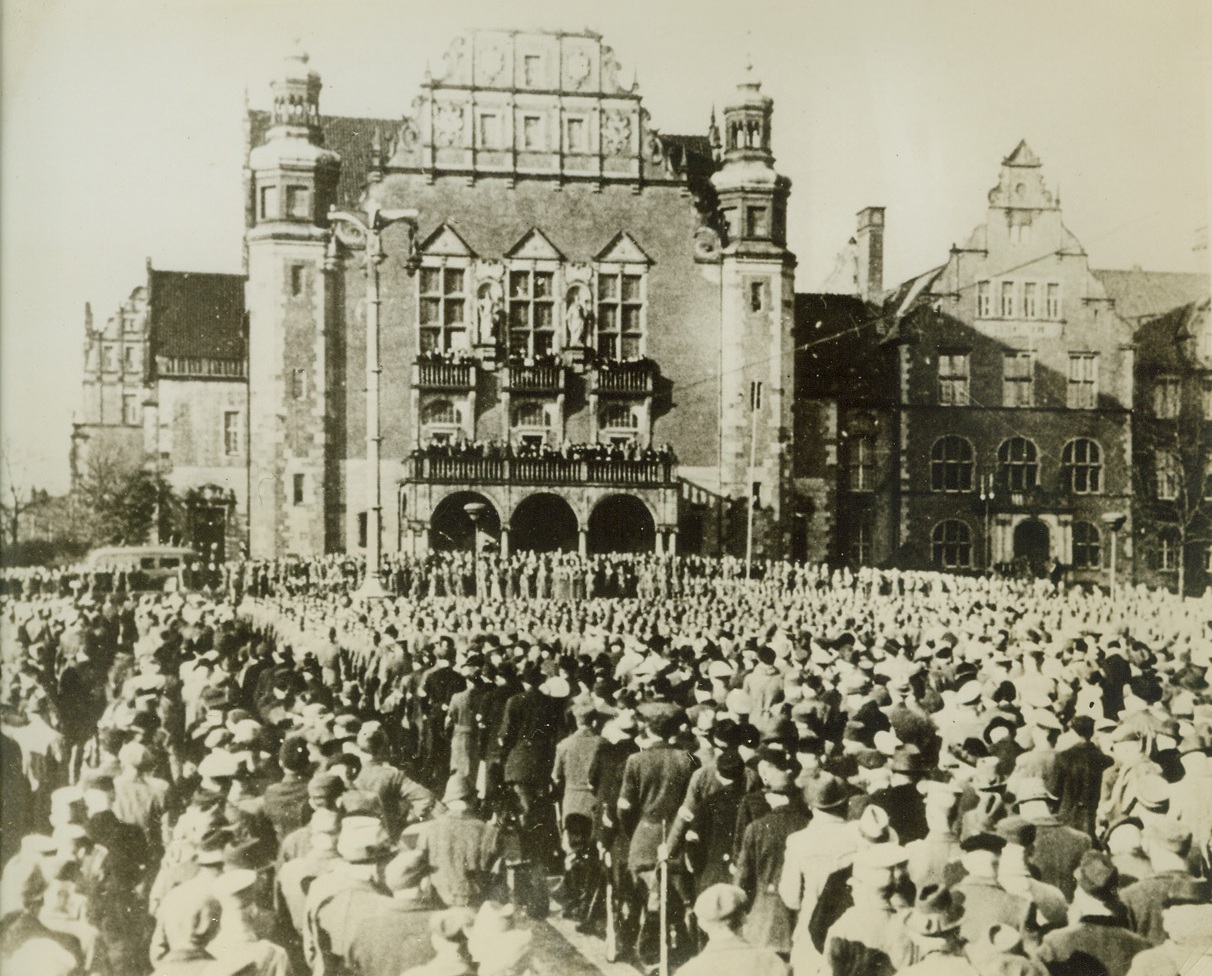
GERMAN PEOPLE’S ARMY IN POSEN, 1/23/1945. German People’s Army units crowd a square in Posen, Poland, to hear an address by Col. Gen. Heinz Guderian, chief of the German general staff, according to caption which accompanied this German photo distributed by a Swedish picture agency and received in New York, Jan. 23 from Stockholm. Occasion was the fifth anniversary of foundation of German province of Wartheland in occupied Poland.Credit: Acme;
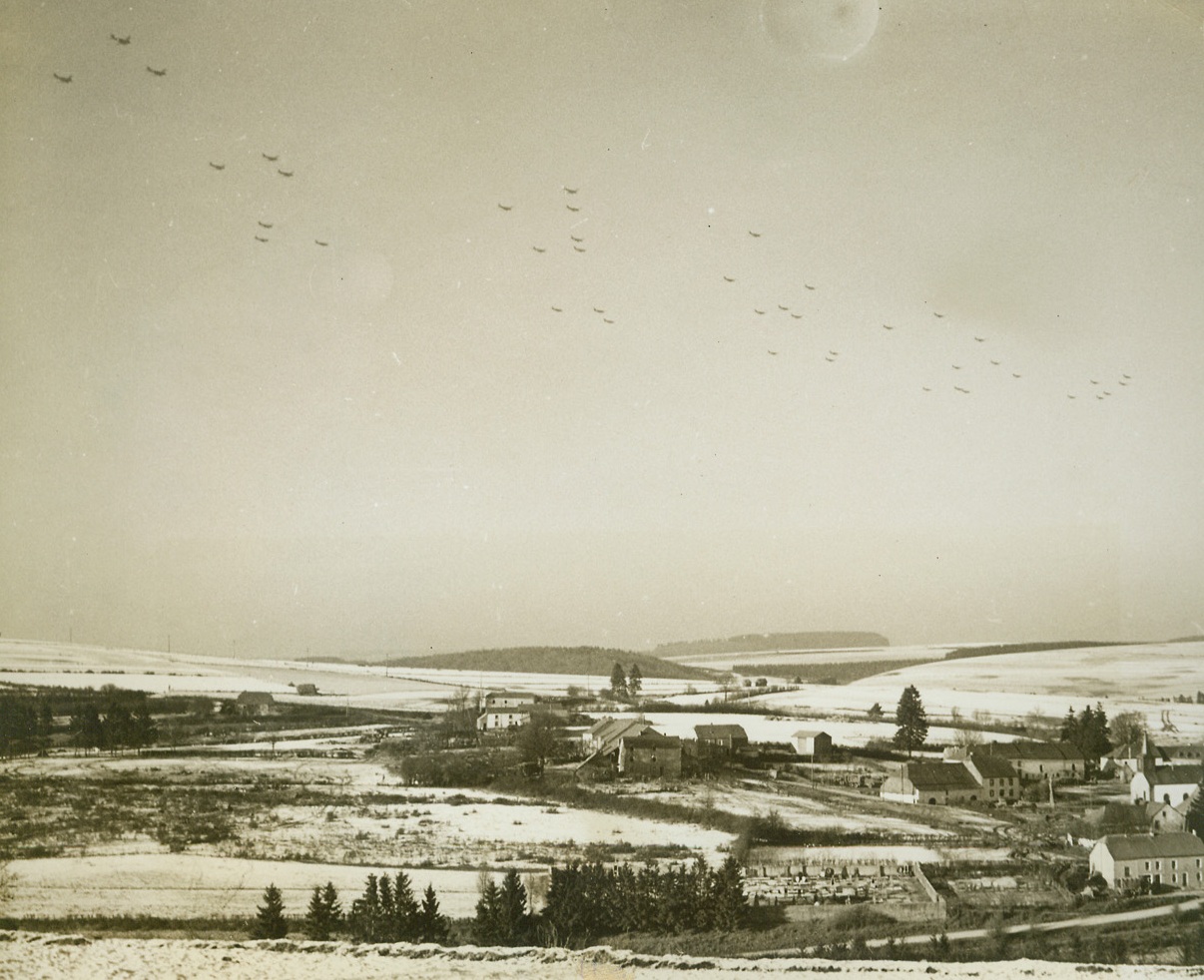
ARMADA FLIES SUPPLIES TO BASTOGNE, 1/6/1945. BASTOGNE, BELGIUM—Looking like a swarm of locusts as they wing over the Bastogne area, a vast armada of C-47 transports comes in to drop food and munitions to the encircled garrison at Bastogne. Carrying vital supplies to the trapped men, great supply fleets like this one made it possible for the Yanks to make their valiant stand. Photo by Charles Haacker, Acme photographer for the War Picture Pool.Credit: Acme;
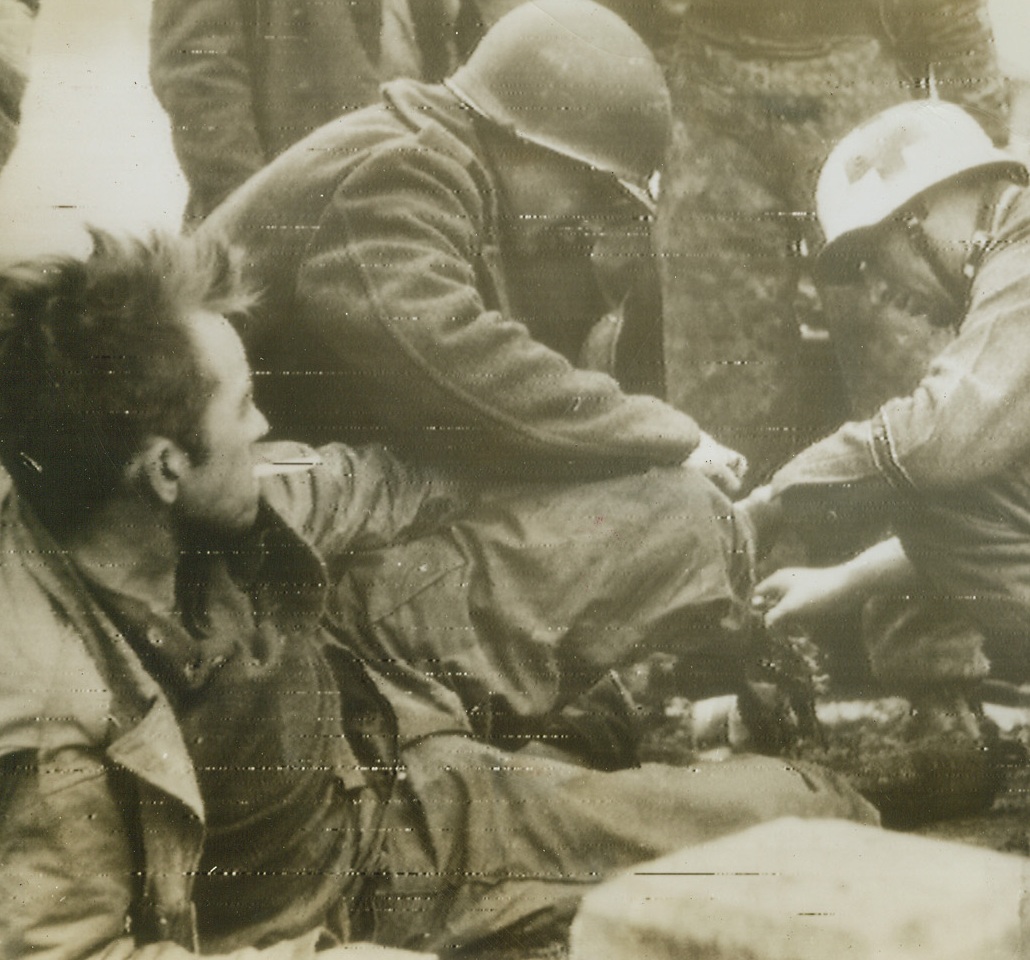
Wounded Yank Prisoner #2, 1/3/1945. Western Front—The same wounded American prisoner (see photo #R747111) is having his foot dressed by a fellow prisoner and a German Red Cross worker. In the foreground, according to German caption, is a concrete tank obstacle on the Siegfried Line. This photo was received by radio from Stockholm today. Credit: ACME radiophoto.;
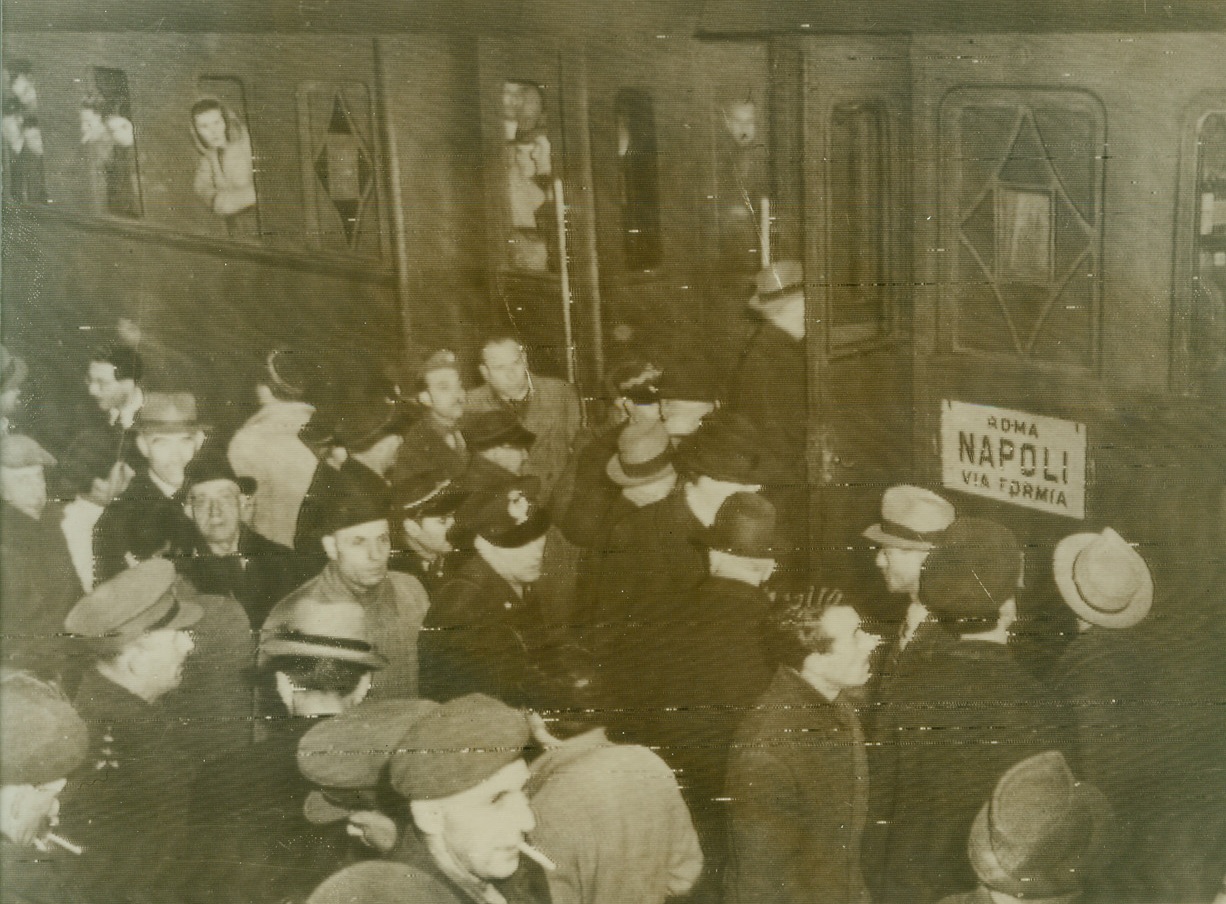
Democracy, Too, Makes Trains Run, 1/23/1945. Italy—Crowds jam the railroad station in Rome as the first civilian passenger train to Naples to operate since 1943 began its 12-hour run. Credit: Stars & Stripes photo via OWI radiophoto from ACME.;
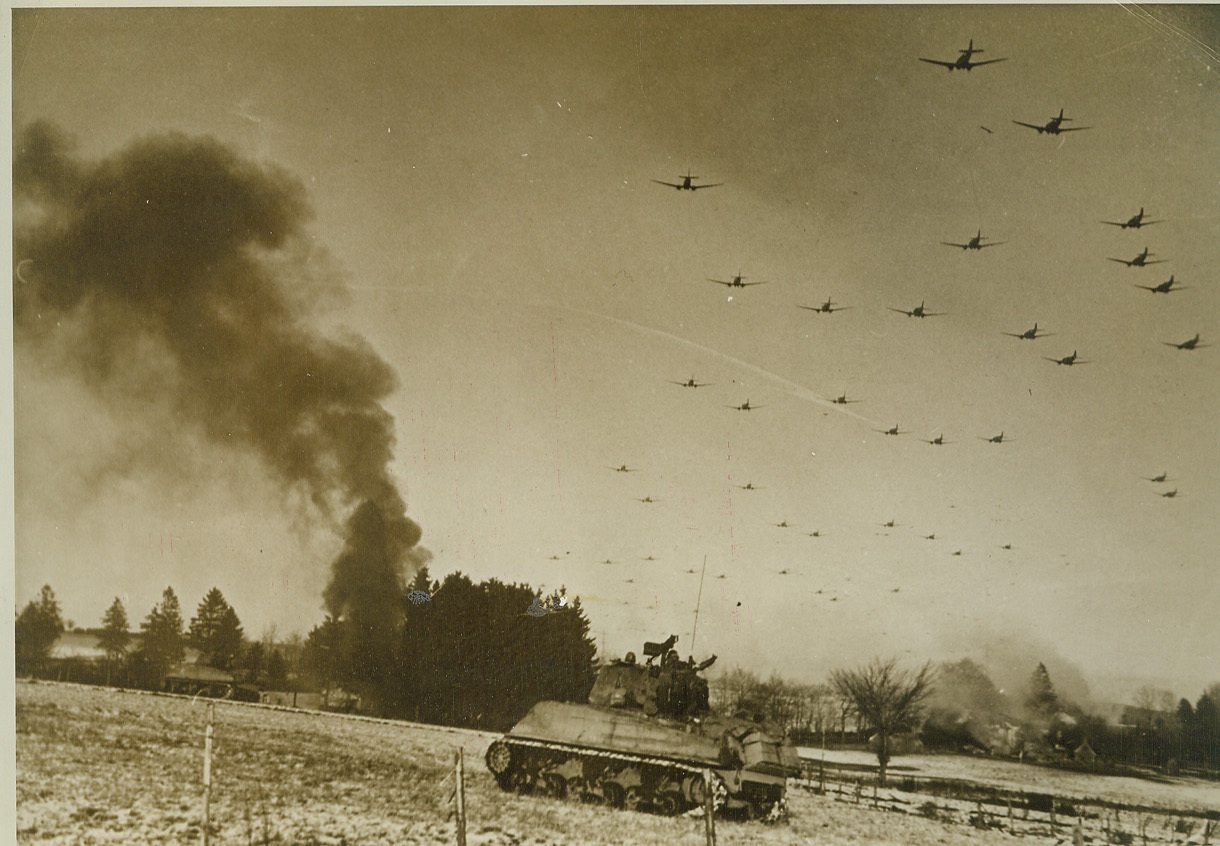
Fly Supplies to Bastogne, 1/6/1945. Belgium – An American tank rolls to attack Nazi positions as low-flying C-47 transports pass overhead carrying supplies to the hard-pressed garrison at Bastogne. Smoke from wrecked German equipment rises in the background. Credit-WP-(ACME);
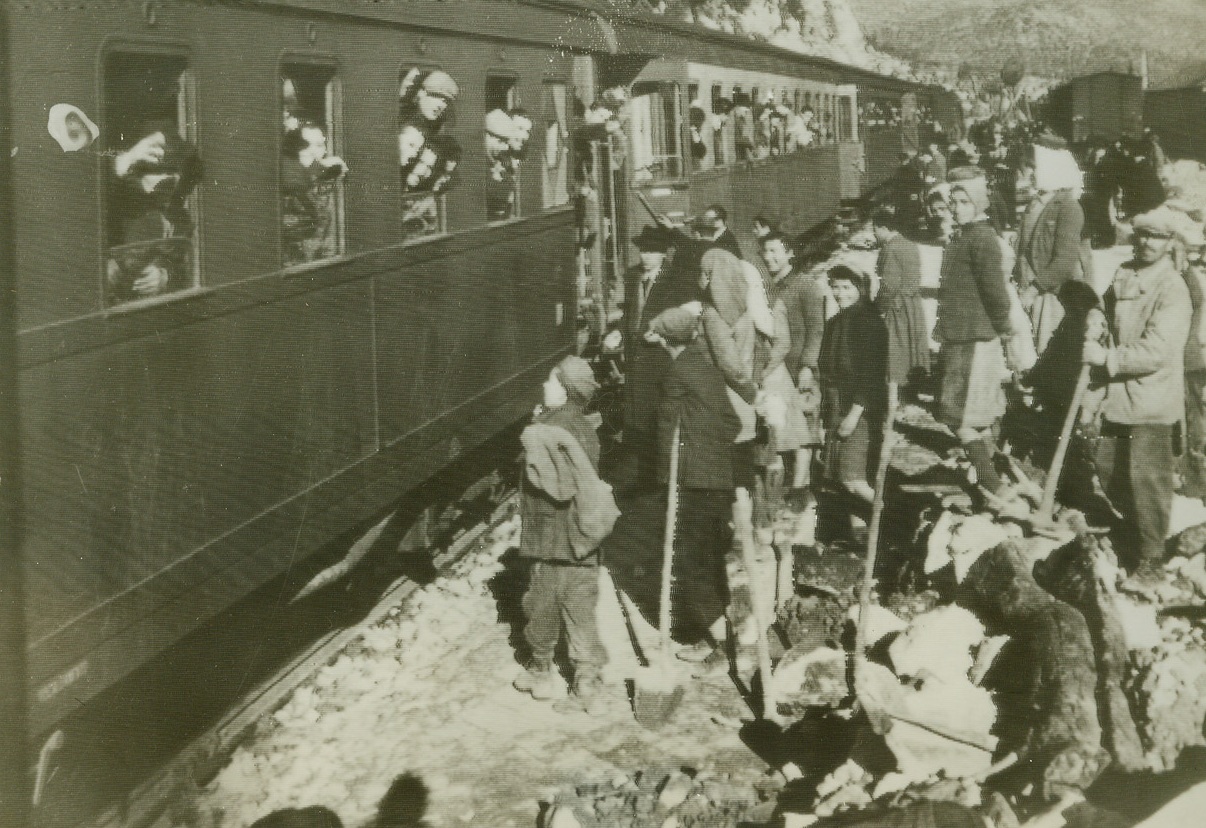
Democracy, Too, Makes Trains Run, 1/23/1945. Italy—Admiring Italians look on as the first civilian passenger train to operate between Rome and Naples since 1943, arrives at Formia Station. Credit: OWI radiophoto from ACME.;
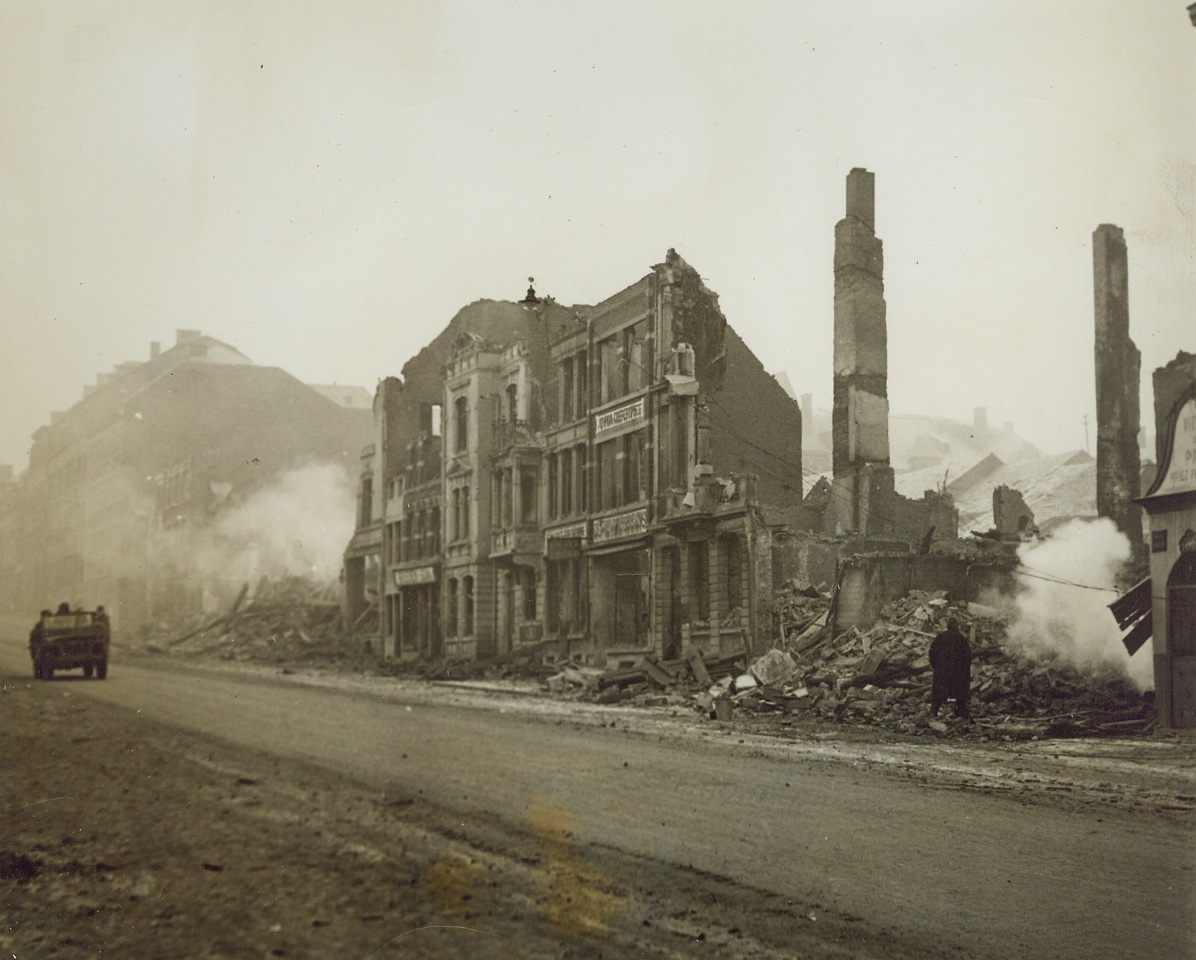
Battered Bastogne, 1/8/1945. BASTOGNE, BELGIUM—An army jeep moves down a cleared street in Bastogne after the besieged city was relieved from the pressure of German attack by men of Gen. Patton’s army. Debris is still heaped high on the sidewalks and the great number of the buildings has been shattered beyond repair by German bombs. Credit: ACME photo.;
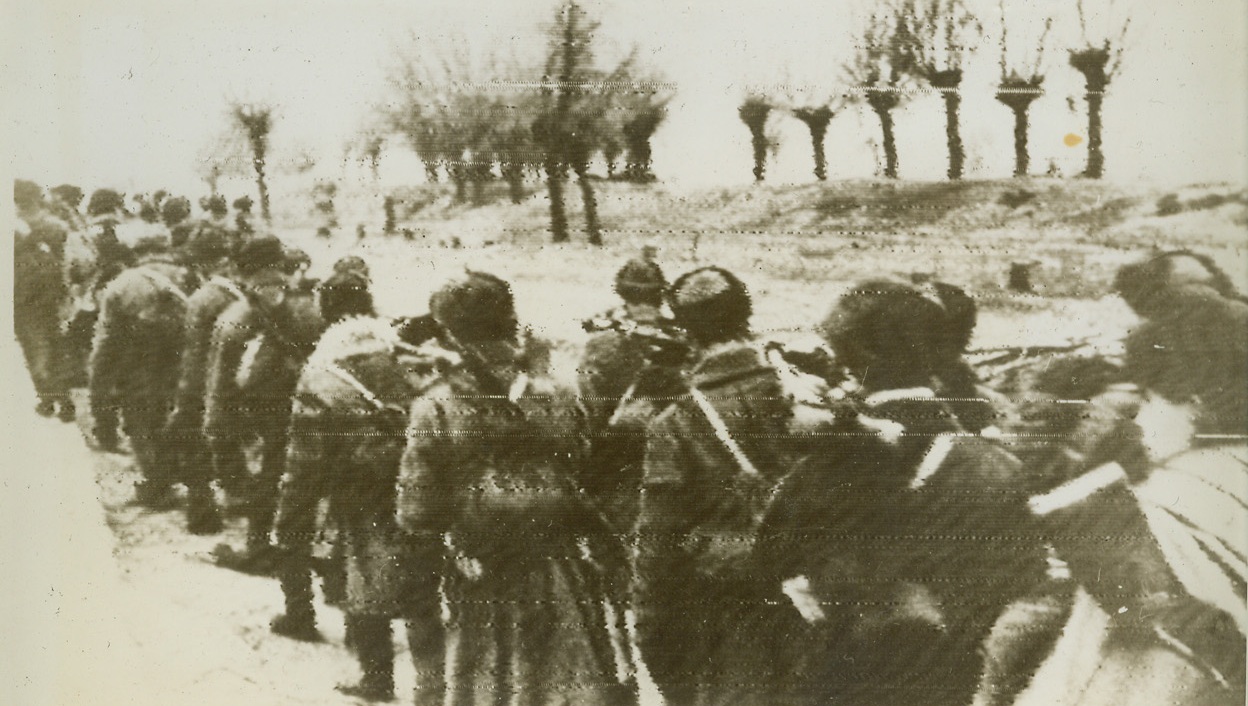
Red Army in Warsaw, 1/23/1945. WARSAW—Soviet Infantrymen march west of the liberated, but devastated Polish capital of Warsaw, as army forces sweep across Europe. Latest reports indicate that the Russians are only 137 miles from Berlin. Credit: ACME RADIOPHOTO.;
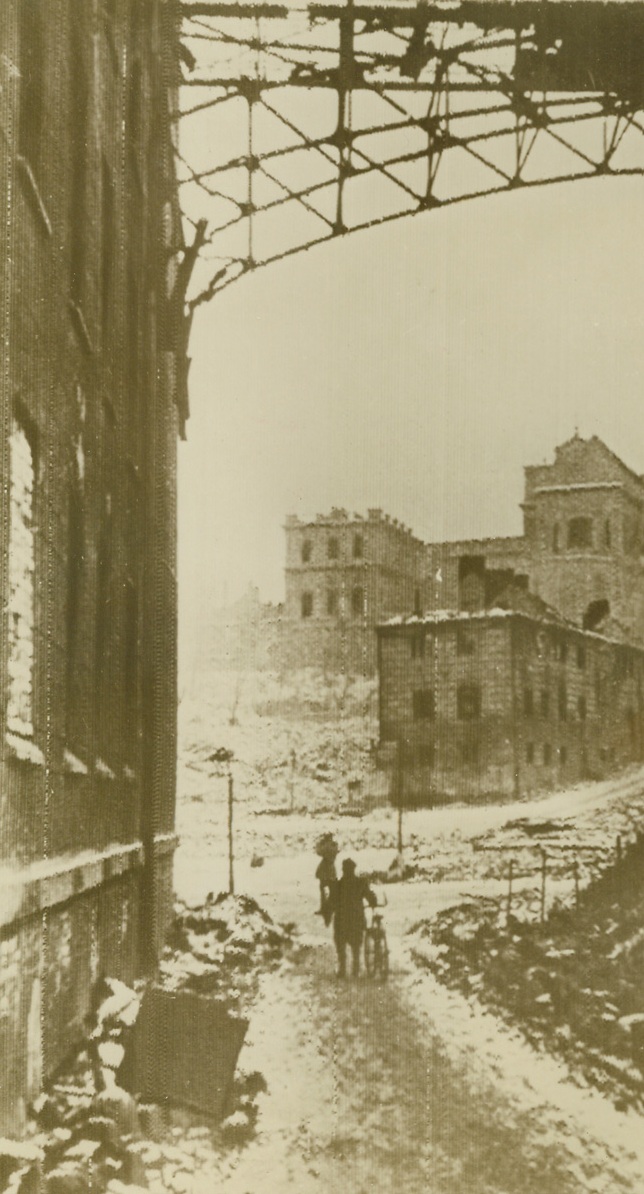
Blitzed Warsaw, 1/22/1945. WARSAW, POLAND—Here is what the demolished houses in the Warsaw market square looked like when the Red Army moved into the blitzed Polish capital. Credit: ACME RADIOPHOTO.;
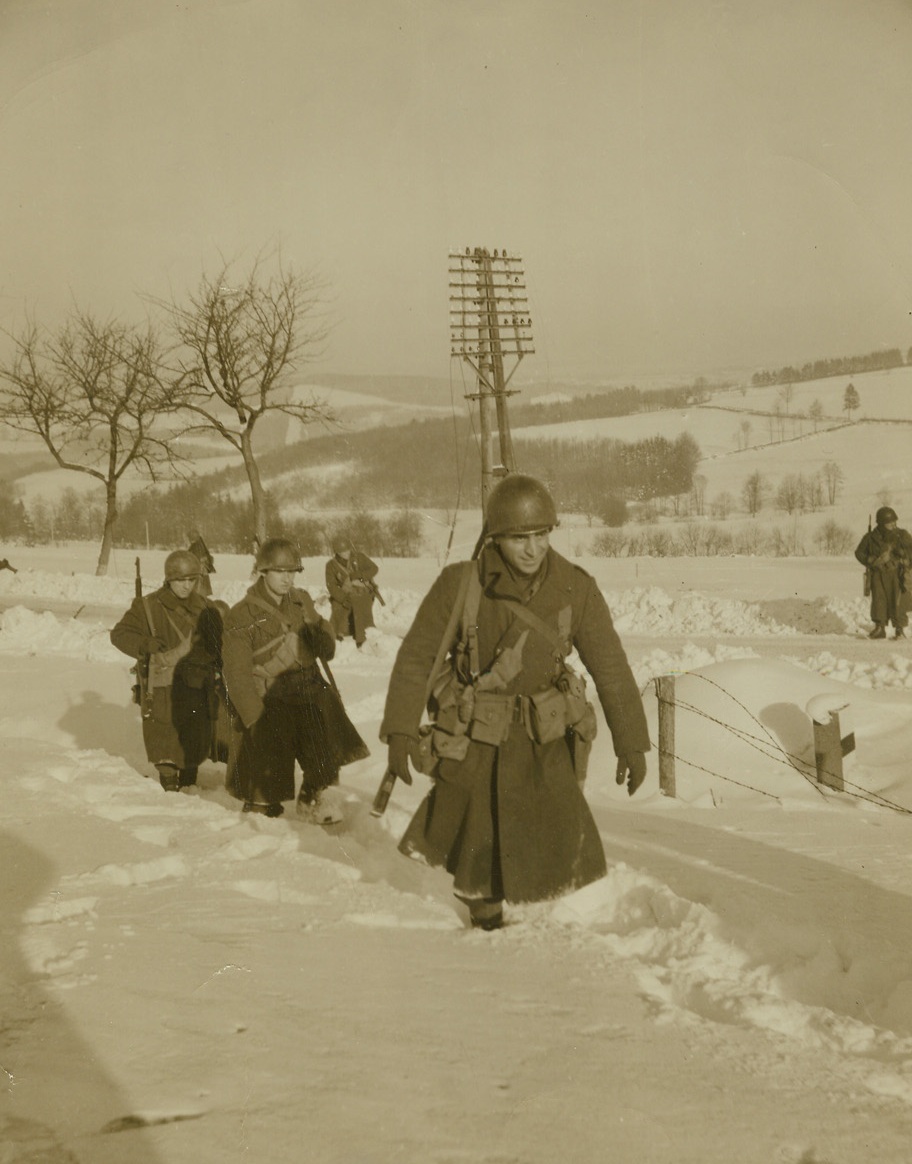
BREAKING THE TRAIL, 1/21/1945. BELGIUM—Snow scenes make lovely pictures, but for Yanks who have to fight and live in it, it’s not so nice. Here, troops of the US 1st Army in Belgium cut across snow-covered fields and through drifts as they advance to bea the Germans back into their homeland.Credit: Photo by Harold Siegman, Acme War Pool Correspondent;
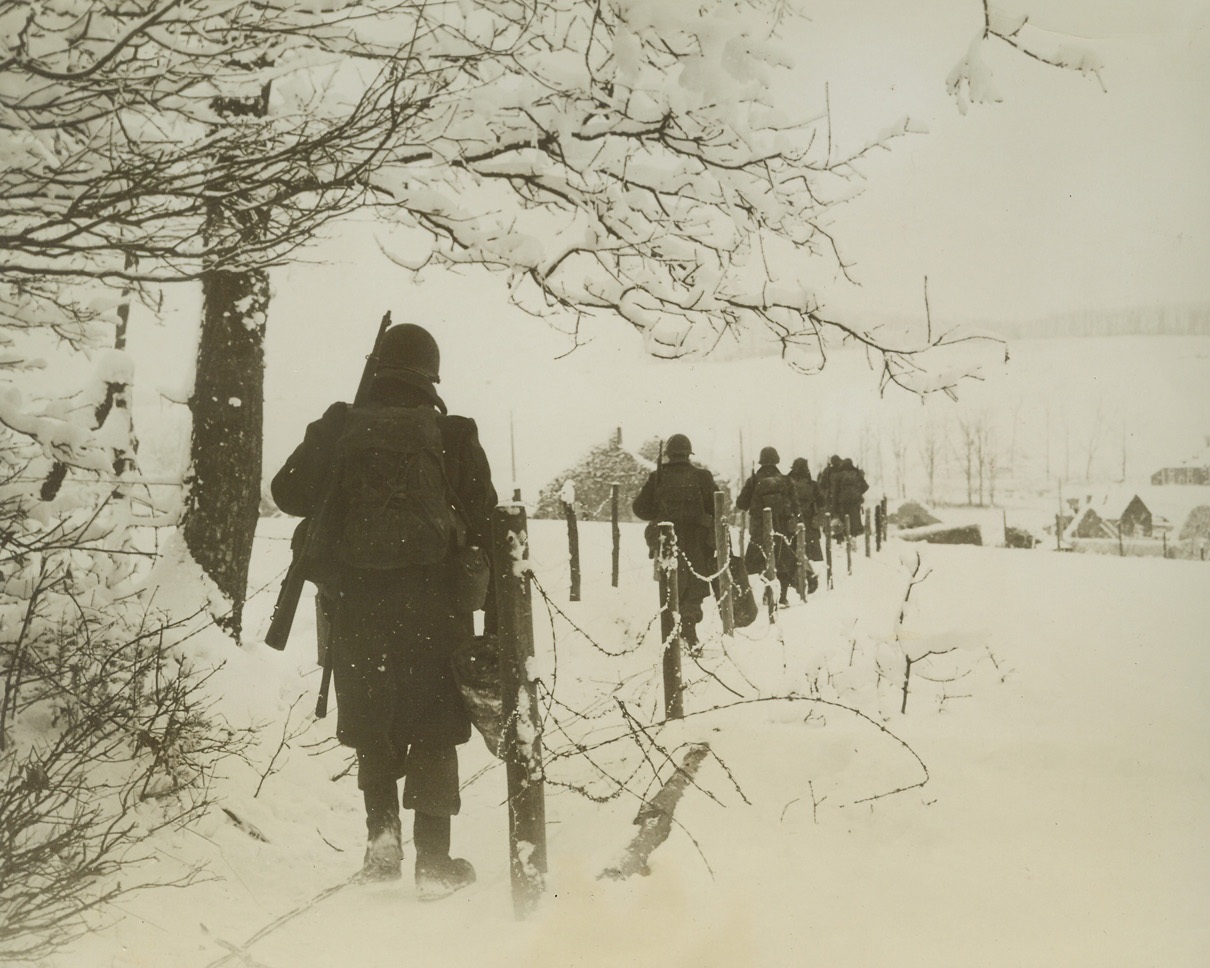
YANKS ADVANCE ON HOUFFALIZE, 1/24/1945. Infantrymen of General Patton’s third Army, dressed against the cold, slog their way over snow-covered countryside to occupy Lutrebois during drive on Houffalize.Credit: Acme;
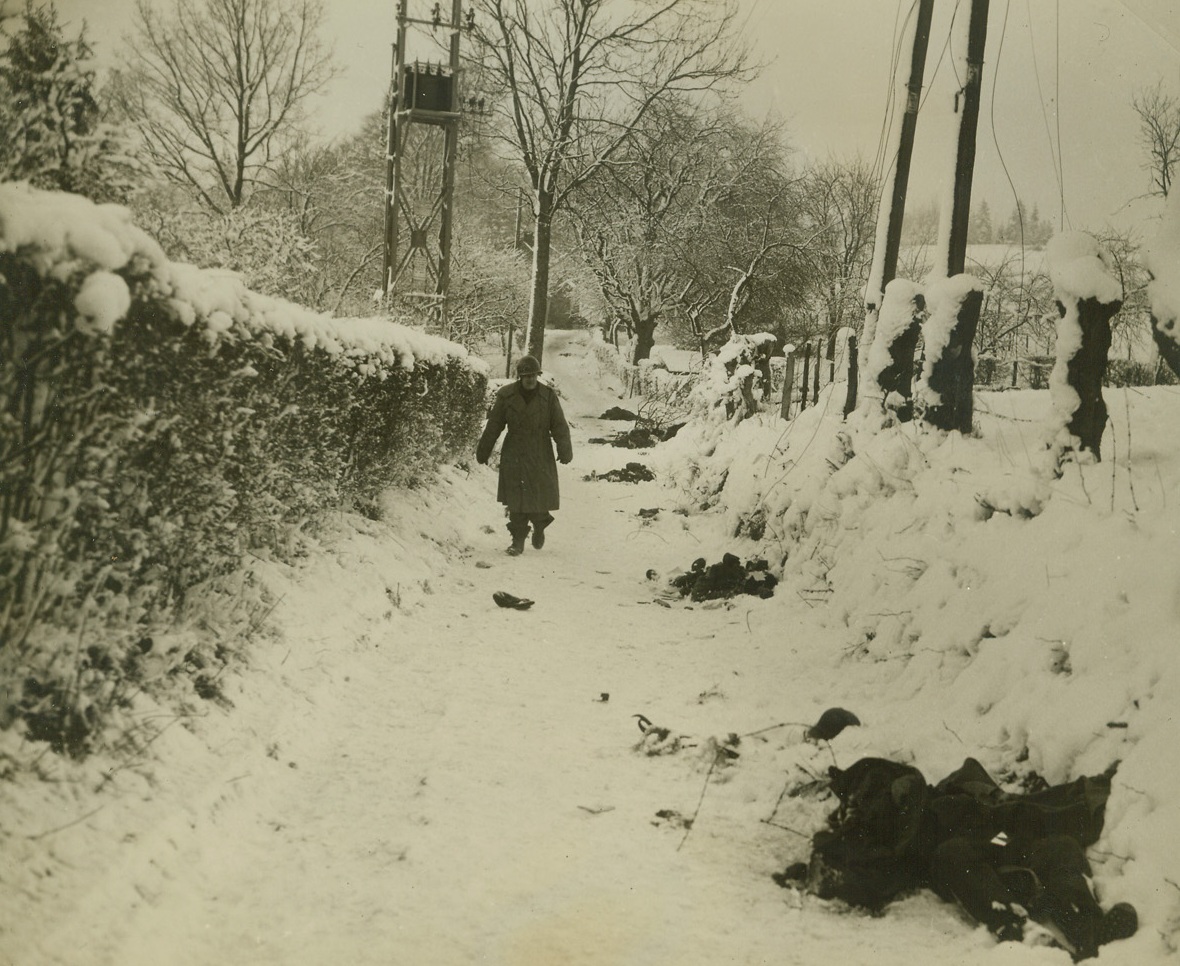
THEIR DEATH WARRANT, 1/14/1945. BELGIUM—When the Germans staged the recent counterattack in Belgium, the move practically sealed their death warrant. Here, a Yank walks down a street of a Belgian town and surveys the bodies of dead Germans lying in the snow, killed as they tried to keep the town from being recaptured by troops of the 82nd Airborne Division of the US Army. Photo is by Harold Siegman, Acme War Pool Correspondent. Credit: Acme;
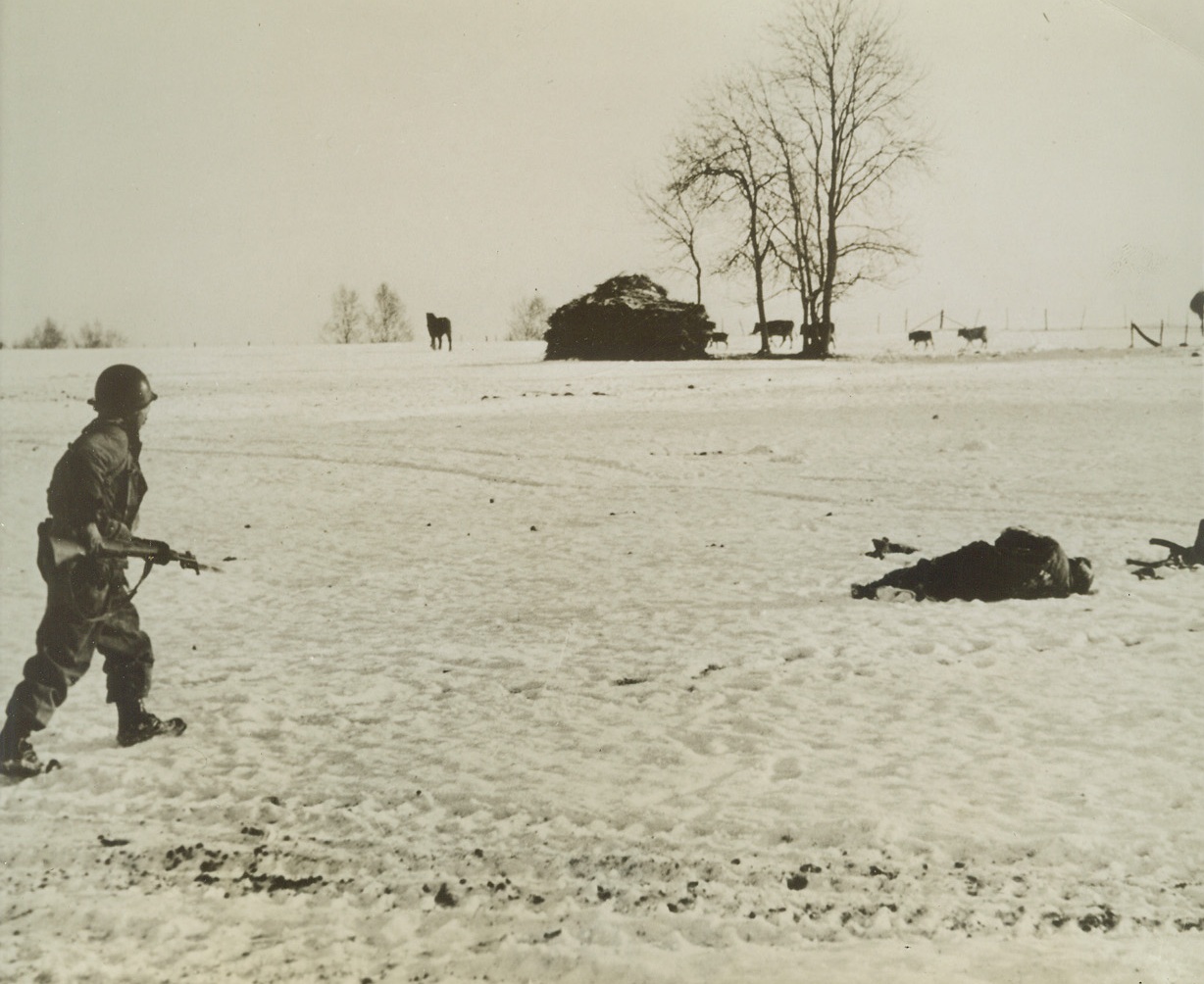
MAN IN THE SNOW, 1/6/1945. BASTOGNE, BELGIUM—Advancing cautiously across a snow-covered field, an American soldier nears the spot where a Nazi fighter lies. He keeps his gun ready for use at a moment’s notice until he finds out whether the man is dead or alive. Credit: Acme;
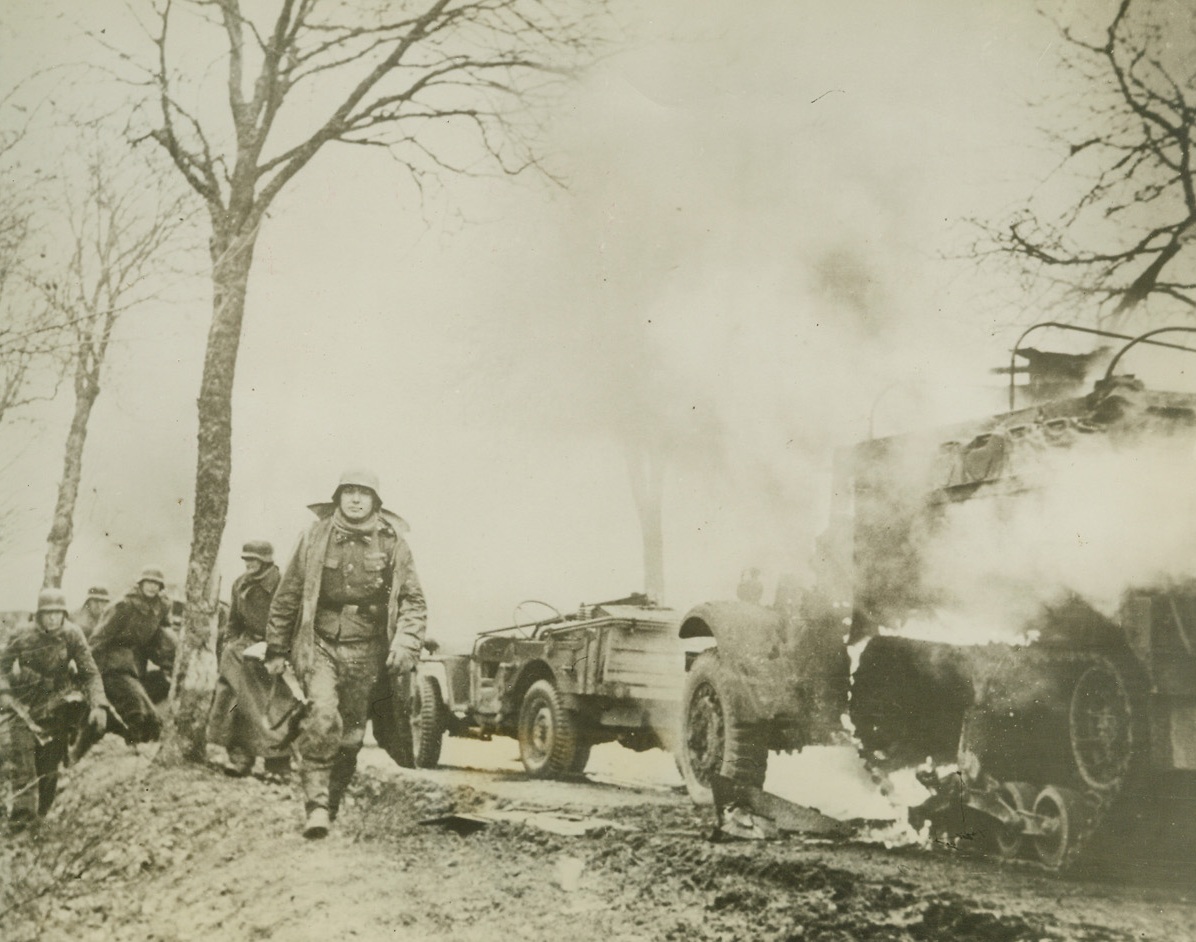
GERMANS PUSH FORWARD, 1/2/1945. WESTERN FRONT—This photo taken from a captured German film shows German infantrymen passing burning American vehicles somewhere on the Western Front during the enemy drive into American positions. Credit: Acme;
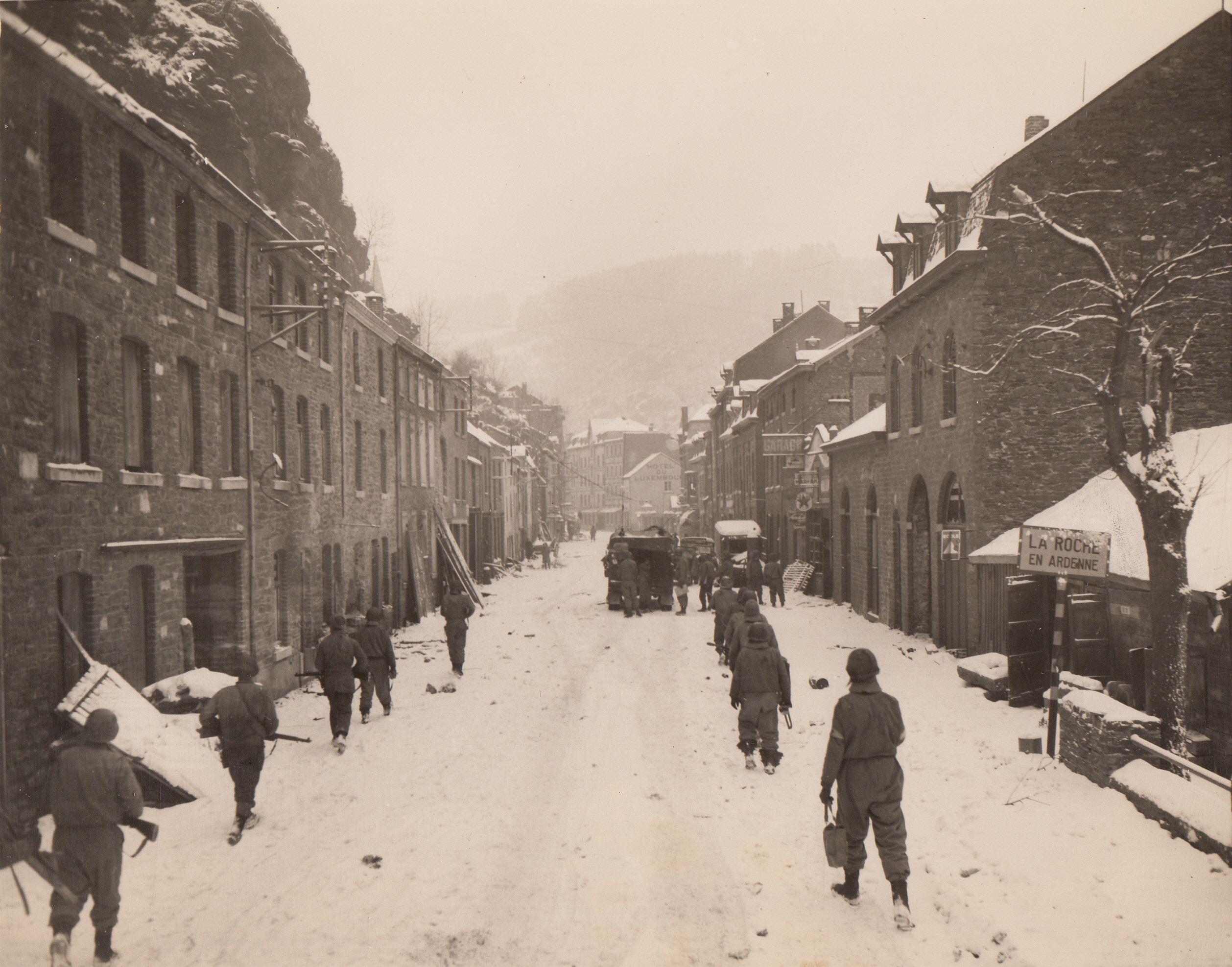
YANKS ENTER LA ROCHE, 1/19/1945. BELGIUM—Snow still falls on the battle-scarred town of La Roche as American soldiers enter after Nazis had been driven into the hills. Yanks walk in single file on both sides of road.;
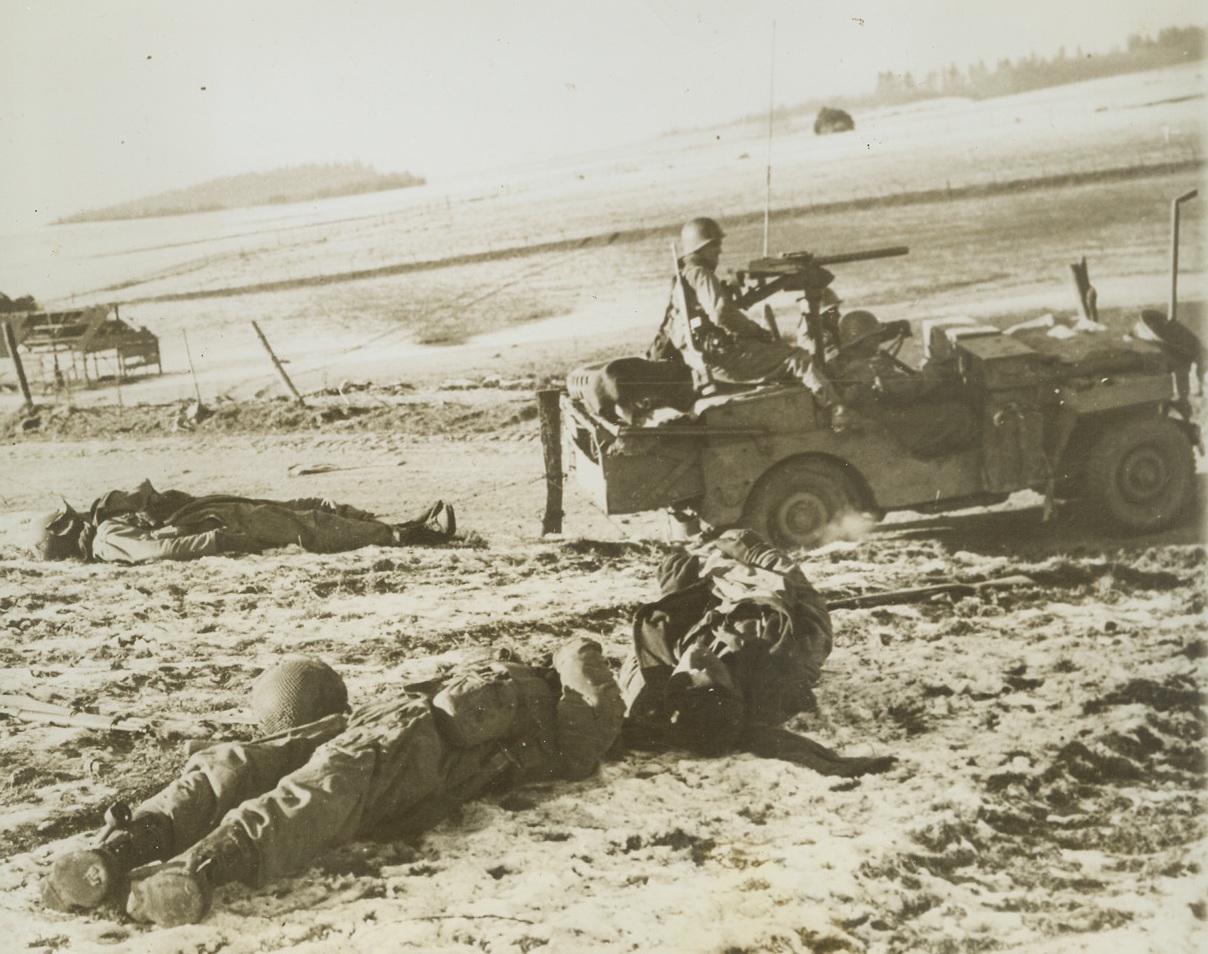
DOWN AS THEY BATTLED GERMAN ATTACK, 1/8/1945. CHAUMONT, BELGIUM—Killed as they tried to ward off the German counter-offensive launched at Chaumont, five miles south of Bastogne, these American soldiers lie where they fell in the snow. On the right, three Yanks in a jeep keep on the alert for other enemy attacks. Gen. Patton’s army, which relieved besieged Bastogne, has succeeded in narrowing the neck of the German bulge to less than 10 miles. Credit: Acme;
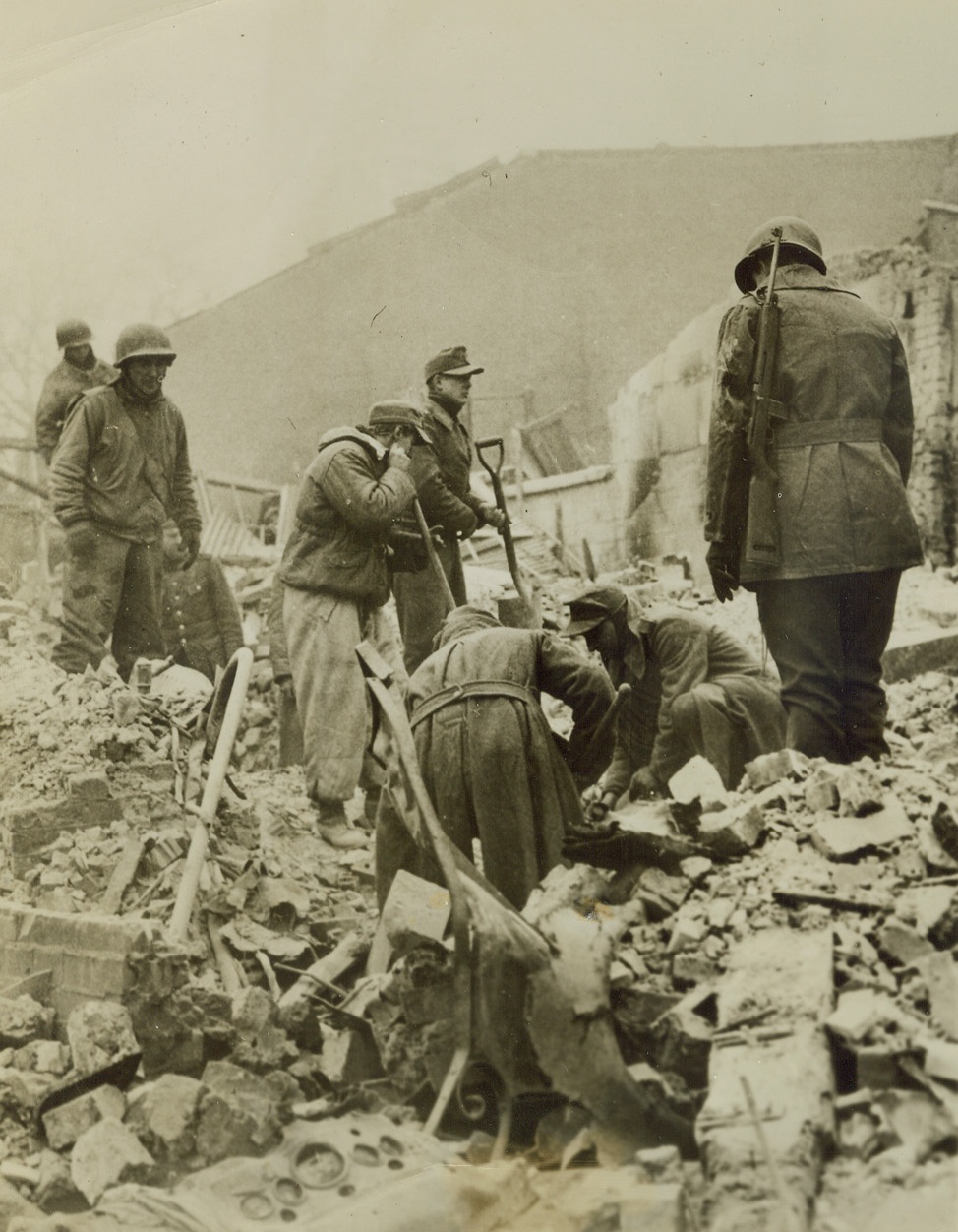
REPAIRING THE DAMAGE THEY WROUGHT, 1/8/1945. BASTOGNE, BELGIUM—Captured when Gen. Patton’s men came to relieve the besieged city of Bastogne, these German prisoners are put to work clearing away the debris wrought by their own bombs and shells. Yank soldiers oversee the job. Credit: Acme;
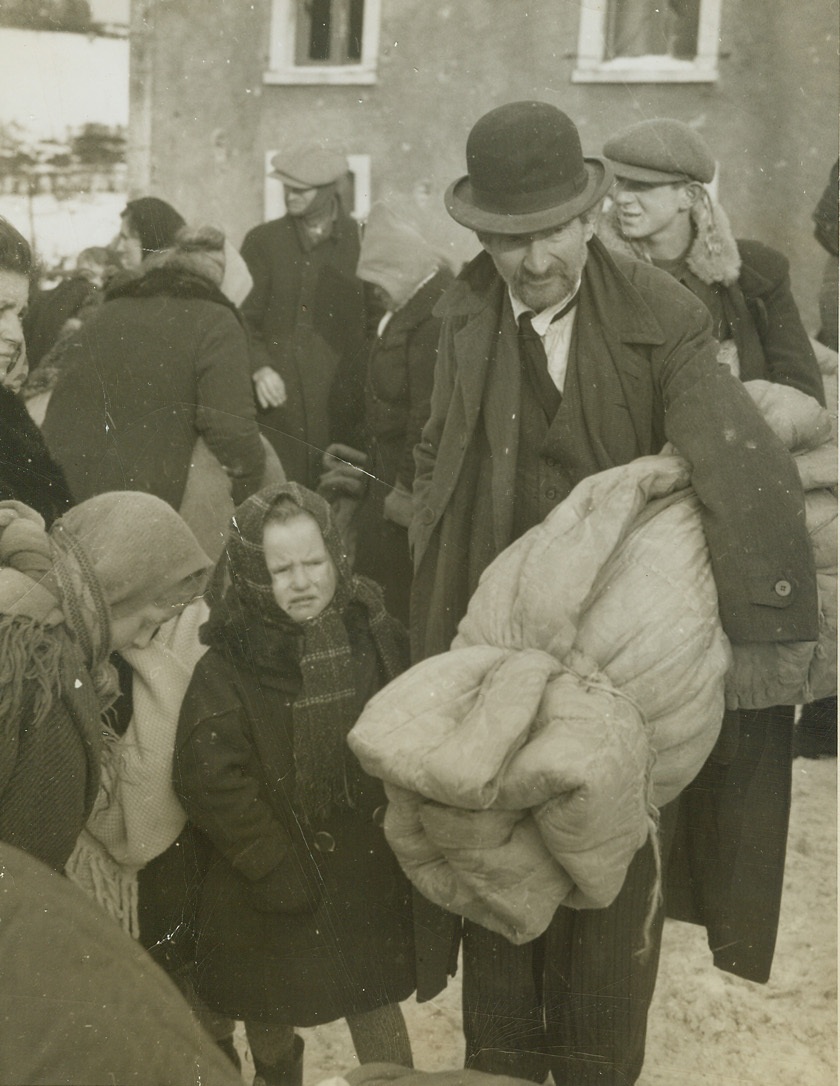
Evicted by War, HARLANGE, 1/21/1945. BELGIUM -- Bent under the weight of his blanket roll, this citizen of Harlange holds the hand of his little girl, who is weeping bitterly, as they wait, with other Belgians, for trucks which will take them from Harlange to safety behind the battle lines. Photo by Charles Haacker, Acme war pool correspondent. Credit (ACME) (WP);
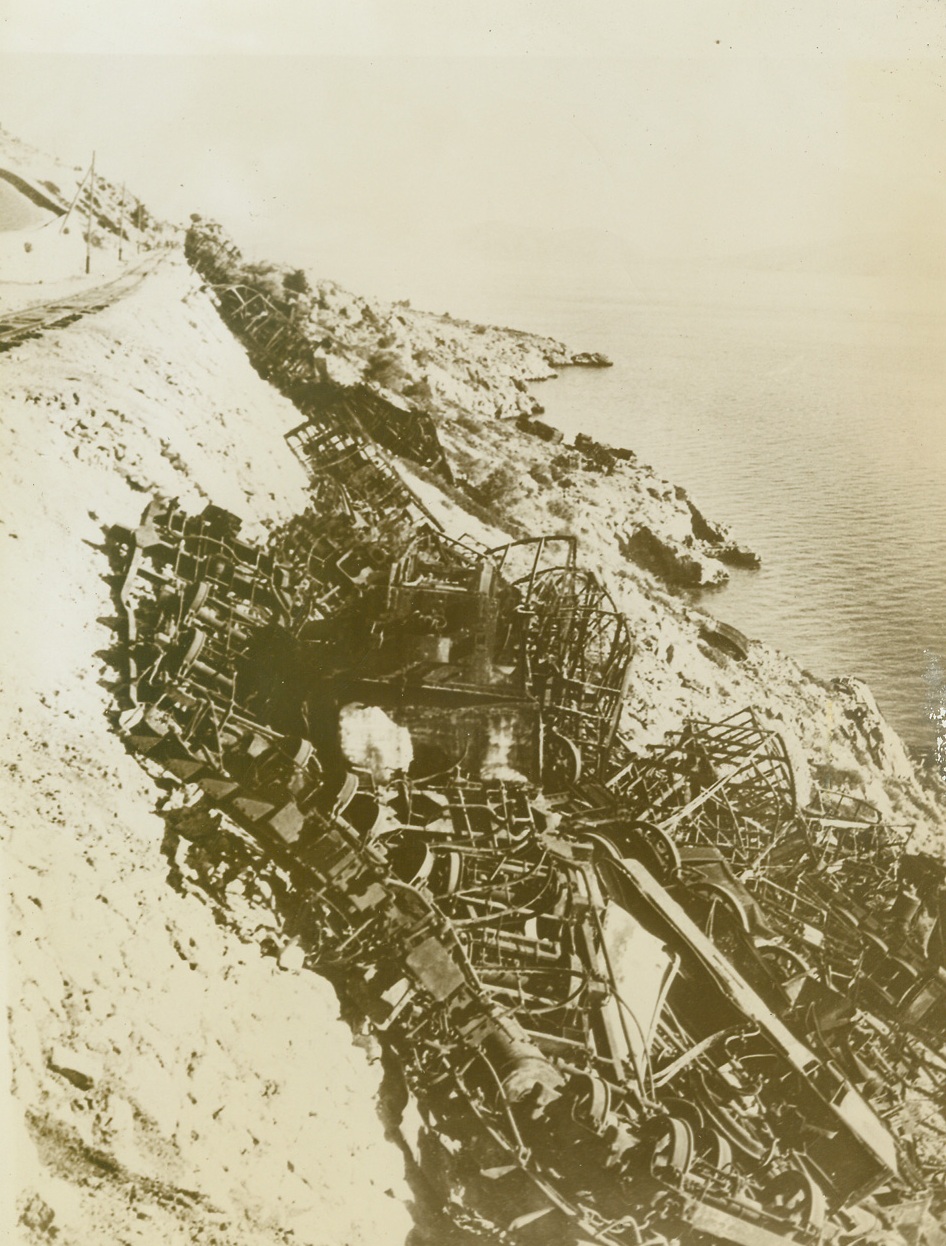
Greek Rolling Stock Destroyed by Nazis, 1/1/1945. GREECE -- Before the Germans were driven out of Greece by Allied troops they used savage demolition measures to destroy the usefulness of Greece's transportation facilities. Virtually all rolling stock in Greece was destroyed. Here trains that once connected Athens to Corinth are heaps of twisted wreckage. Credit Line OWI Photo from ACME;
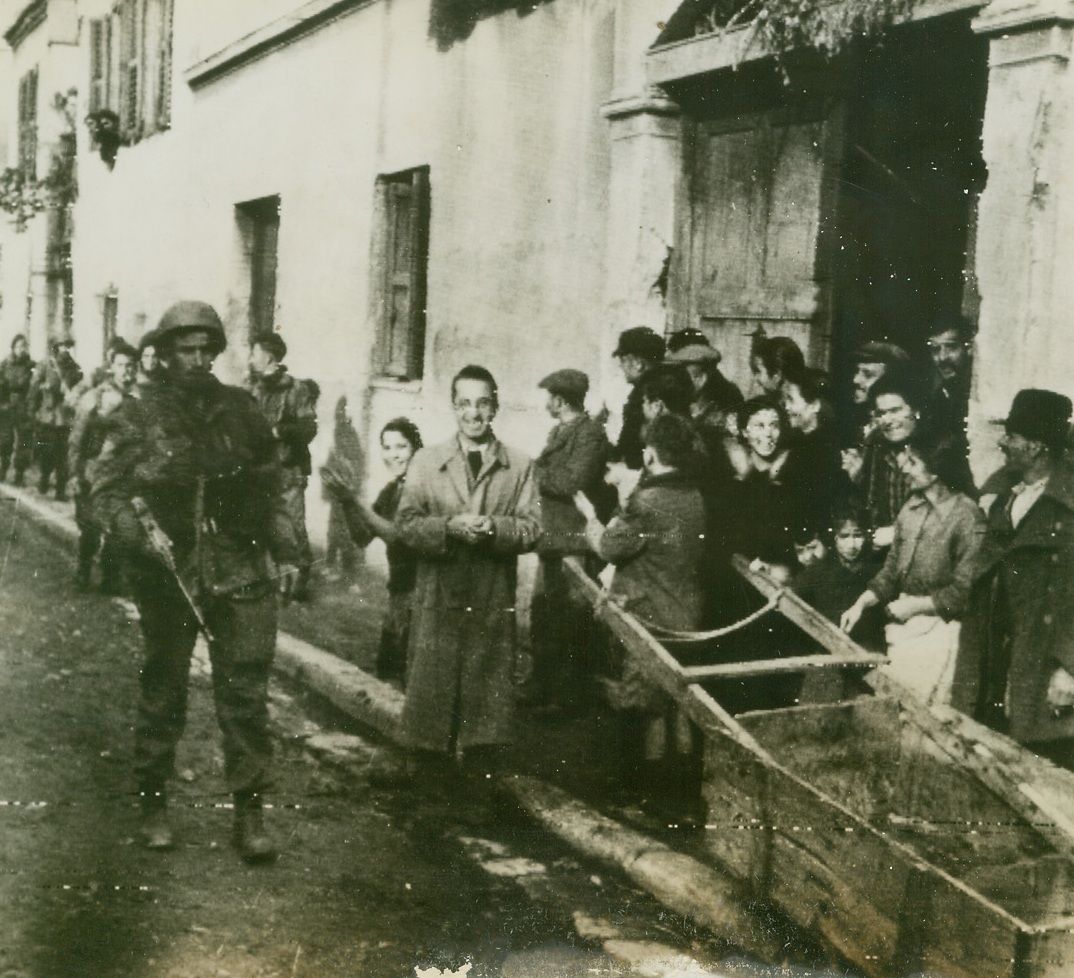
Greeks Applaud British Paratroops, 1/1/1945. ATHENS, GREECE -- According to the British caption accompanying this photo, Greek civilians smile and applaud as British paratroopers move in on the gas works at Athens on Christmas Eve. Credit (British Official Photo Via OWI - ACME);
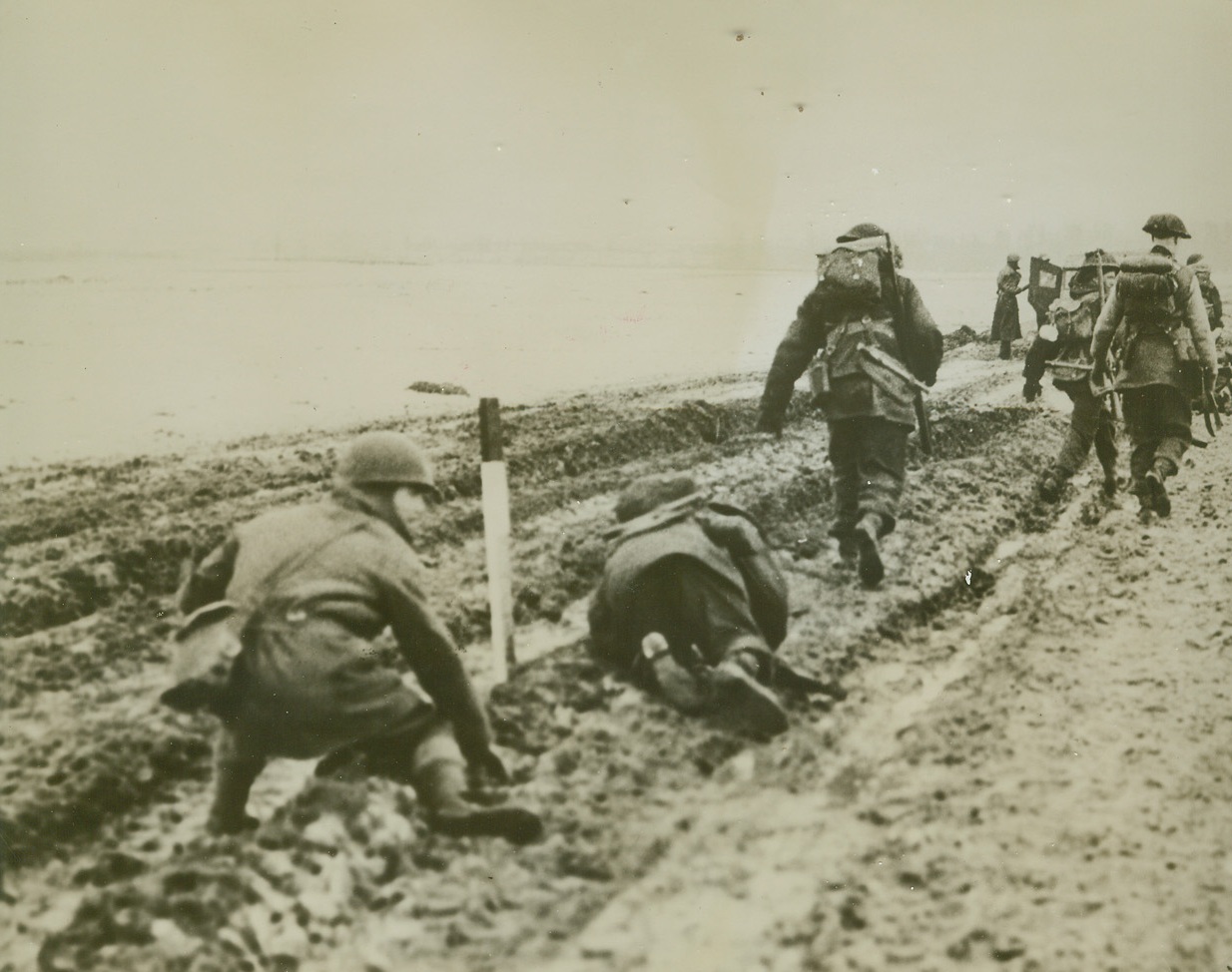
British Troops Advance Despite Weather, 1/26/1945. GERMANY -- British infantry troops fling themselves on the rutted ground, as German mortar fire whizzes by during the British advance from the German border village of Tuddern. Credit (British Official Photo from ACME);
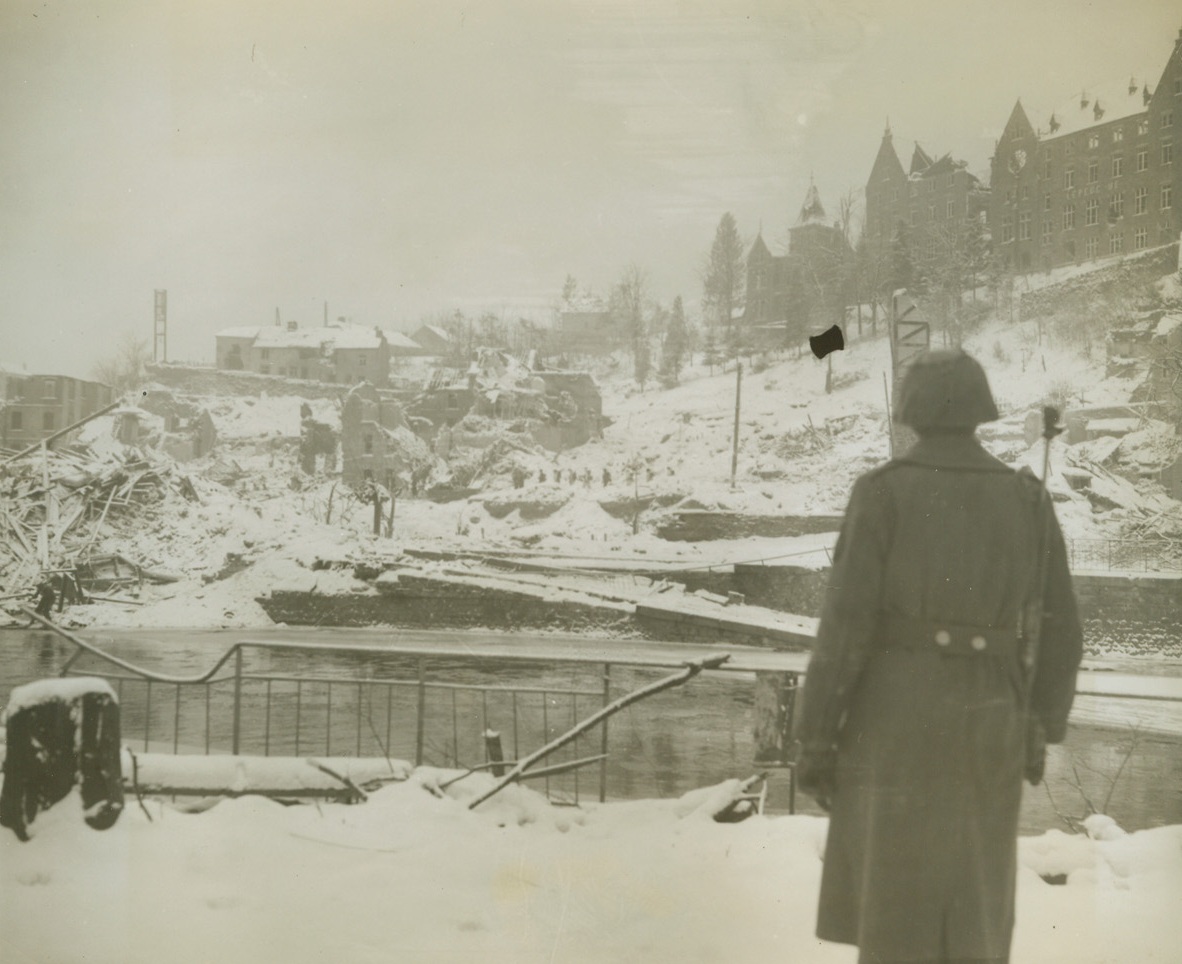
Watch Yanks Head for Nazis, 1/19/1945. Belgium – An American solider watches his comrades, barely discernable against the snow covered town of La Roche across the river, head for the hills in hot pursuit of the Nazis who had been forced to retreat. Photo by Acme Photographer, Harold Siegman, for the War Picture PoolCredit – WP- (Acme);
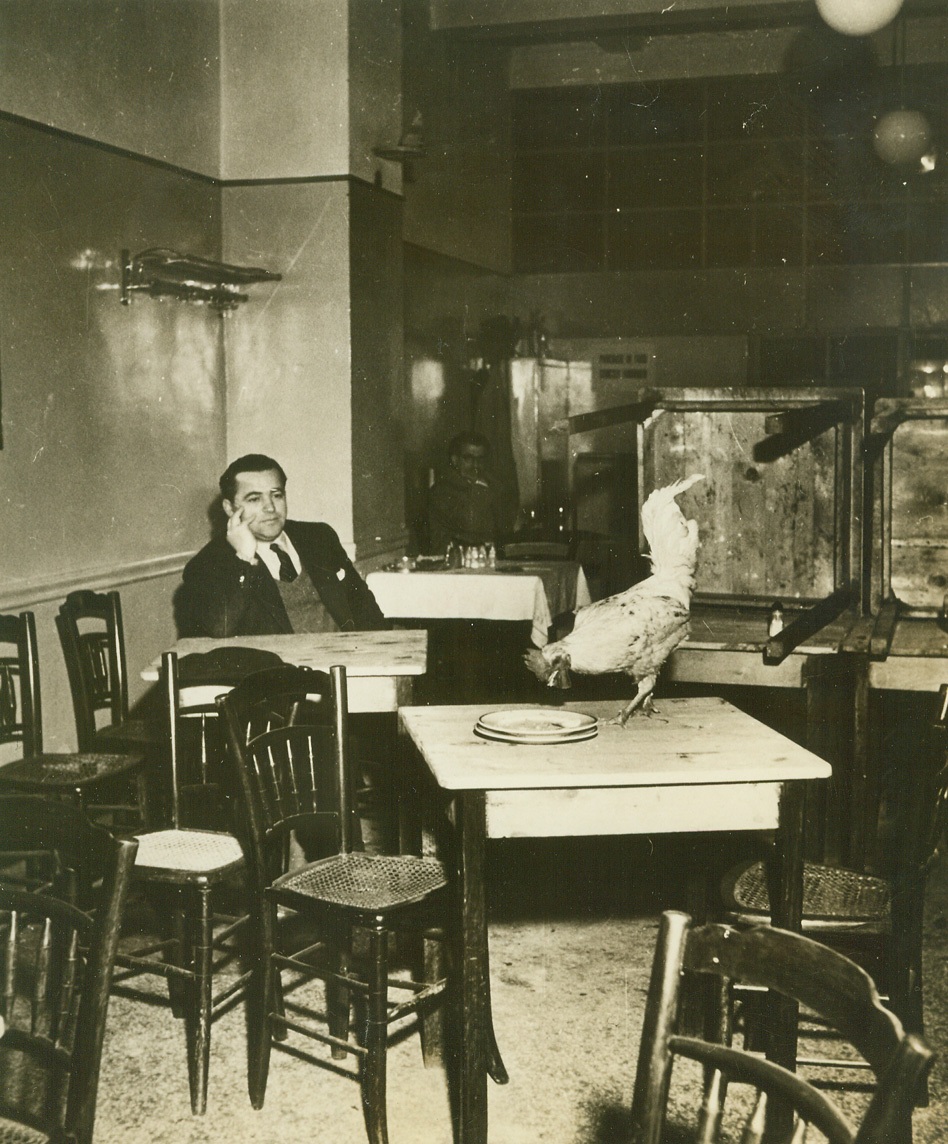
Where Greek Politics are Decided, 1/20/1945. ATHENS, GREECE – Athens’ Grand Bretagne Hotel, where all the important discussions between Winston Churchill and the Green ELAS organization have taken place, has felt the full force of the war just as much as other parts of the Greek capital. The hotel owner has worked under the most difficult conditions to keep the place running, and even now, guests must, of necessity, contend with lack of heat and water, and only the simplest of food, if any. Here, Vasili owner of the restaurant in the hotel, sits forlornly at one of the bare tables and watches a chicken, very much alive, peck at crumbs on a nearby table. Vasili intended the chick to be served to his guest, but he had neither fire nor water with which to cook it.Credit (Acme) (WP);
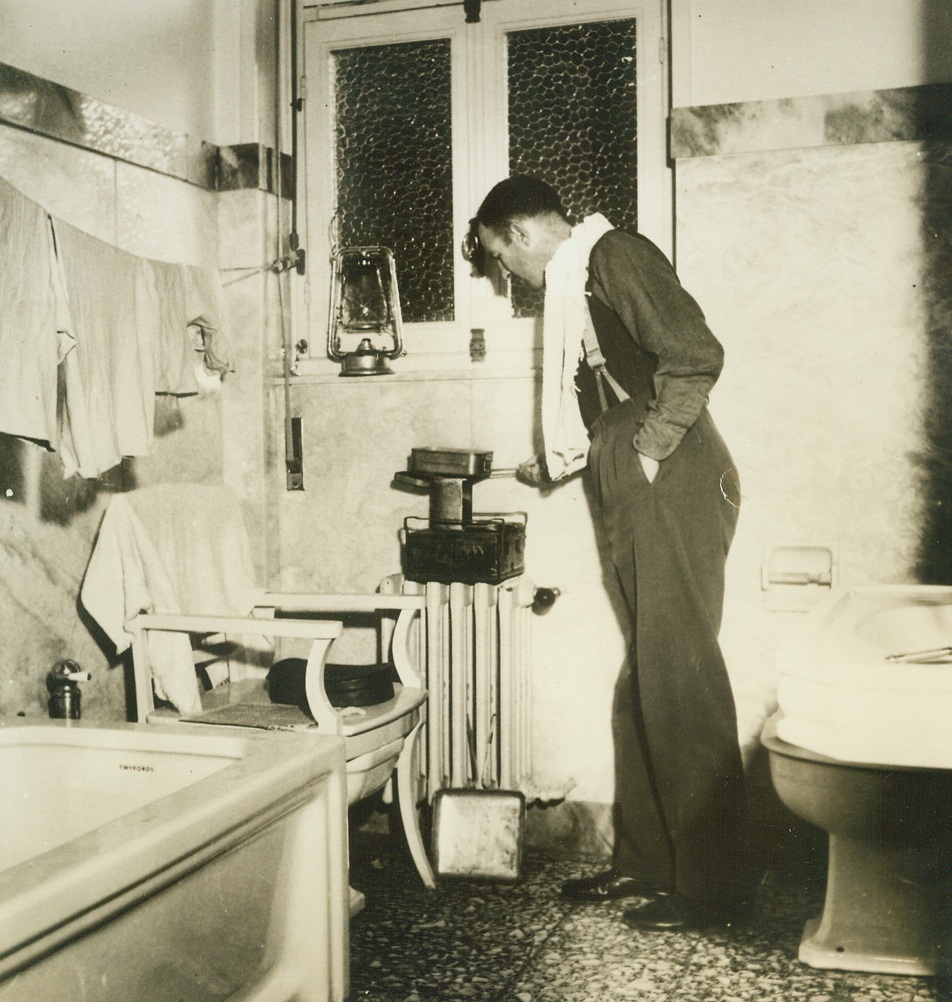
No Title. 1/20/1945. ATHENS, GREECE – Athens’ Grand Bretagne Hotel, where all the important discussions between Winston Churchill and the Green ELAS organization have taken place, has felt the full force of the war just as much as other parts of the Greek capital. The hotel owner has worked under the most difficult conditions to keep the place running, and even now, guests must, of necessity, contend with lack of heat and water, and only the simplest of food, if any. Here, Capt. Robert Gilmore, of New heats a little of the rationed water for shaving. He uses his own portable stove, and the lantern on the window sill provides the light for the bathroom.Credit (Acme) (WP)
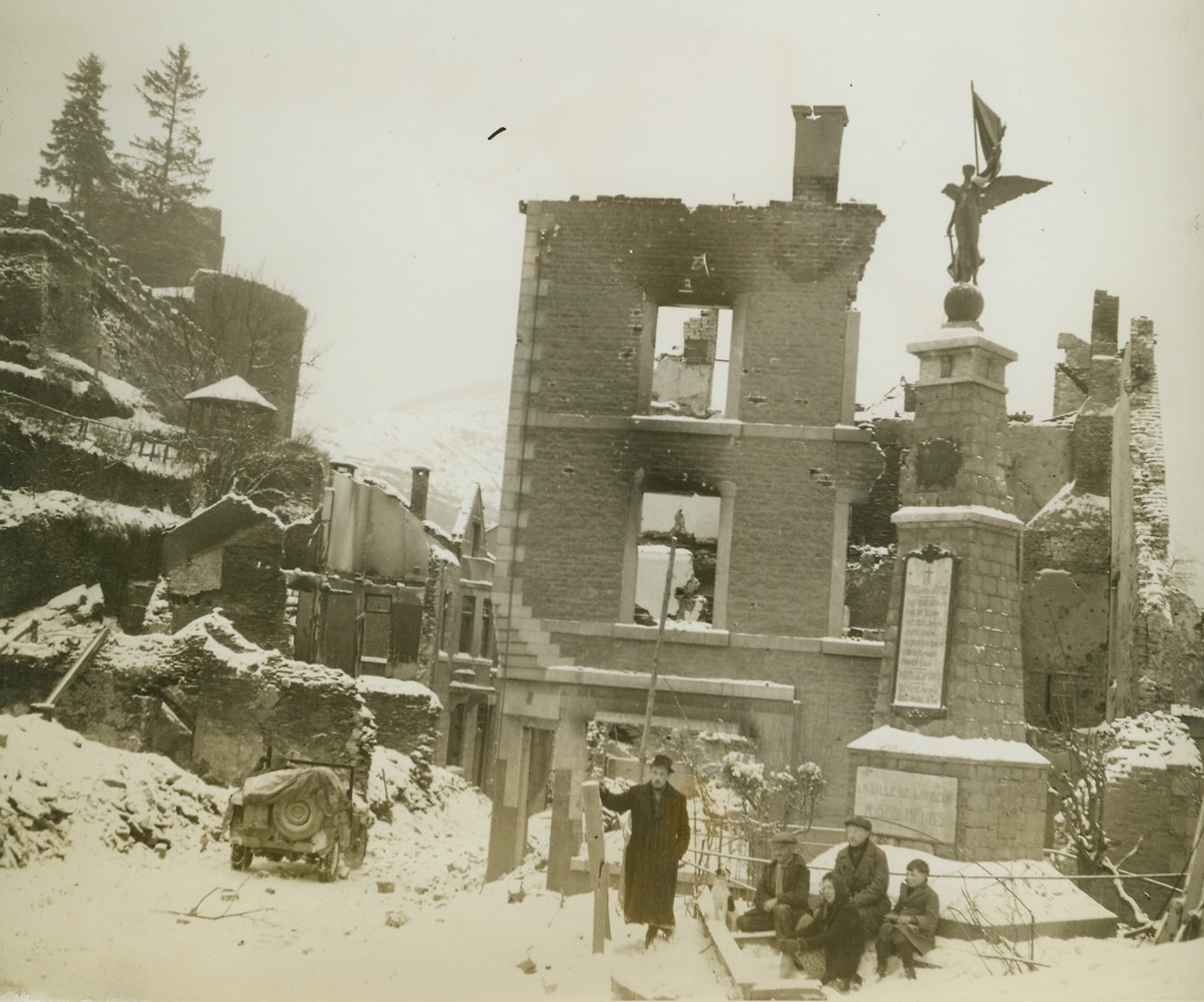
Victory Looks Down on Beaten La Roche, 1/19/1945. BELGIUM – Civilians of the Belgian town of La Roche stand beneath the winged victory symbol, memorial of World War I, against a background of destruction caused by battles in this world-wide struggle. Residents of city had returned to their homes after Yanks had forced Nazis to retreat to hills. Photo by Acme photographer, Harold Siegman, for the War Picture Pool.Credit -WP- (Acme);
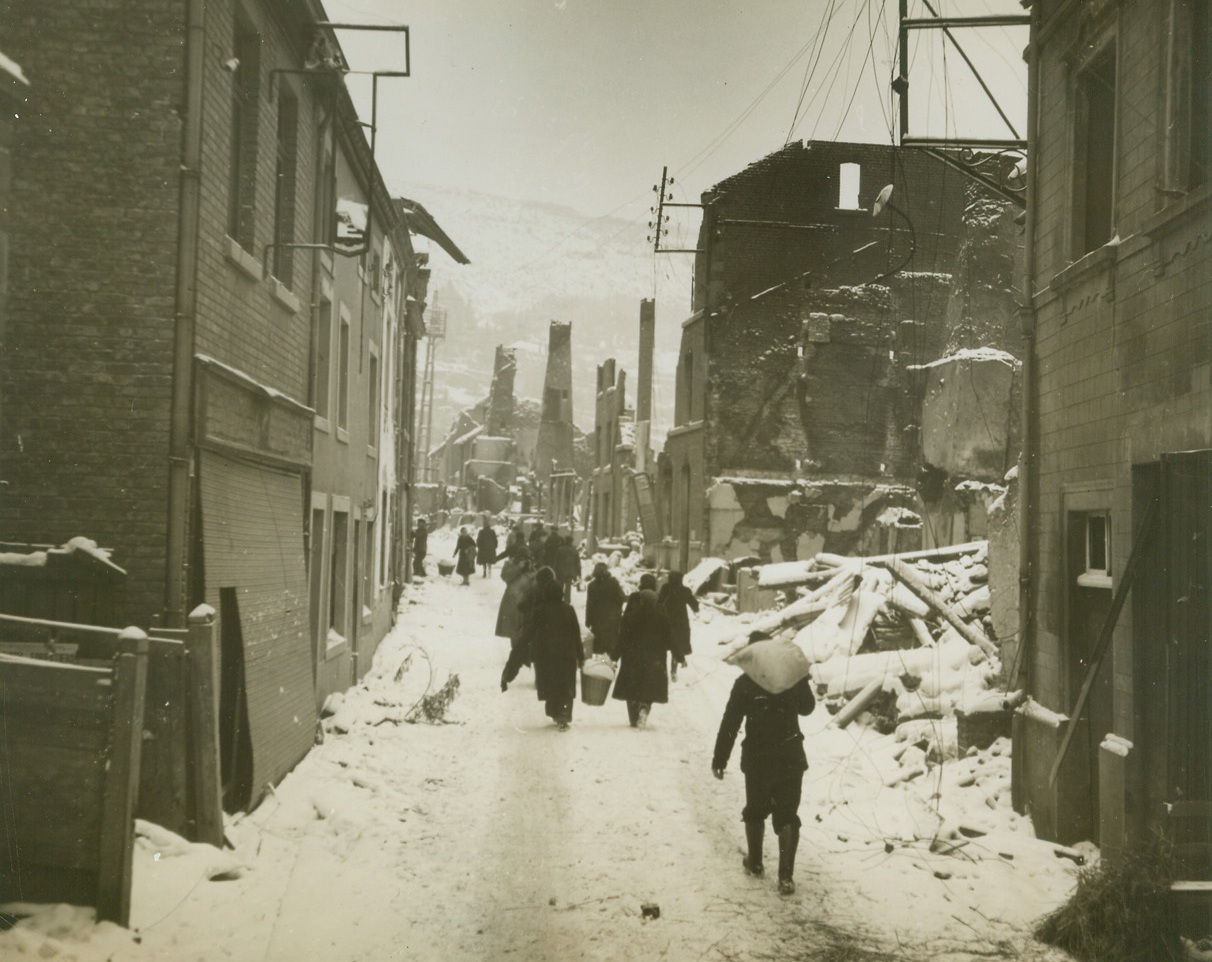
Home Again, 1/19/1945. BELGIUM – Driven into the hills when the Nazis invaded their town, residents of La Roche came home after Americans had forced enemy into retreat. Photo by Acme Photographer, Harold Siegman, for the War Picture Pool.Credit – WP- (Acme);
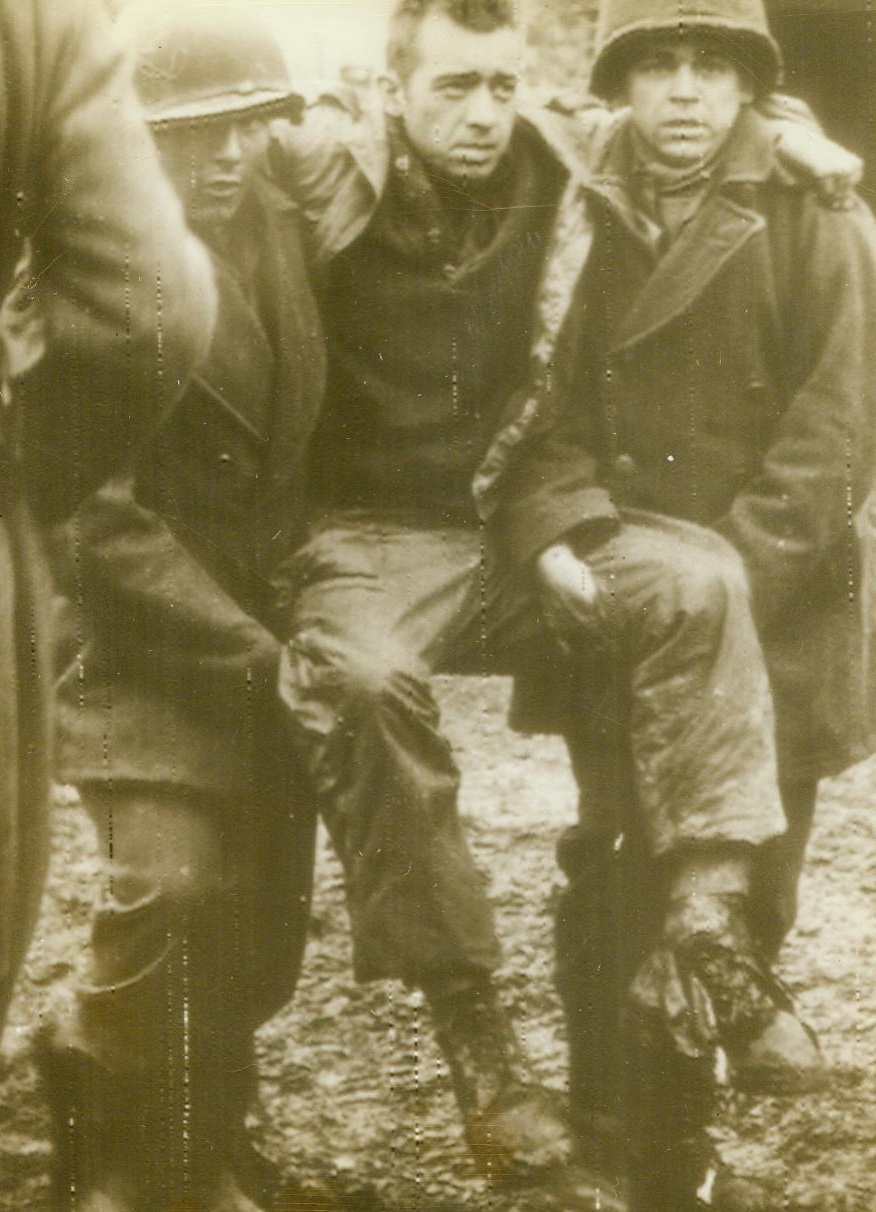
Wounded Yank Prisoner #1, 1/3/1945. Western Front – According to German caption on this photo radioed from Stockholm today, American prisoners are carrying a wounded comrade to a dressing station during the “Big German Winter Offensive at the West Front.” Credit Line (ACME RADIOPHOTO) 1/3/45;
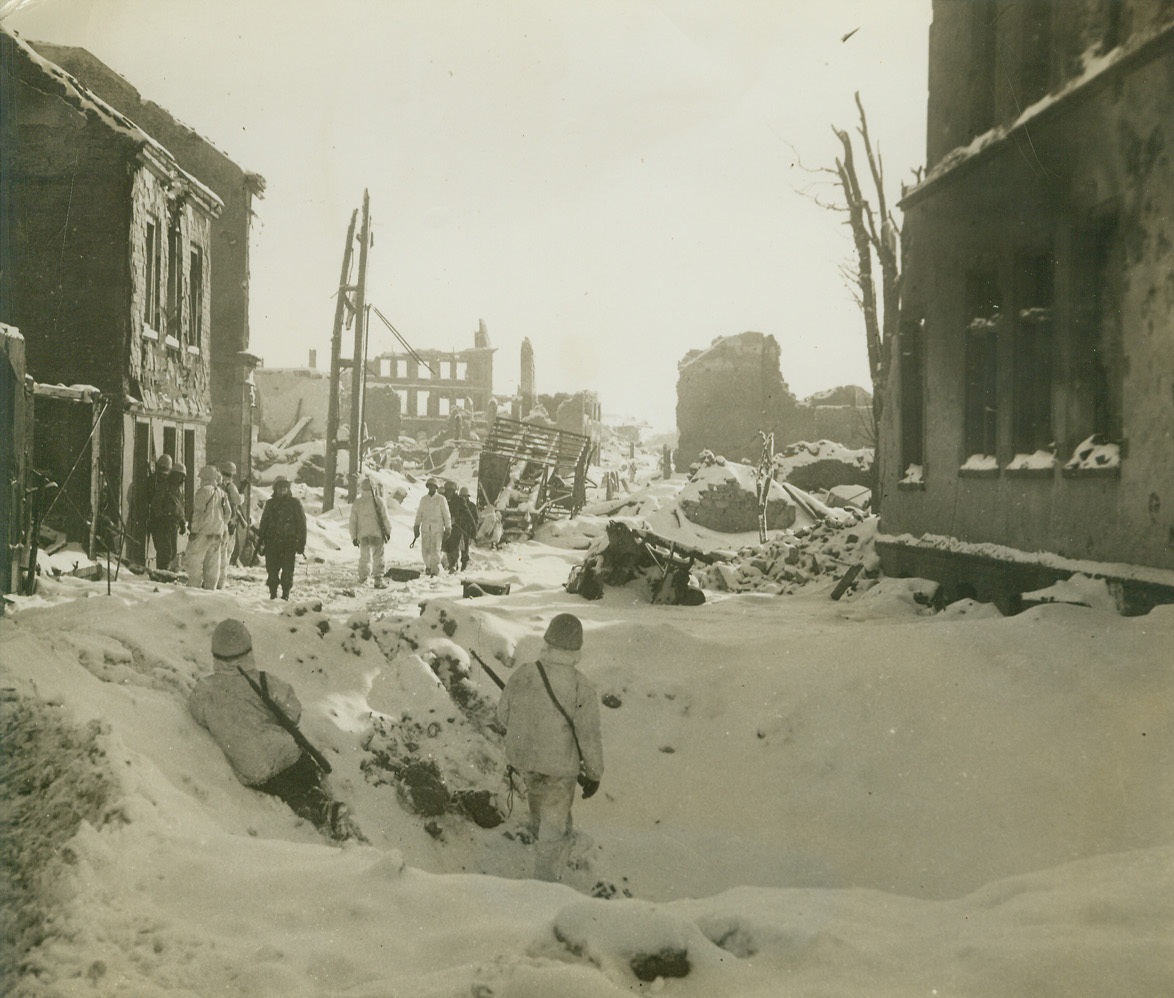
St. Vith Street Scene, 1/30/1945. BELGIUM – Two U.S. First Army soldiers, in snow-covered crater, cover their comrades patrolling the streets of St.Vith, Belgium, for possible enemy snipers. The city, a vital road junction in the now eliminated Belgian Bulge, was found completely ruined when re-captured from the Nazis. Skeleton homes can be seen at left and in background. Photo by Acme photographer, Harold Siegman, for the War Picture Pool. Credit – WP – (Acme);
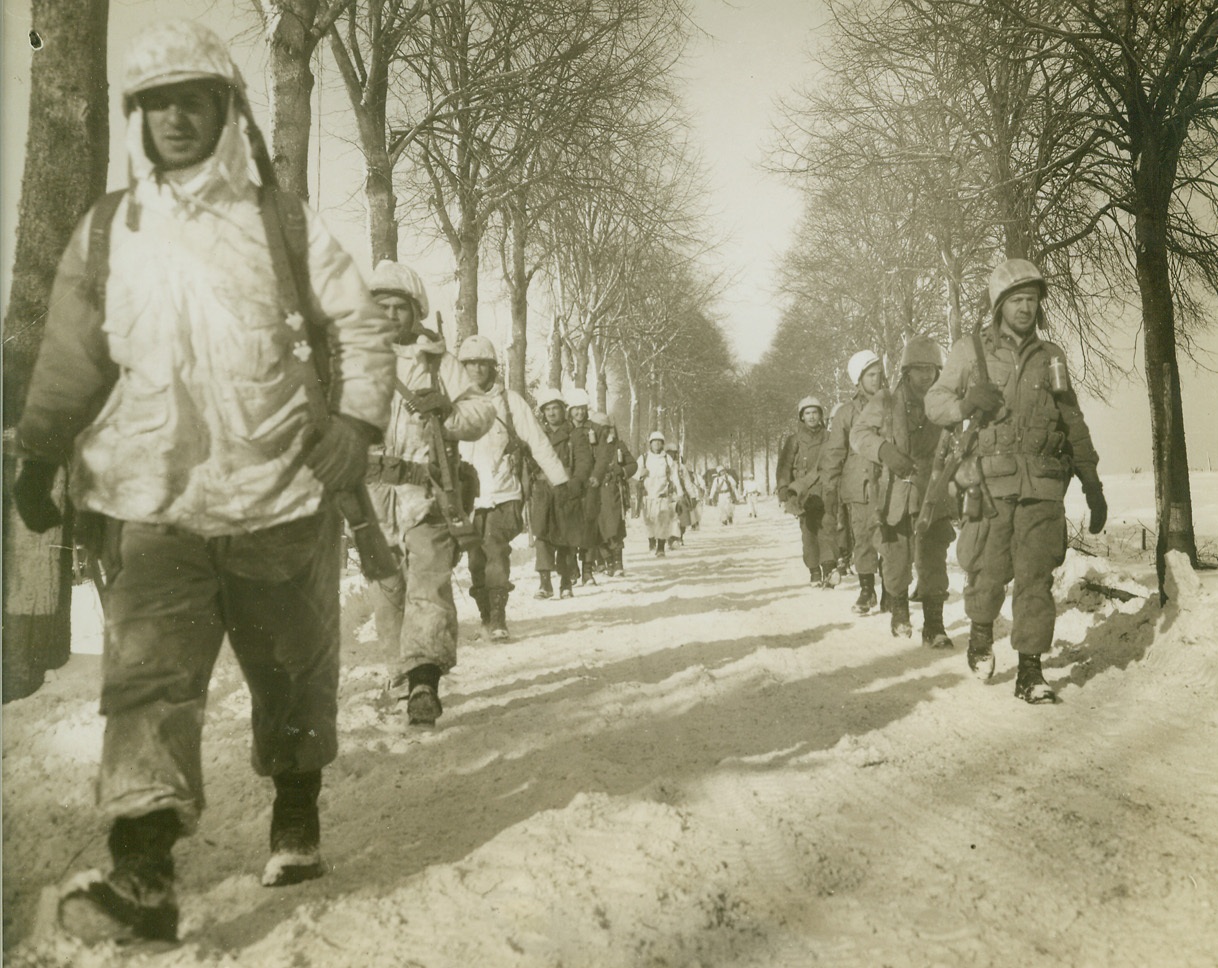
Victory March, 1/31/1945. ST. VITH, BELGIUM – Some of them wearing white camouflage clothing, American infantrymen move up on St. Vith to reinforce units that took the town. Photo by Harold Siegman, Acme photographer for the War Picture Pool. Credit Line –WP—(Acme);
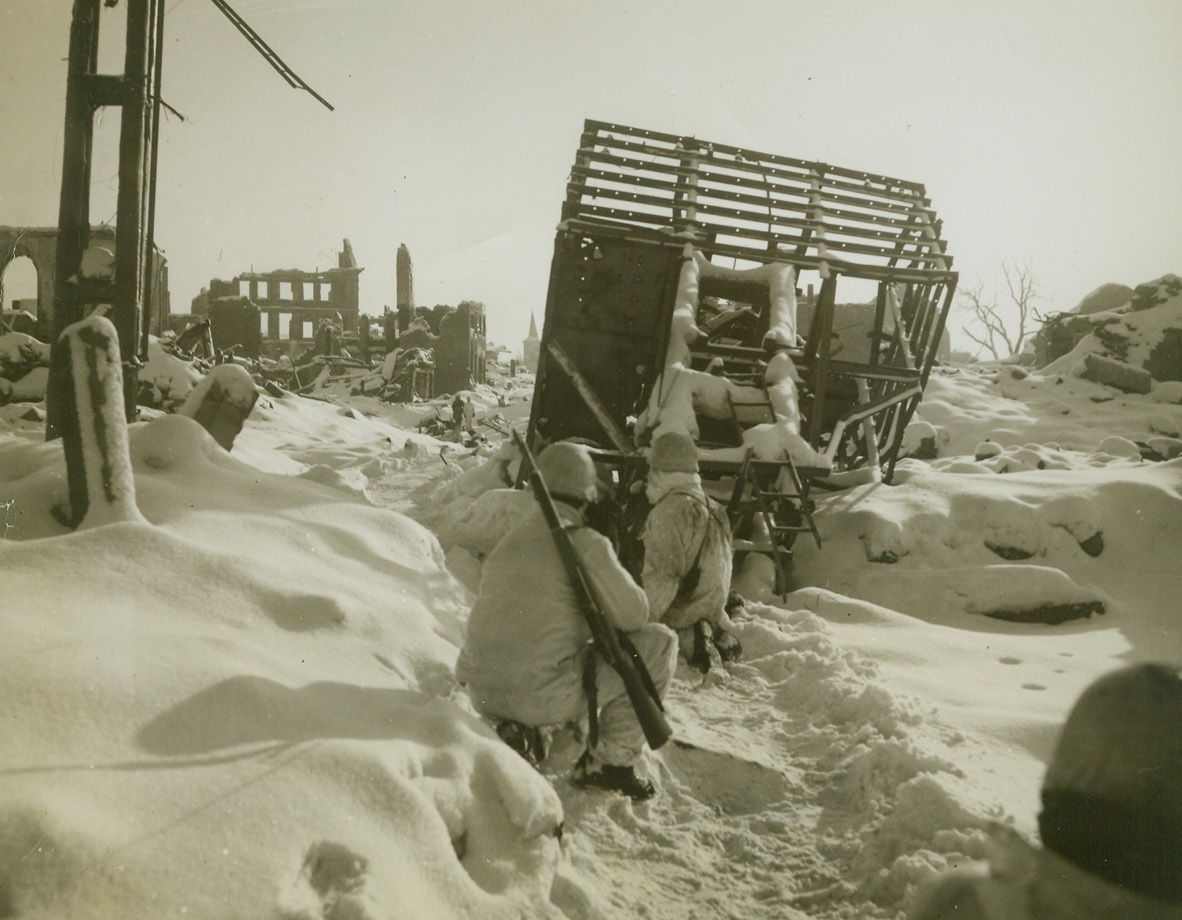
St. Vith Street Scene, 1/31/1945. ST. VITH, BELGIUM – The wreckage of buildings, blanketed by a smooth cover of new snow, obliterates this street in embattled St. Vith. White-clad infantrymen, dug in amid the debris, keep an eye peeled for snipers in the newly captured town. Photo by Harold Siegman, Acme photographer for the War Picture Pool. Credit Line – WP- (Acme);
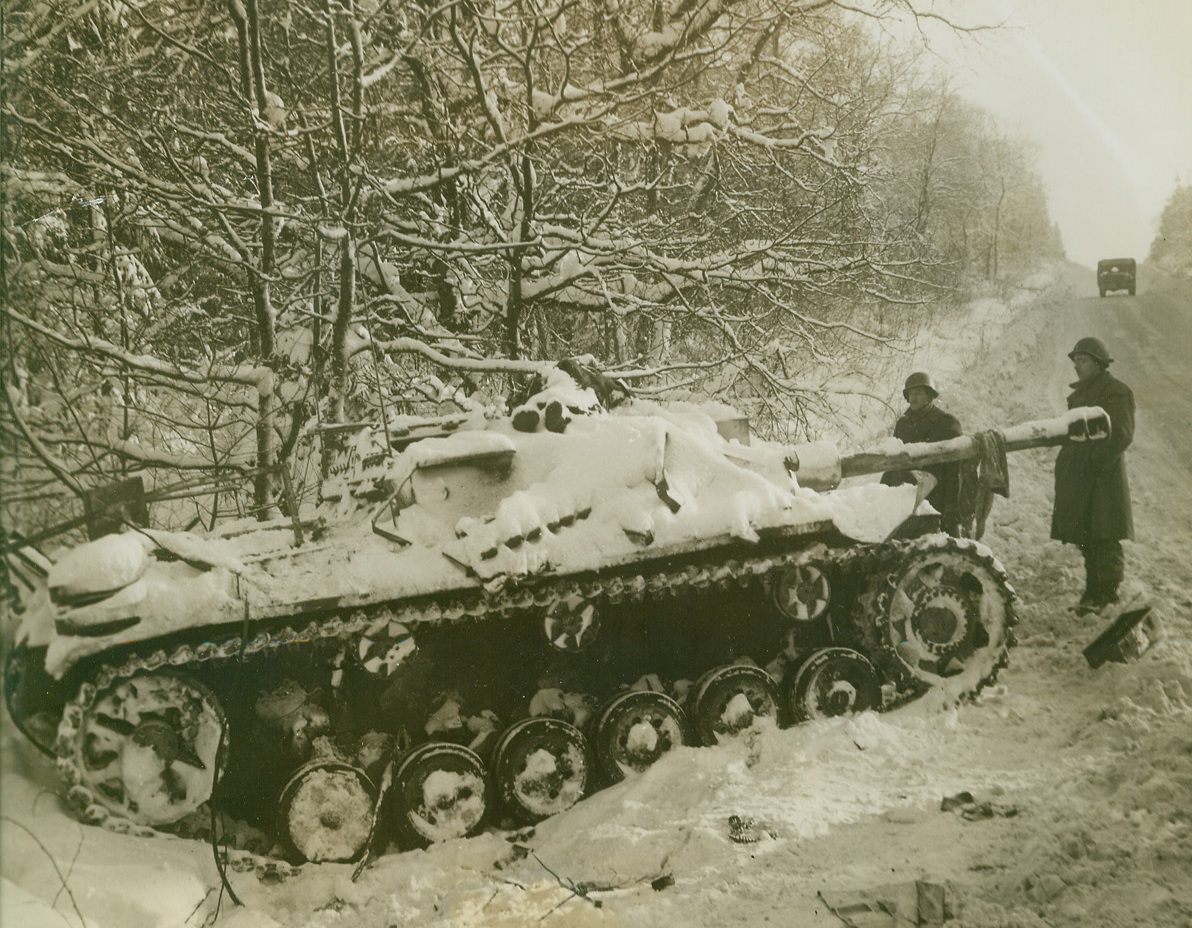
Death’s Corner, 1/31/1945. ST. VITH, BELGIUM – Death struck often and mercilessly in this embattled corner of the world, as Yank First Army infantrymen fought for possession of snowbound St. Vith. Two Americans examine a knocked-out Nazi tank, atop which a dead German lies. Photo by Harold Siegman, Acme photographer for the War Picture Pool. Credit Line –WP—(Acme);
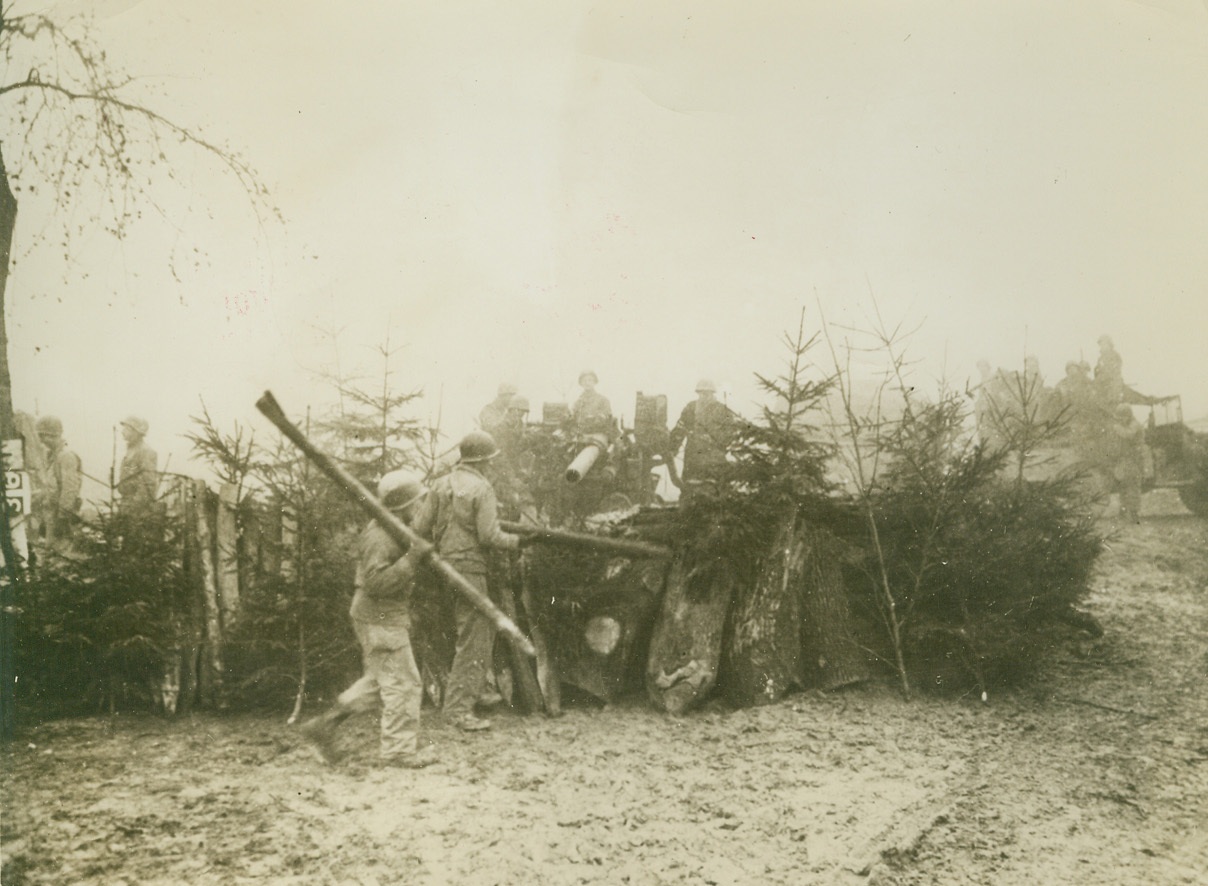
First Pictures of Meuse Offensive, 1/2/1945. WESTERN FRONT – American artillerymen setting up a road block, including Christmas trees, with a 90 mm gun in the Allied drive to stem the German advance to the Meuse River. Credit Line - WP – (Acme photo by Harold Siegman, War Pool Correspondent);
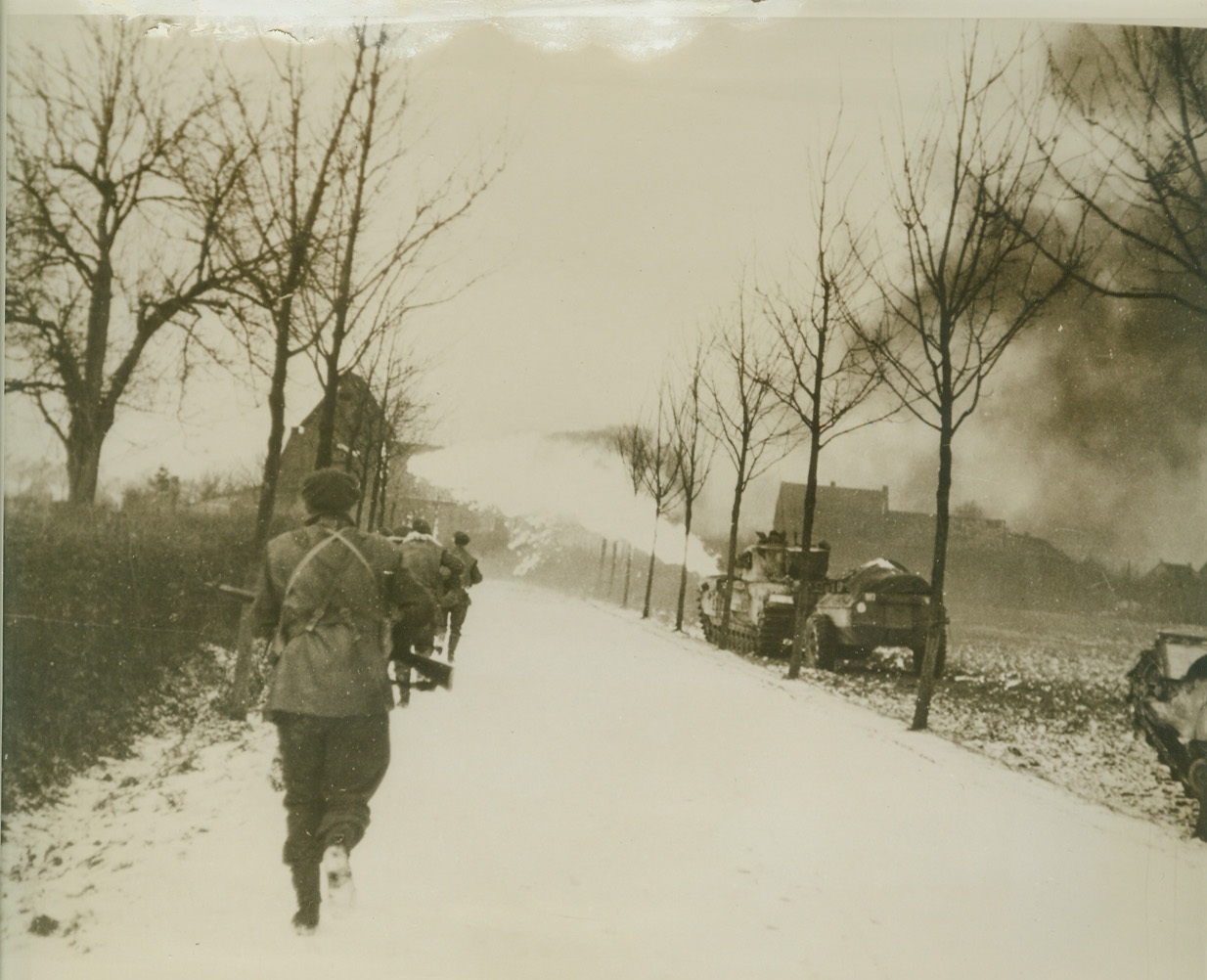
Flame-Throwers Aid British Advance, 1/30/1945. HOLLAND -- A crocodile flame-thrower fires at enemy positions as British infantrymen move along the road to St. Joost, in the Sittard battle area. Tommies faced stiff resistance before taking the village. Credit (British Official Photo from ACME);
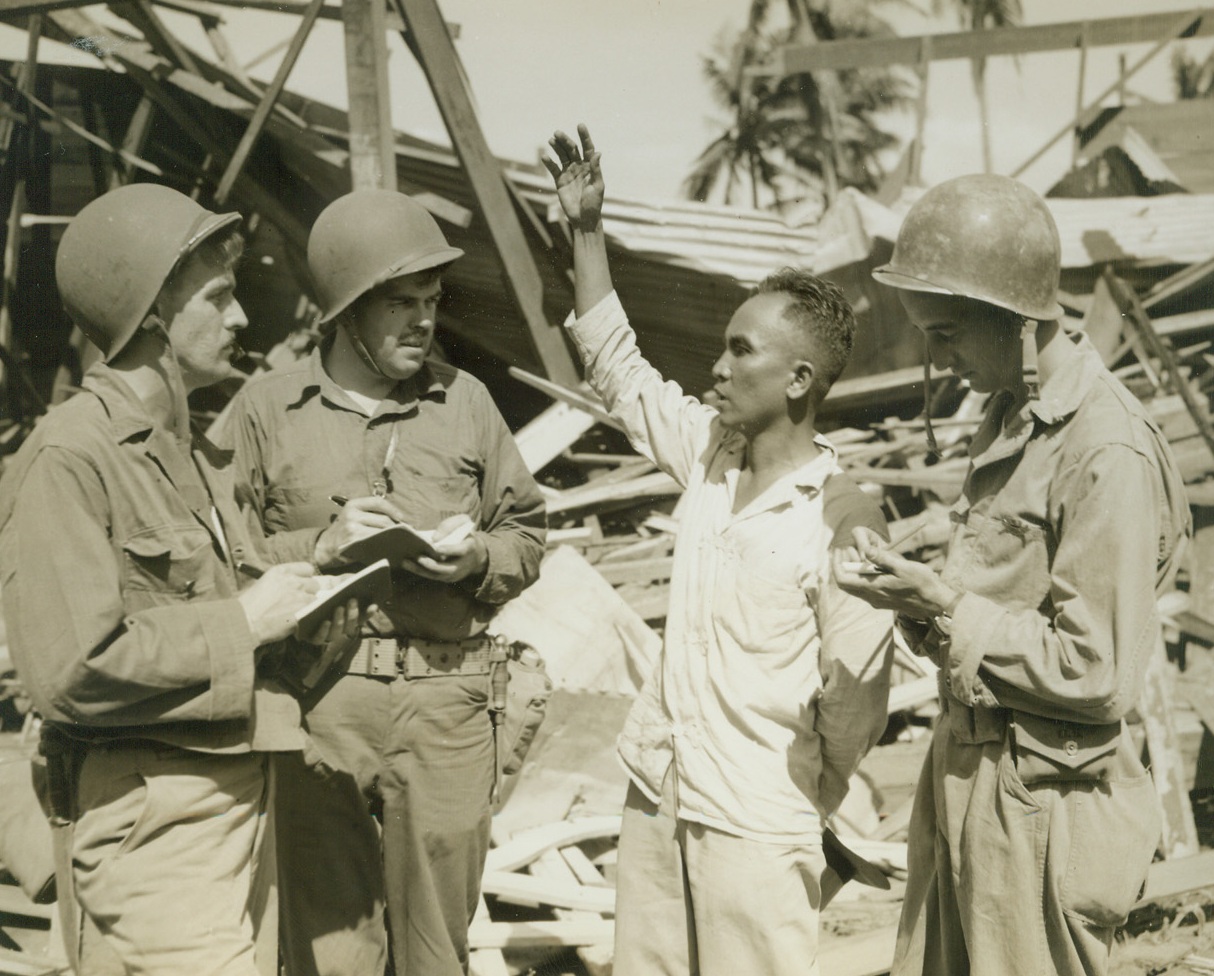
Quiz Mayor of San Fabian, 1/23/1945. Luzon – War correspondents with American forces on Luzon, stop in the shattered town of San Fabian to interview Fermin Imbuedo, former mayor of the town. Left to right, are: Dean Schedler, Associated Press; George Jones, New York Times; Mr. Imbuedo; and Francis McCarthy, United Press. Photo by ACME photographer, Stanley Troutman, for the War Picture Pool. Credit: ACME;
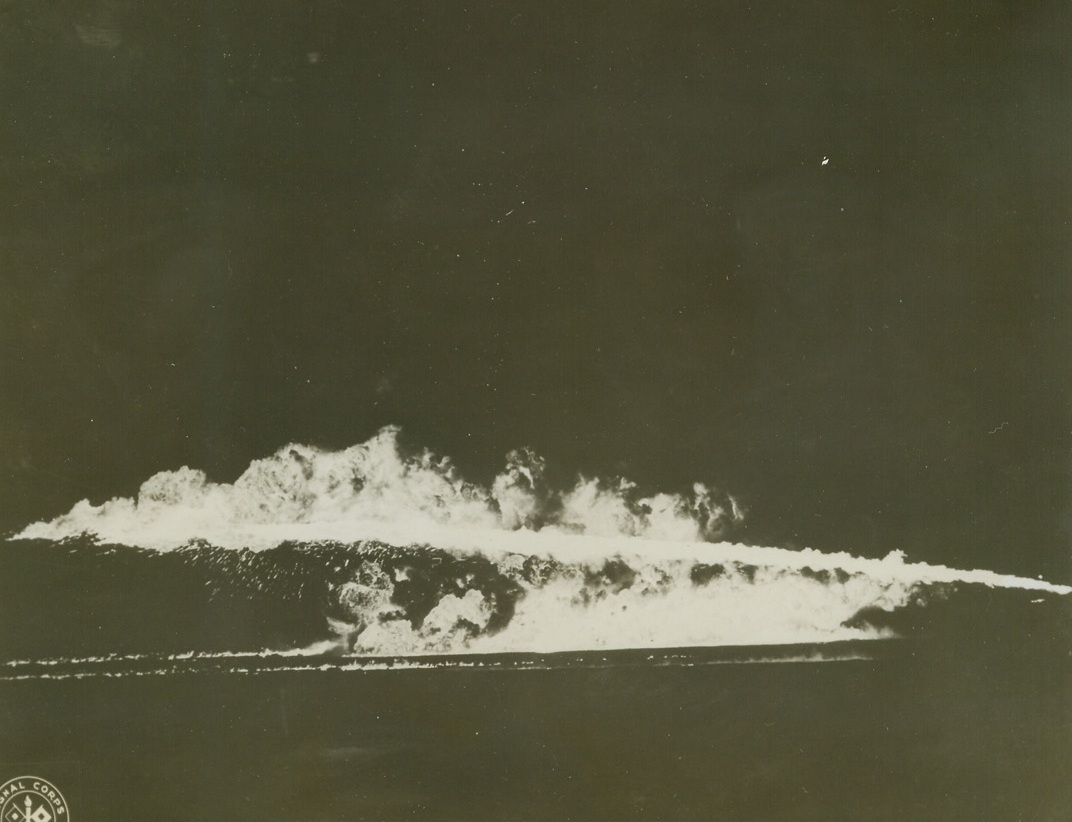
Modern Dragon, 1/24/1945. Pacific – Spouting flame like some terrible dragon, the Army’s new flamethrowing tank spews a solid stream of devastating fire in a night demonstration at a Pacific base. Developed in Lt. Gen. Robert C. Richardson’s Pacific Ocean Areas Command, the new weapon uses an oil-like substance to blanket Jap installations with flaming death. Credit: Signal Corps photo from ACME;
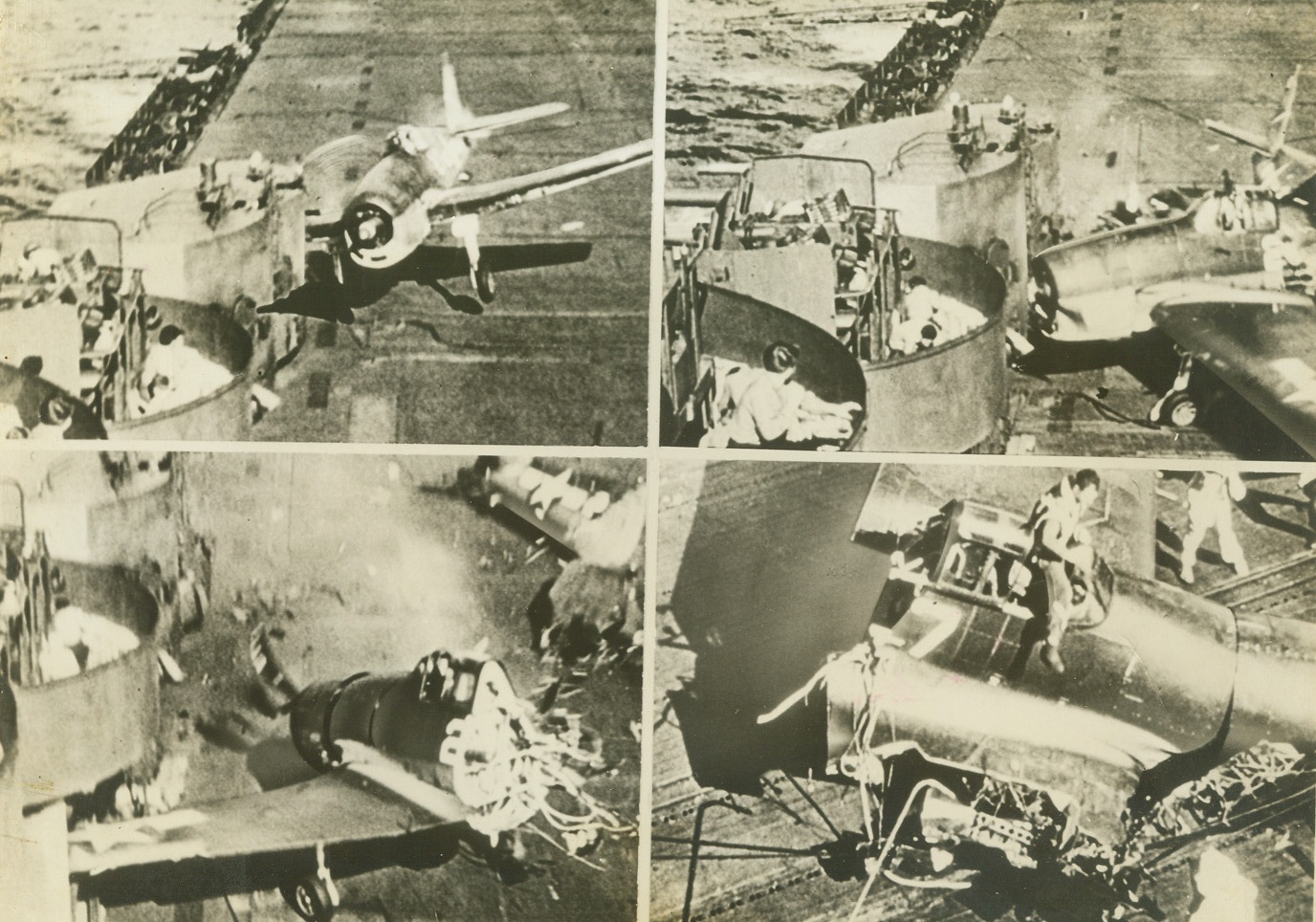
Drama Aboard the “Fighting Lady”, 1/5/1945. Pacific – This series of pictures depicts one of the most spectacular scenes from the U.S. Navy documentary film, “The Fighting Lady,” distributed by 20th Century-Fox. Action occurred when a Navy pilot came in for a landing on his carrier’s flight deck – plane out of control. The plane, upper left, prop whirling, swerves into the island at the side of the carrier. As the right wing smashes into the tower, the plane swings around, telescoping the nose and splitting the fuselage. At lower left, the plane has been brought to a stop after reversing its field. Men in gun turret bend low to lessen shock of concussion. Wires trail from front end of fuselage but the cockpit is intact. In last photo, lower right, the pilot, miraculously unhurt, climbs out of his seat. Credit: U.S. Navy photo from ACME;
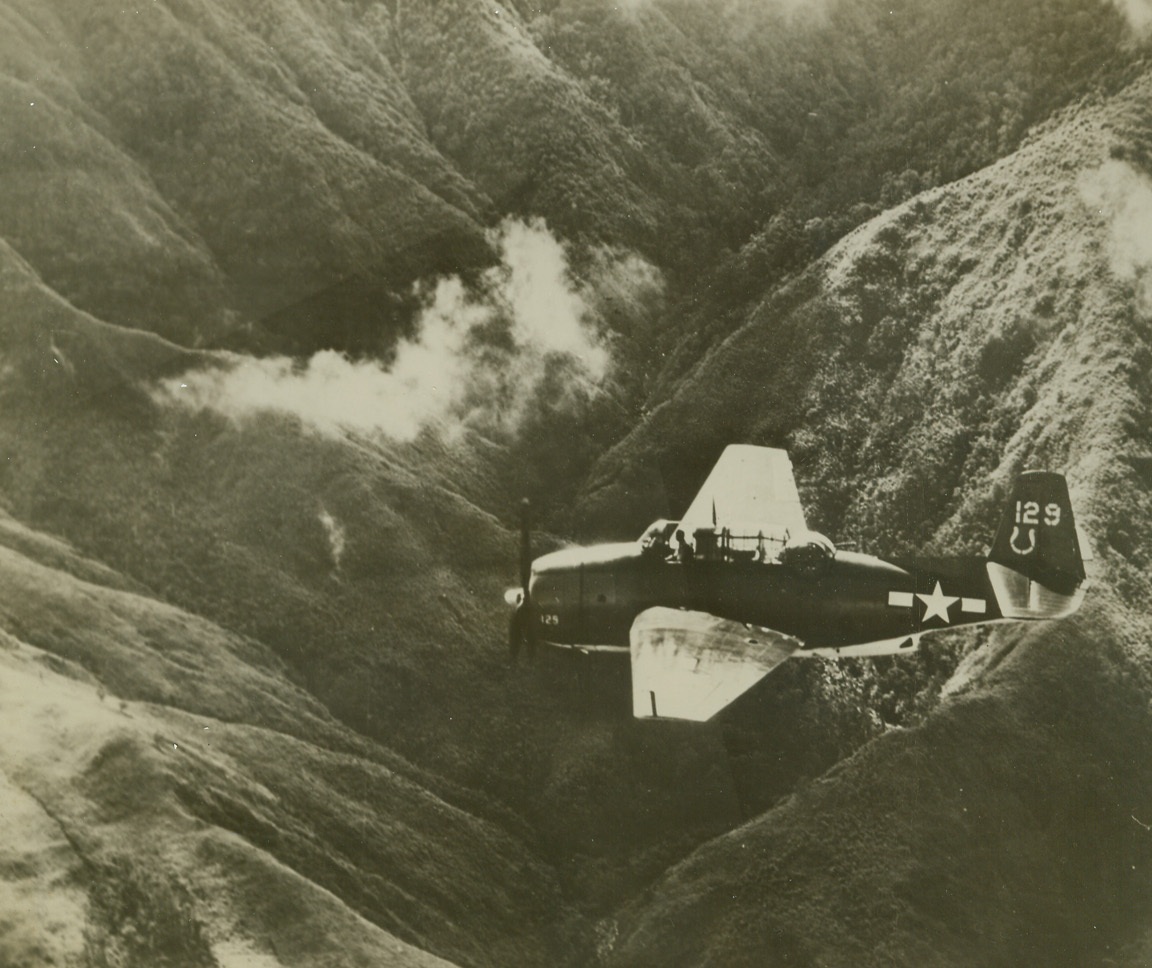
Strike at Japs on Luzon, 1/12/1945. Phillipines – Snapped against the sombre background of a deep crevasse in the mountains of Luzon, a Navy General motors avenger torpedo bomber roars on its course during an aerial strike at Jap shipping in the Phillipines.Credit (U.S. Navy photo from ACME);
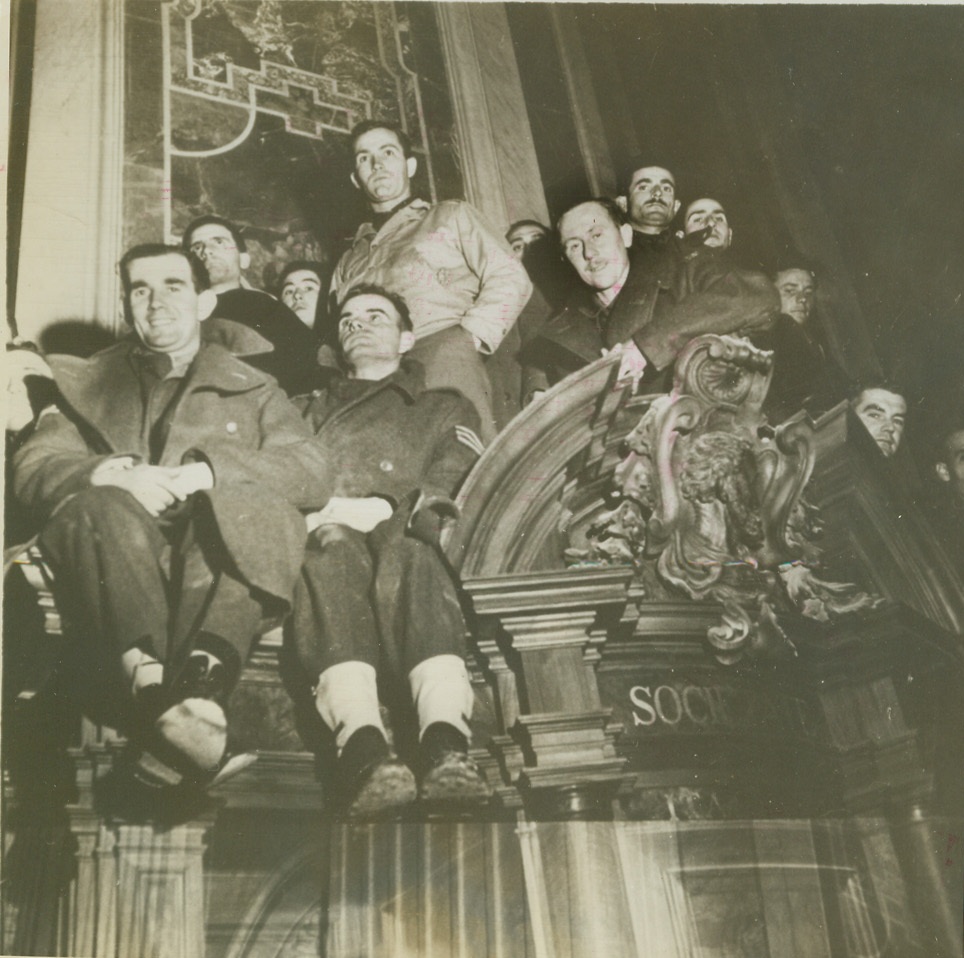
GI's At Midnight Mass in Rome, 1/6/1945. ROME -- American soldiers find a point of vantage as they attended midnight mass services, Christmas Eve, in St. Peters. Pope Pius officiated. Credit-WP-(ACME);
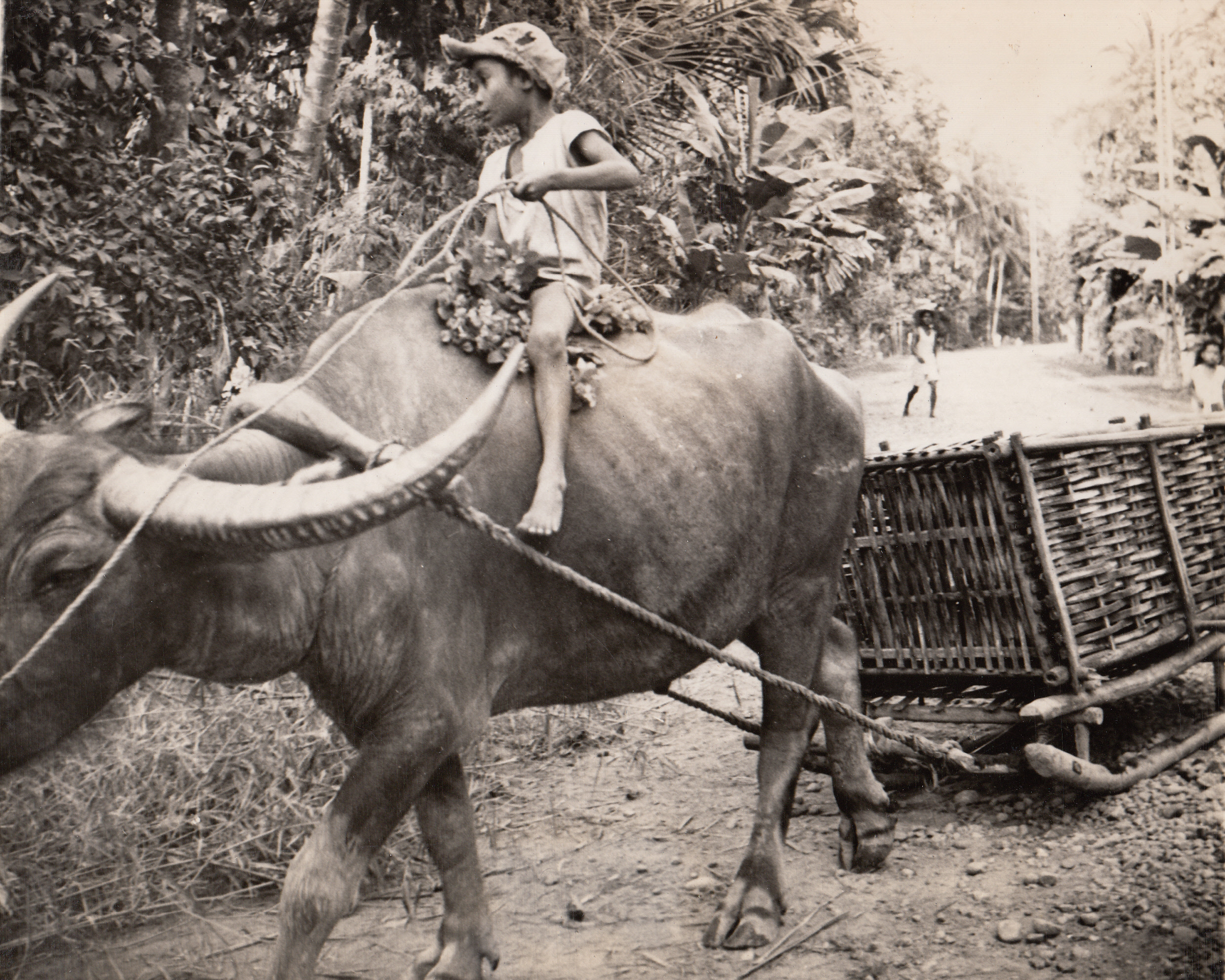
Travels in Style, 1/23/1945. Luzon – Filipino lad sits astride a caribou, domesticated animal used on Luzon and all the Philippine Islands for transportation and hauling purposes.;
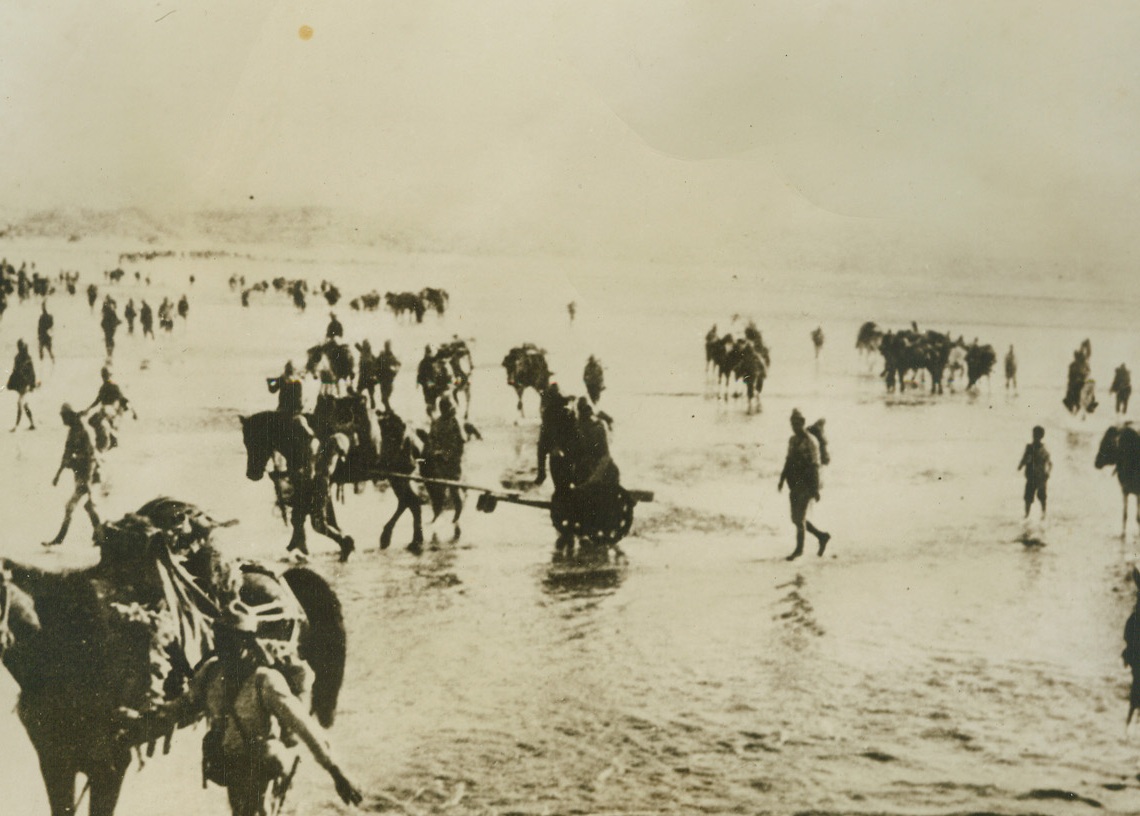
Japs on the Move, 1/24/1945. Somewhere in China – Leading horses laden with equipment, Japanese troops cross a river somewhere in China. According to the German caption on this photo, which was obtained through a neutral source.Credit Line (ACME);
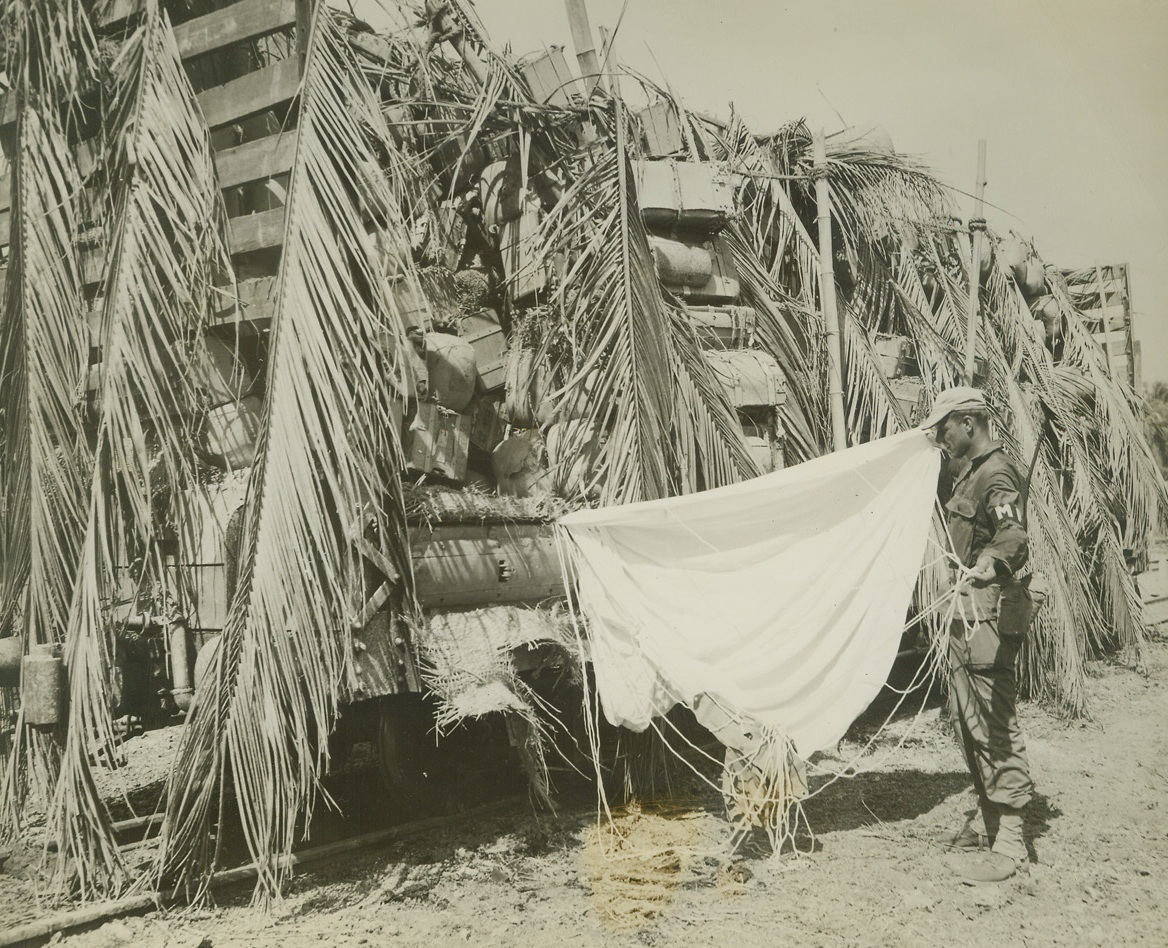
No Title. 1/23/1945. Sgt. Paul P. Pogkoski examines a Japanese parachute. The chute was one of many found in the box car by the Yanks. Photo by Stanley Troutman, ACME photographer for the War Picture Pool.Credit Line -WP- (ACME);
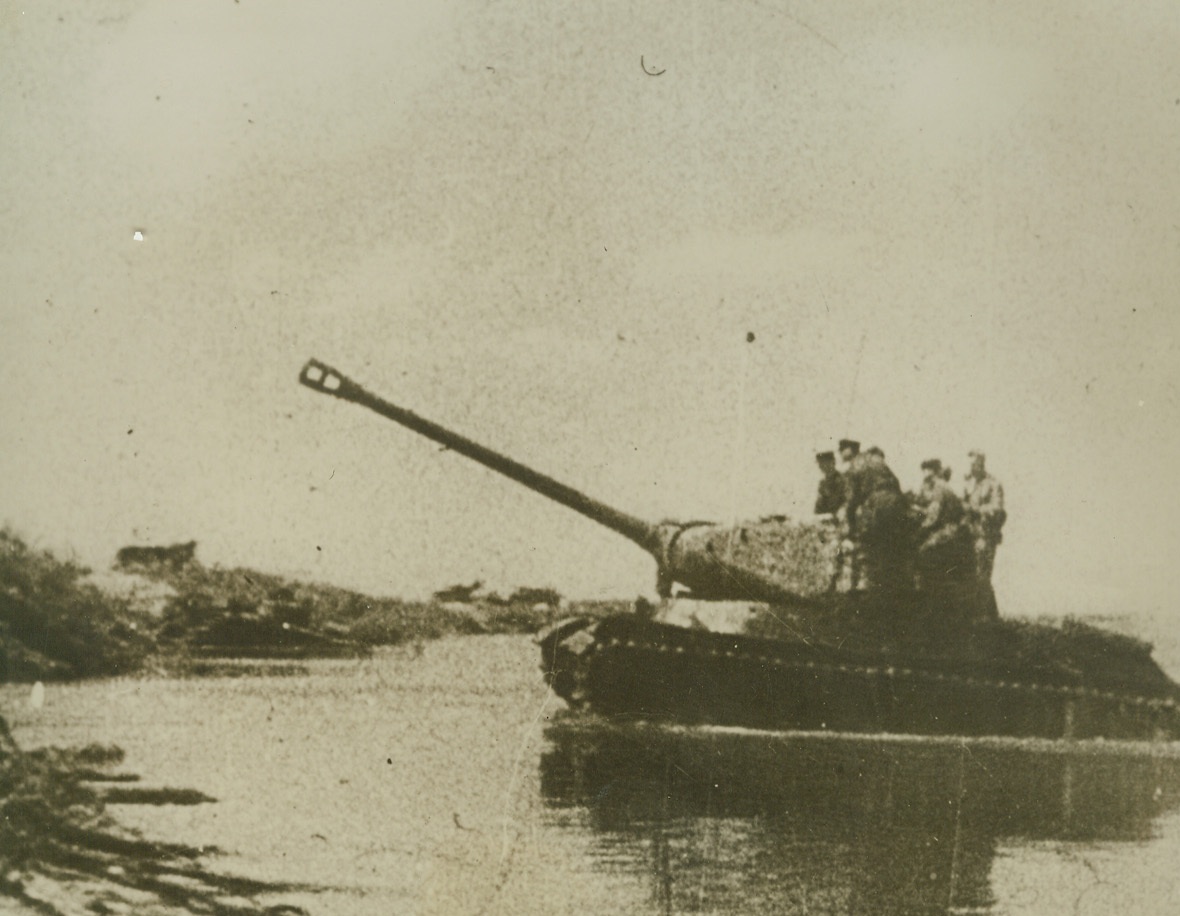
New Stalin Tank, 1/24/1945. Russian soldiers stand on the turret of the new Stalin Tank as it fords a river during a drive on the Eastern Front. According to German sources the tank weighs approximately 50 tons, has a 122mm. gun, three machine guns and armor roughly 4 inches thick.Credit: British Official Photo from ACME;
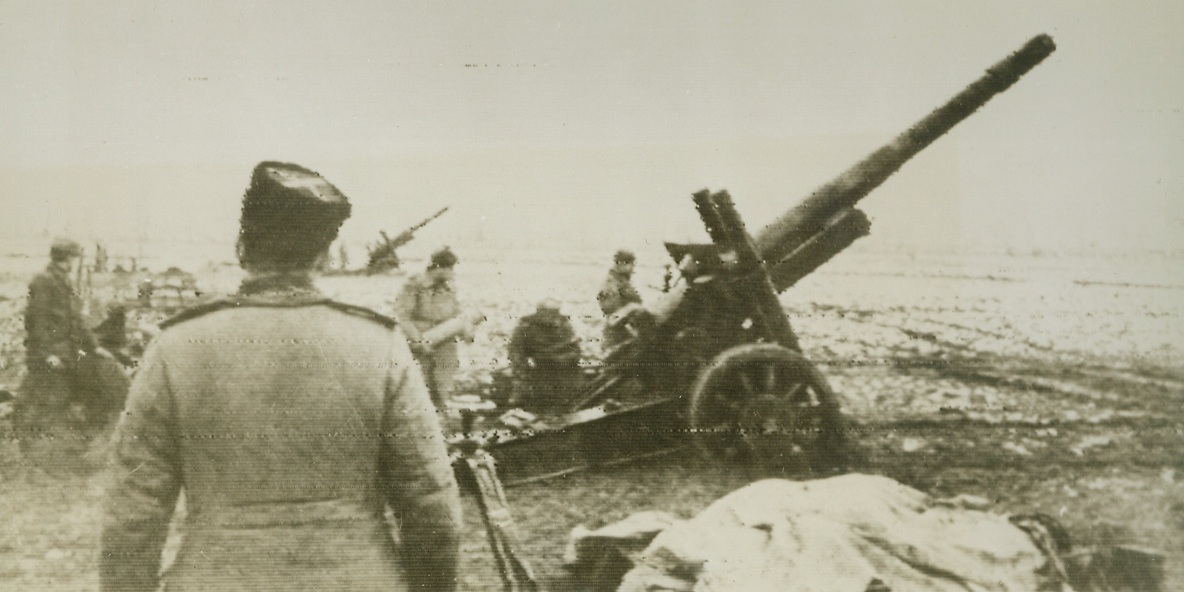
Russians Are 137 Miles from Berlin, 1/23/1945. CZECHOSLOVAKIA—Lieutenant Durandin’s battery of long-range guns, which helped to rout the Germans at Stalingrad, now have the Nazis on the run as they fire at German fortifications in Czechoslovakia. Recent reports from the front indicate that Soviet forces are only 137 miles from Berlin.Credit: ACME;
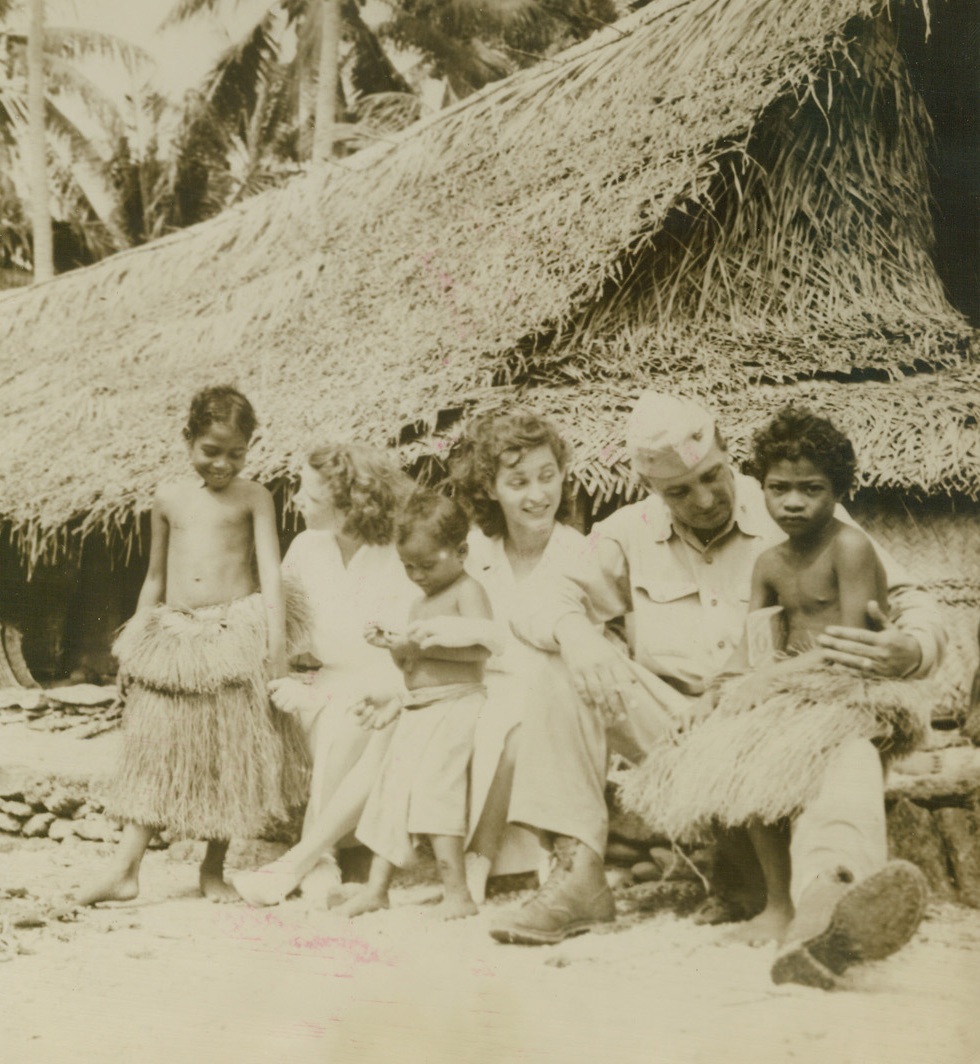
The Navy Goes Calling, 1/9/1945. Caroline Is.—These native children in the Caroline islands got their first glimpse of a white woman when these two Navy nurses and a Navy officer visited them in their village. A nice time was had by all, as it was the first time that the girls had seen natives in their habitat, left to right: Ensign Faye Martin, Houston, Tex.; Ensign Wanda Leshkowitz, New Brunswick, N.J.; and Lt. Comdr. John Carrauthers, Charlottesville, Va. Credit (ACME);
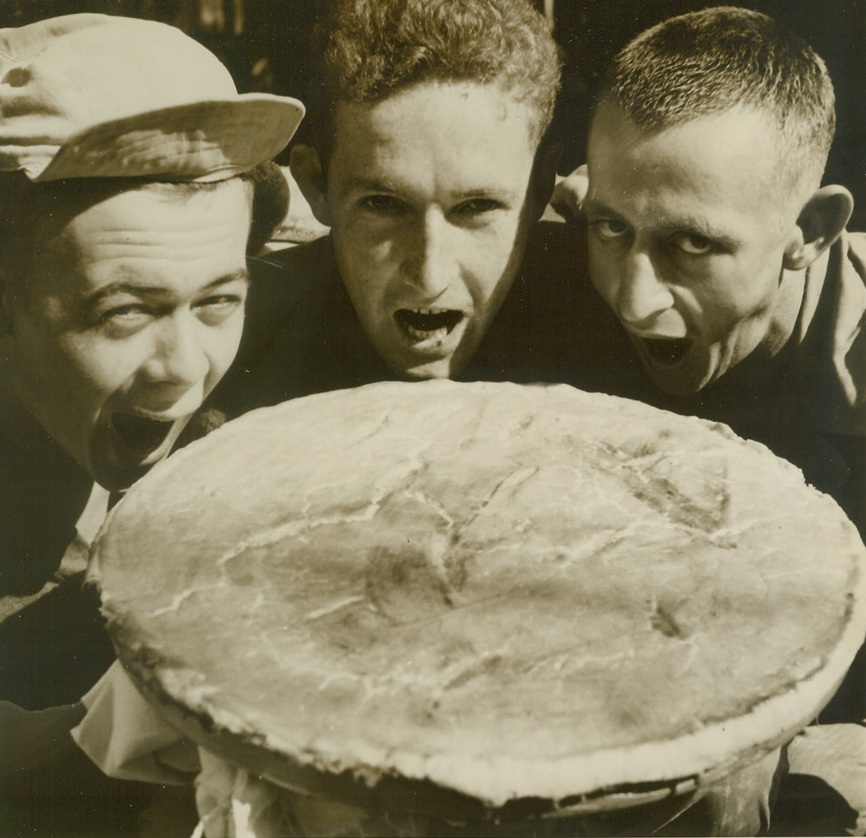
Hey Maw? Bring on the Castor Oil, 1/29/1945. Luzon, Philippines – There’ll be a hurry call for castor oil on the Luzon front if these gee eyes make this monster pie disappear. Left to right: Pfc William Sheppard, Auburn, Ill.; T/4 Charles Chaw, Eudora, Miss.; and T/5 Robert Koon, Booneville, Miss., are about to take healthy bites from the pie they baked themselves. Photo by Willard Hatch, ACME photographer for the War Picture Pool. Credit line –WP- (ACME);
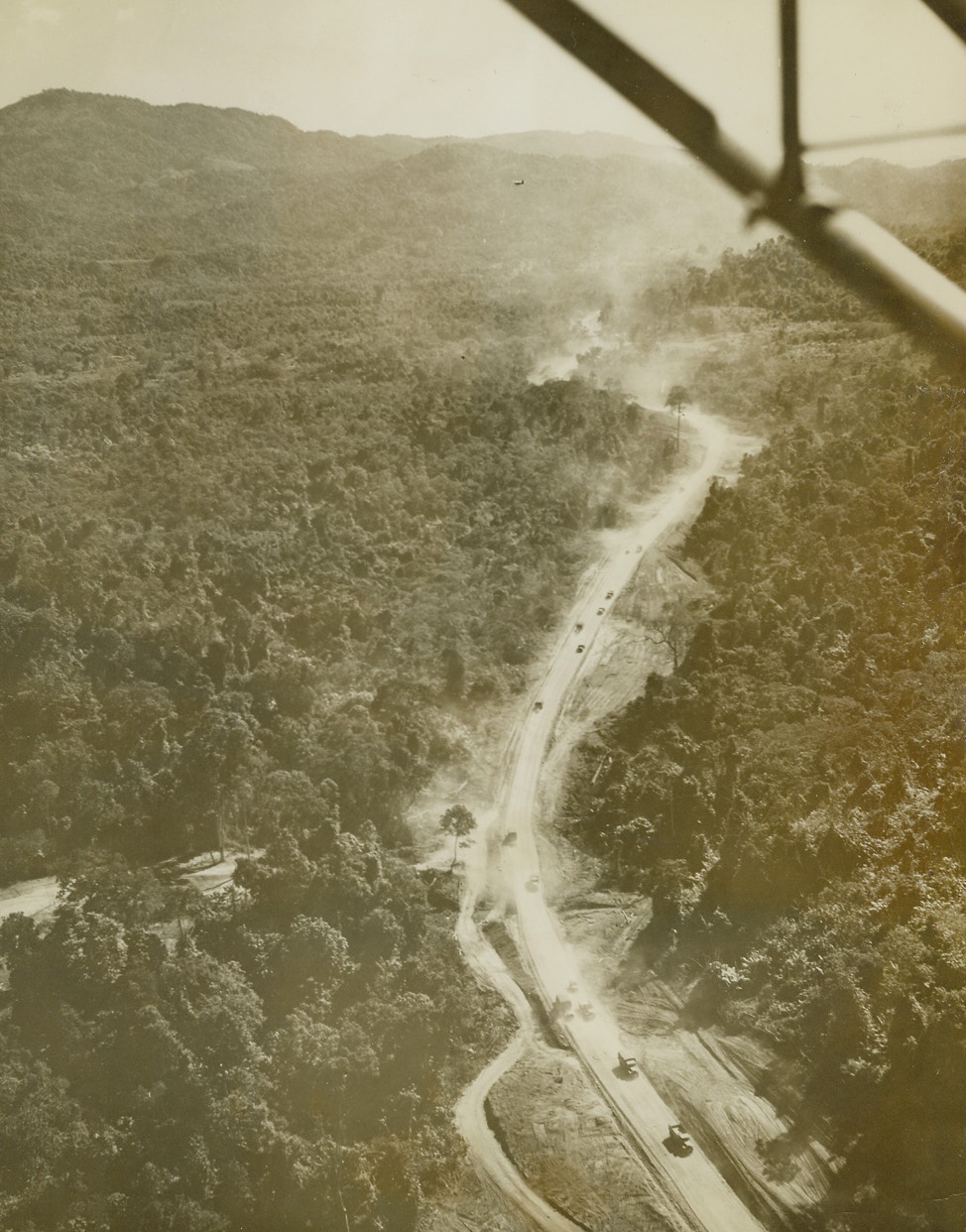
No Title. 1/31/1945. Scene of furious battles with nature, as well as the Japs, and the product of allied blood, toil and determination, the Burma-Ledo highway is open again. As a tribute to Gen. Joseph W. Stilwell, who planned the artery and almost saw it completed before his recall from China, the 620-mile highway has been officially named the Stilwell road. Stretching across monsoon-swollen rivers, steep hills and fever-infested jungles to bring supplies to China, the Stilwell road has become the main artery from which new blows against Jar an will soon be delivered. These pictures show the first China-bound convoy to travel over the Stilwell road since the Jap invasion of Burma in 1942. Kunming, China, 1000 miles from the starting point, Ledo, is the final destination of the convoy. New York Bureau Raising a cloud of dust as far back as the eye can see, the convoy approaches Myitkyina, Burma. This air view clearly shows the density of the virgin jungle through which the road had to be carved. Photo by Frank Cancellare, ACME photographer for the War Picture Pool. Credit line –WP- (ACME);
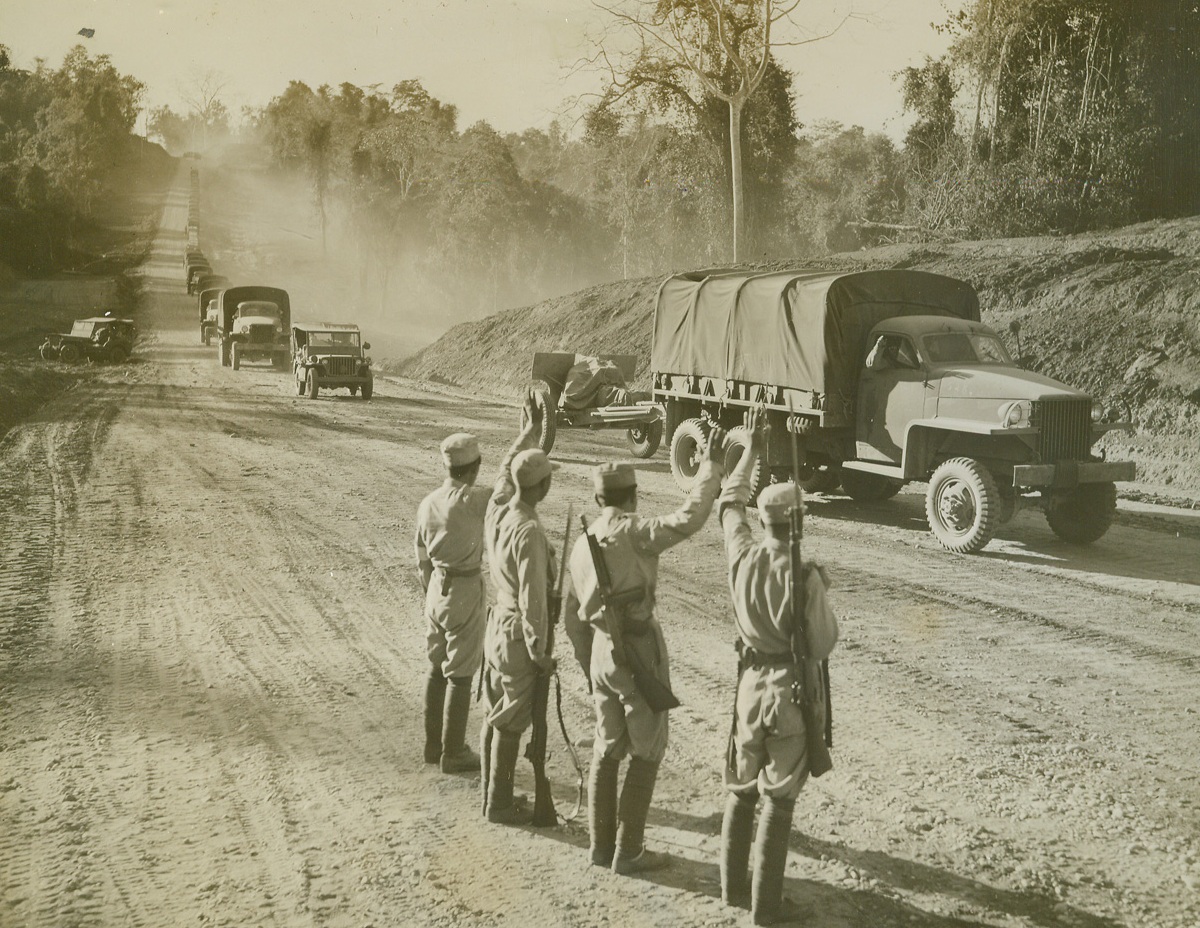
No Title. 1/31/1945. Scene of furious battles with ….Japs, and the product of …., blood, toil, and determination. The Burma-Ledo highway is open again. As a tribute to Gen. Joseph W. Stilwell, who planned the artery and almost saw it completed before his recall from China. The 620 mile highway has been officially named the Stilwell road. Stretching across monsoon-swollen rivers, steep hills and fever-infested jungles to bring supplies to China, the Stilwell Road has become the main artery from which new blows against Japan will soon be delivered. These pictures show the first China-bound convoy to travel over the Stilwell road since the Jap invasion of Burma in 1942. Kunming, China, 1000 miles from the starting point, Ledo, is the final destination of the convoy. New York Bureau At Myitkyina, Burma, Chinese soldiers who fought to open the road stand at the sidelines and wave to the passing trucks. Photo by Frank Cancellare, ACME photographer for the War Picture Pool. Credit line—WP—(ACME);
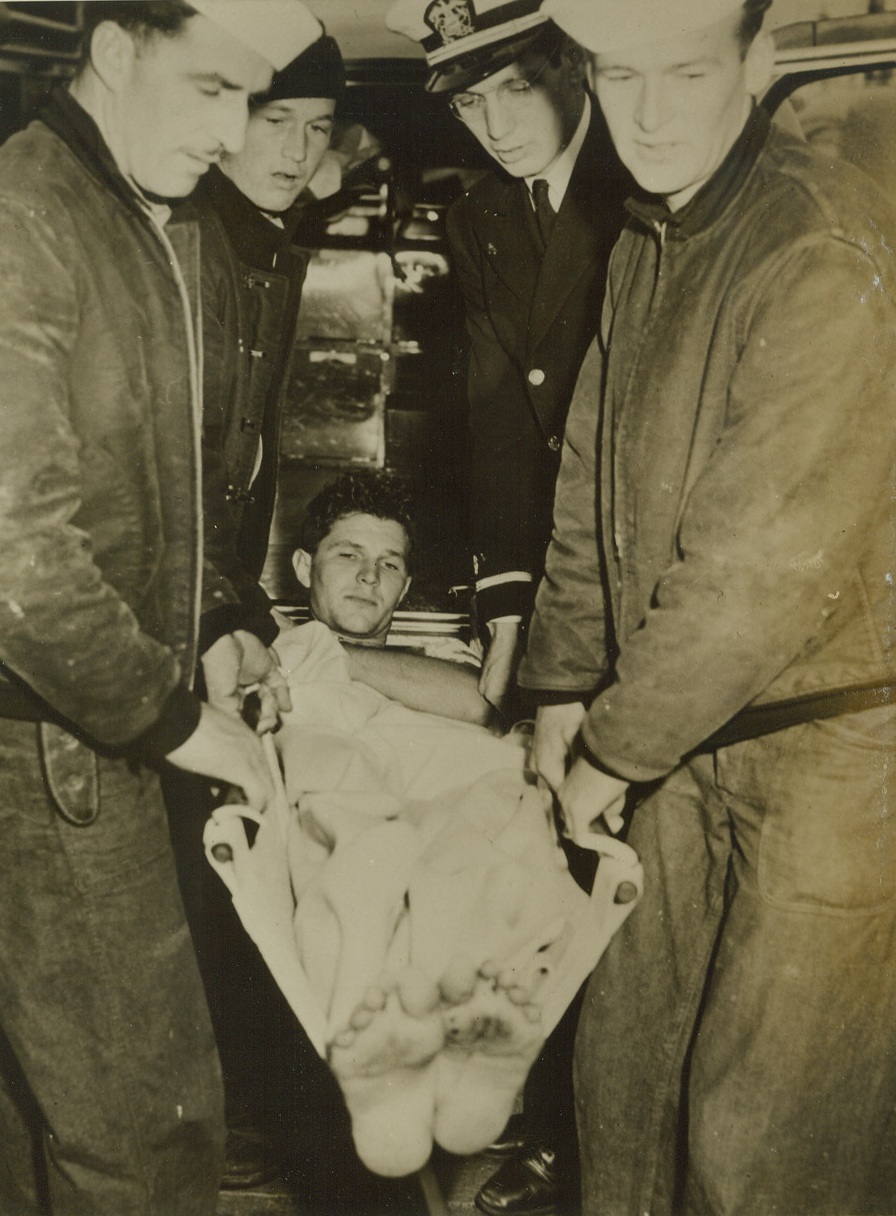
No Title. 1/19/1945. San Francisco—Resuming undersea warfare for the first time since 1942, a Jap submarine torpedoed and sank The Liberty Ship John A. Johnson. Between California and Honolulu recently. Of the 70 merchant and Naval crewmen, 10 were killed and six injured, victims of Jap atrocities after the ship was attacked. After torpedoing the ship, the sub surfaced and went back and forth in the water seeking out surviving seamen, machine gunning them and ramming them with a loaded lifeboat. Here merchant seaman Jack V. Wilson, who was machine gunned by the Japs, is carried ashore by Navy men, after a midsea rescue.Credit: Official U.S. Navy photo from ACME.;
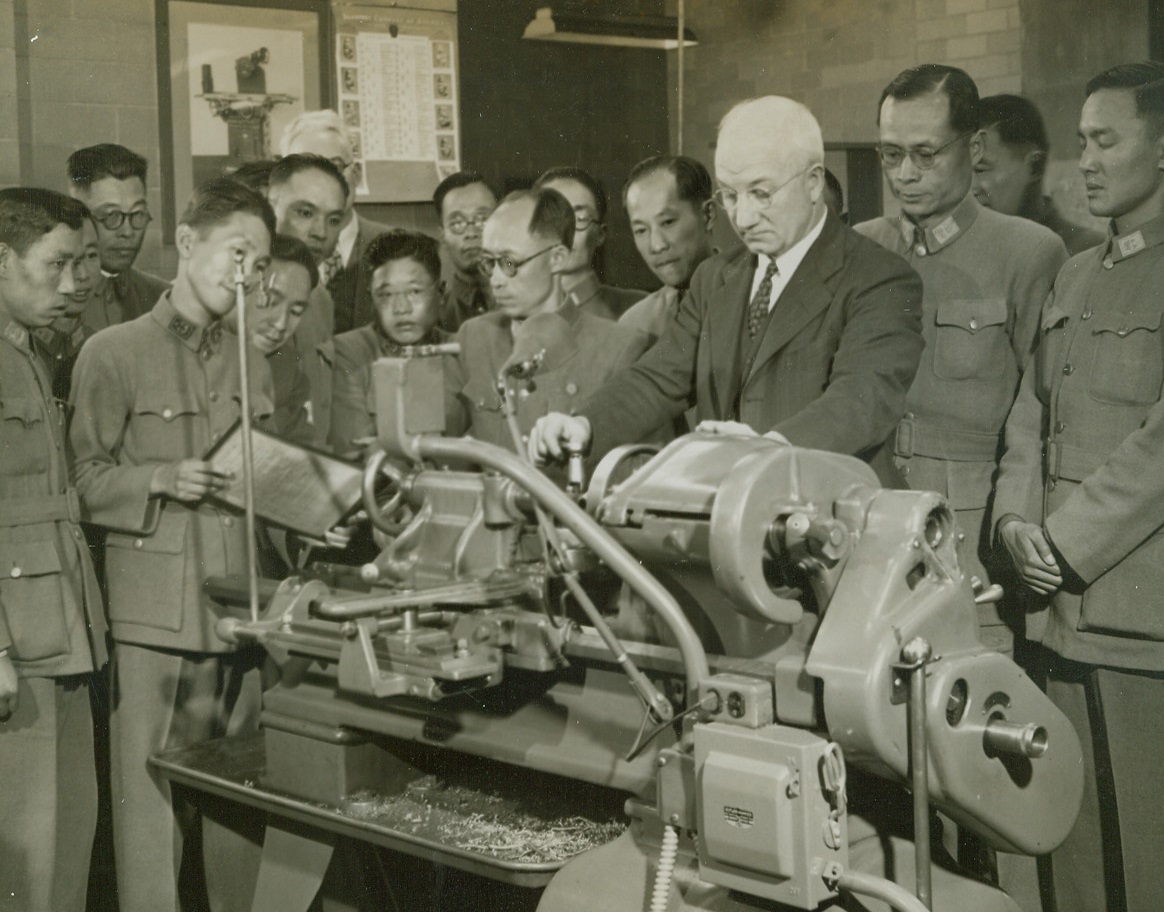
Chinese Officers Enroll at N.U., 1/24/1945. Evanston, Ill.—Nineteen ordnance officers of the Chinese Army, under the direction of General Kiang, who is in charge of the Chinese Army Ordnance in the United States and Canada, begin an eight week course of training in management and manufacturing methods of the department, conducts the students on a tour of the school’s Technological Institute. Credit: ACME.;
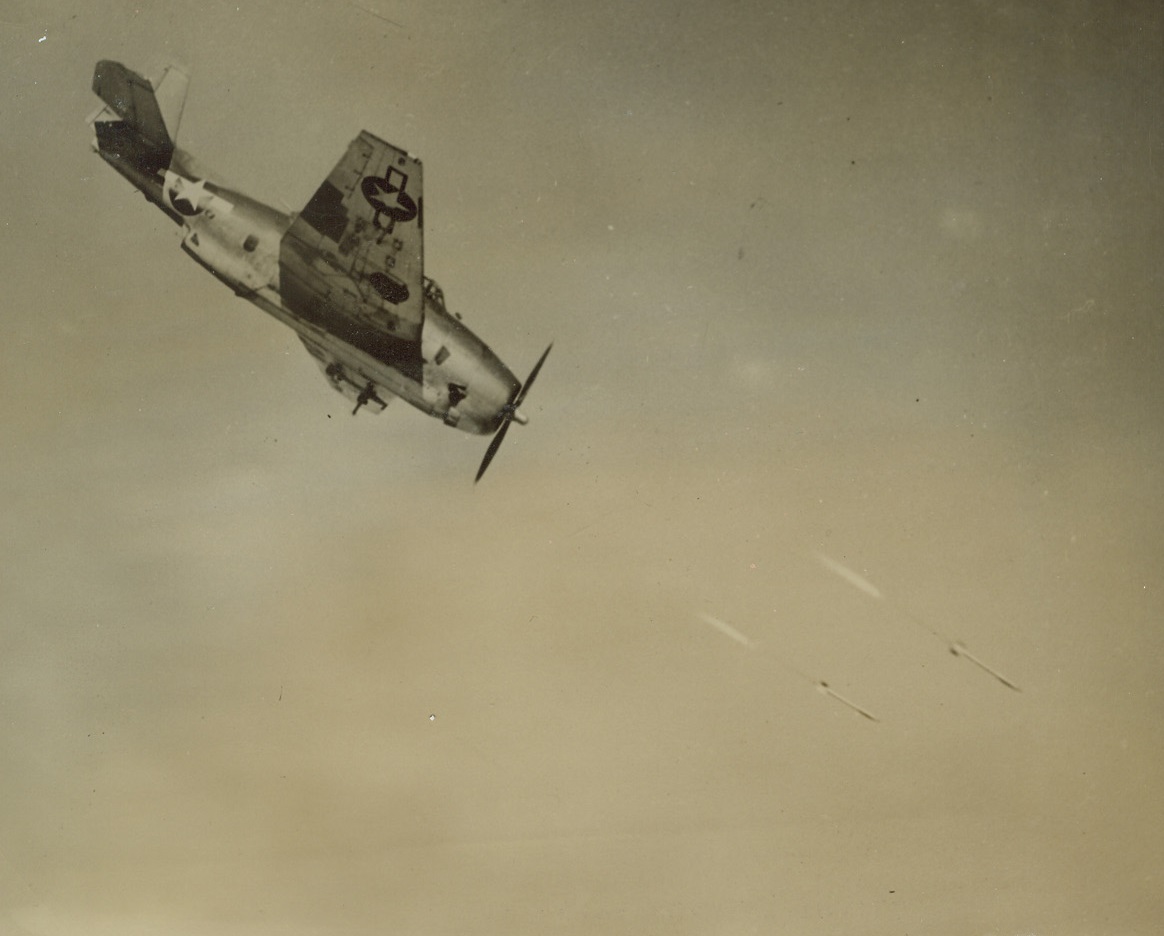
Rockets Away, 1/26/1945. Inyokern, Calif.—Rockets leave flaming trails as they zoom from the undercarriage of a Navy flighter plane during practice firing over the Mojave Desert at the Navy’s 1025 square mile Inyokern testing station. The test area, larger than Rhode Island, is the scene of extensive experimentation by Navy and Marine Corps air and ground forces in the use of the rocket. Credit: U.S. Navy photo from ACME.;
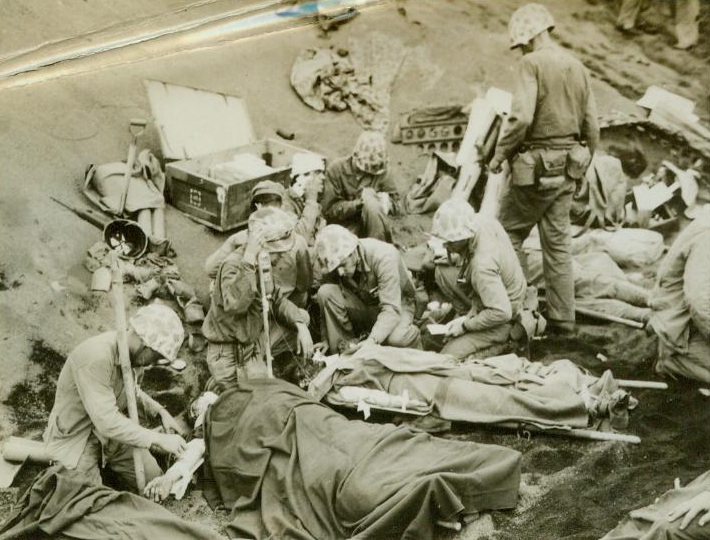
Plasma for Iwo wounded, 1/31/1945. IWO JIMA – Casualties from the bloody fighting on “Hell’s acre” – Iwo – are given first aid treatment and plasma injections by navy doctors and corpsmen at an aid station set up in a gully on the island, the heavy toll of wounded necessities the use of many gallons of plasma – contributed by the folks “back home.”;
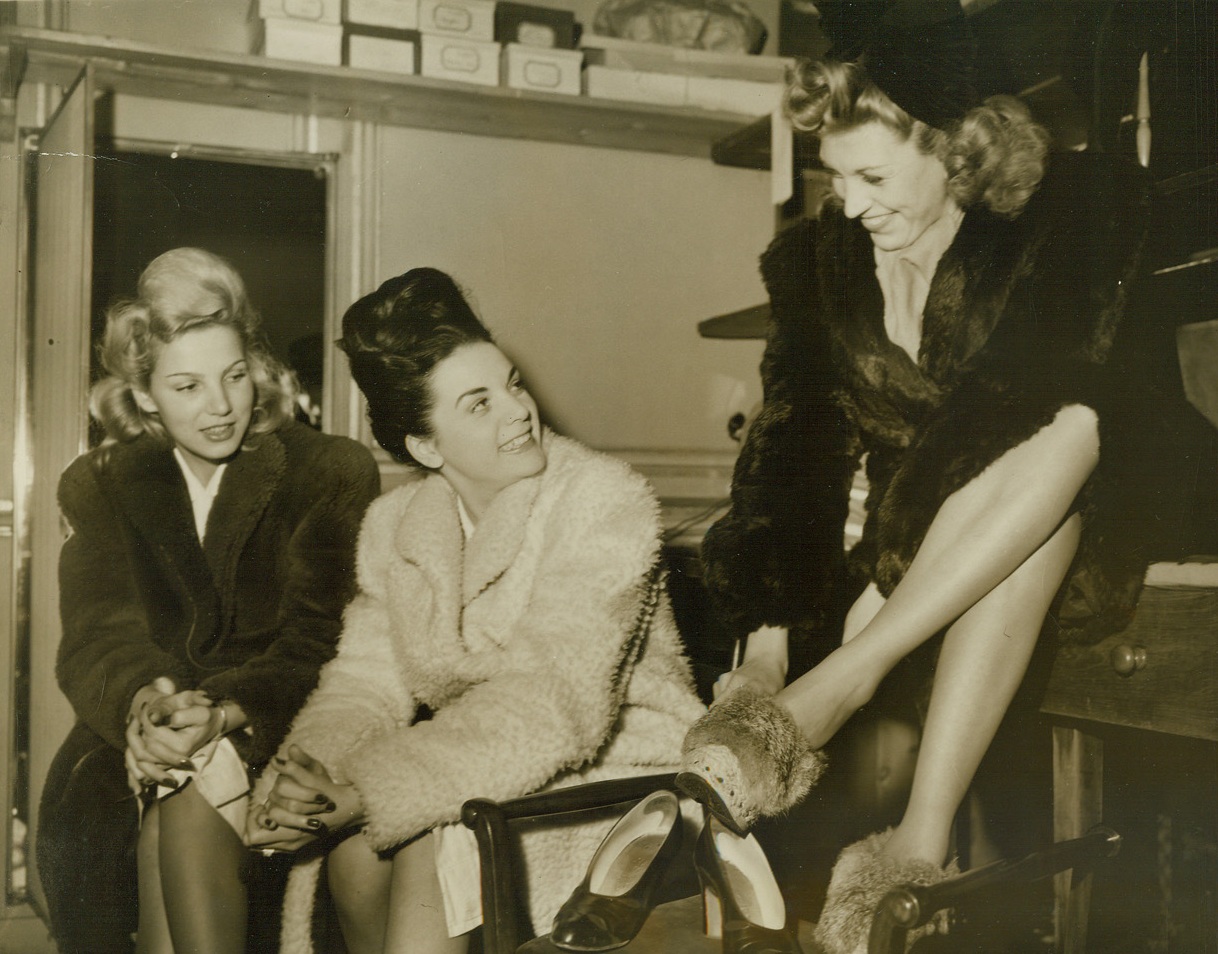
No Title. 1/20/1945. Paris - Parisians have had a tough time keeping warm this winter and almost as tough a time getting their daily ration of food. Homes, offices, style salons, all have an almost constant temperature of near zero (Centigrade) and no relief is in sight. Warm clothing is scarce, coal is nonexistent even in the Black Market and the small quantities of firewood on hand are hard to get and prohibitive in price. As for food, French officials say the situation in Paris is “normal” after four years of occupation, but all food supplies are very limited. This series of photos by ACME photographer Sherman Montrose, for the War Picture Pool, shows what Parisians are enduring this very cold winter. As her friends look on, a Parisian model puts on a pair of rabbit-skin-lined shoes with heavy wood soles for protection against the snow and slush-covered streets of the city. Good leather shoes are practically non-existent and bring $100 and more on the Black Market. These girls are lucky to have fur coats to keep them warm. Good, warm clothing is scarce and the Parisian girl piles on all the clothing she can get to keep out the cold. Credit: ACME;
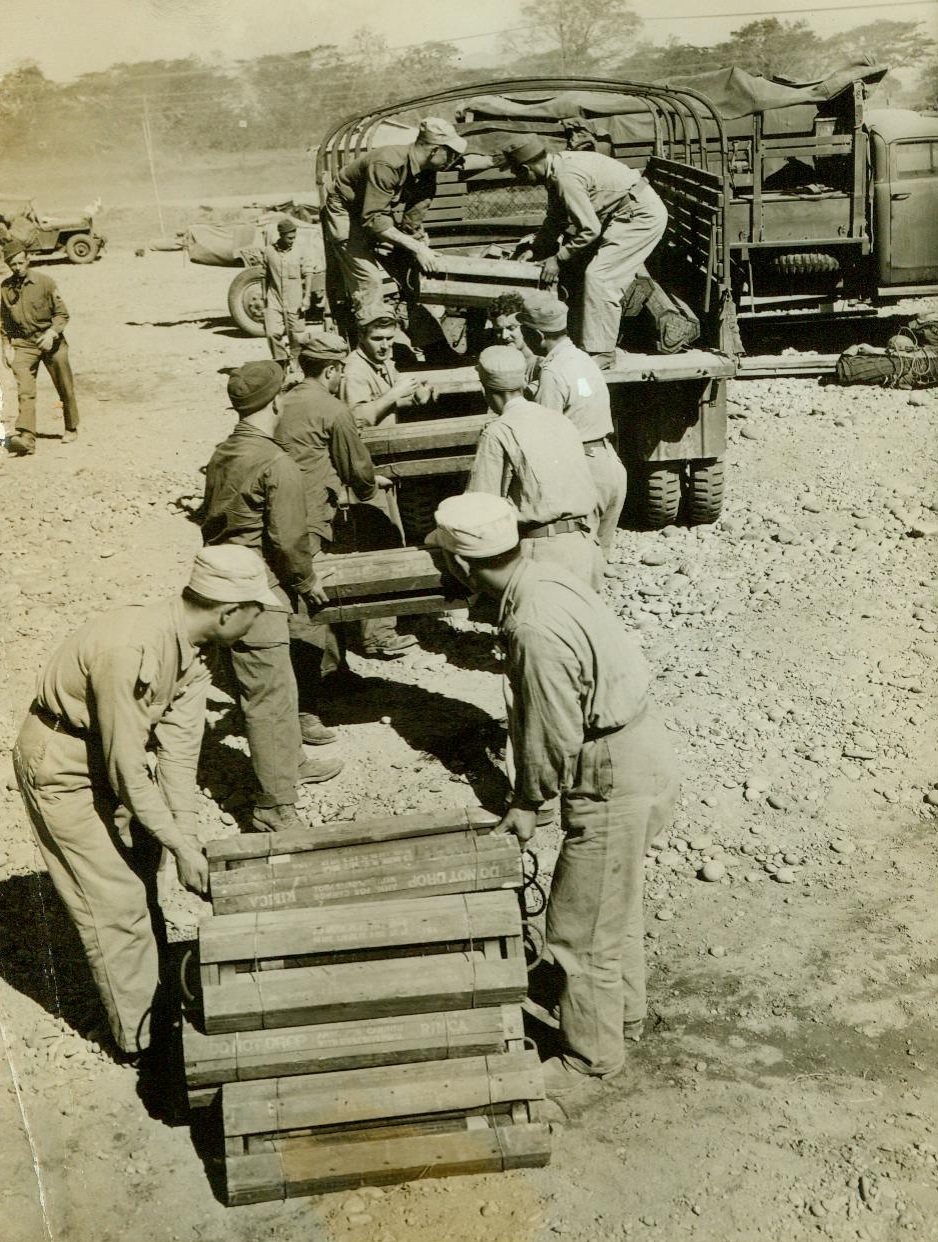
Loading up at Ledo, India, American and Chinese soldiers, 1/31/1945. Loading up at Ledo, India, American and Chinese soldiers pile ammunition into one of the convoy trucks. CREDIT LINE (ACME) 1/31/45;
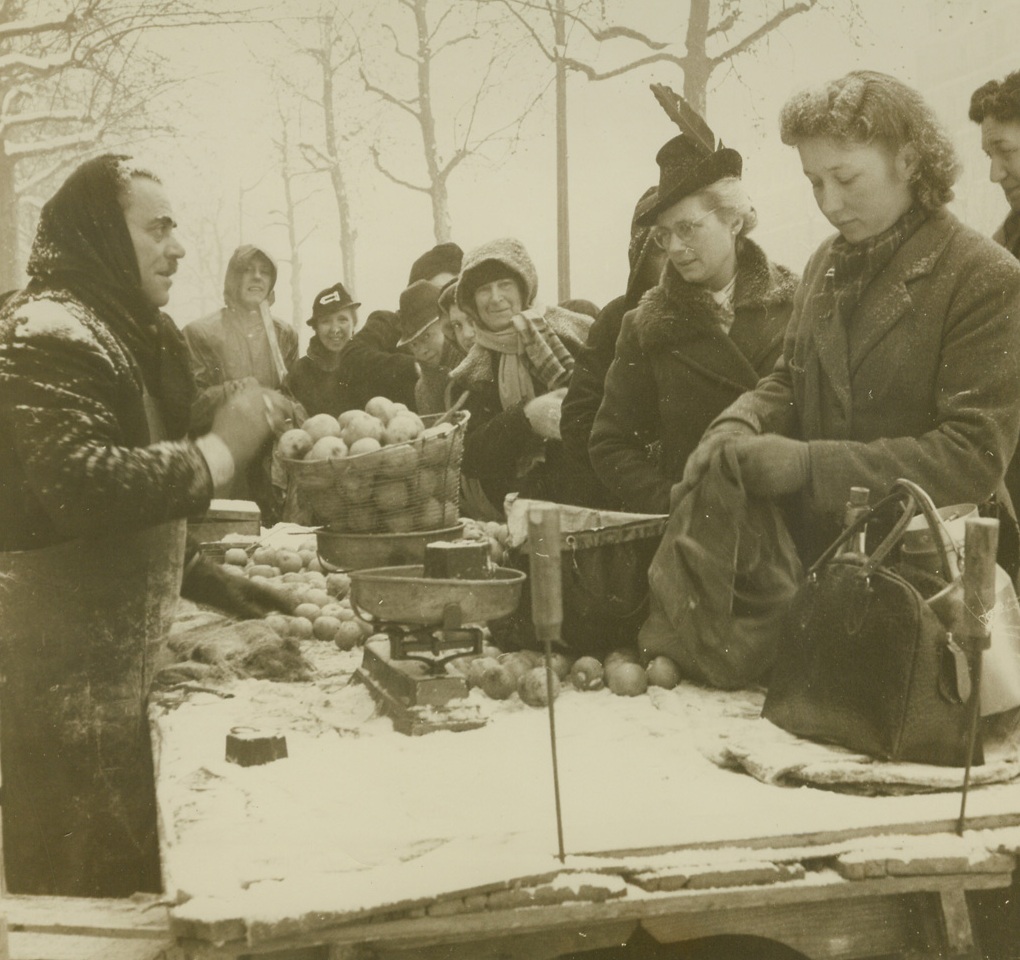
IN PARIS IT’S COLD AND FOOD IS SCARCE, 1/20/1945. PARIS—Parisians have had a tough time keeping warm this winter and almost as tough a time getting their daily ration of food. Homes, offices, style salons, all have an almost constant temperature of near zero (centigrade) and no relief is in sight. Warm clothing is scarce, coal is non-existent even in the black market and the small quantities of fire wood on hand are hard to get and prohibitive in price. As for food, French officials say the situation in Paris is “normal” after four years of occupation, but all food supplies are very limited. This series of photos by ACME photographer Sherman Montrose, for the War Picture Pool, shows what Parisians are enduring this very cold winter. New York Bureau Despite inclement weather, this apple stall in on of Paris’ largest open-air markets does a thriving business. Parisians bundled against the cold buy the few supplies on display. Credit –WP- (ACME);
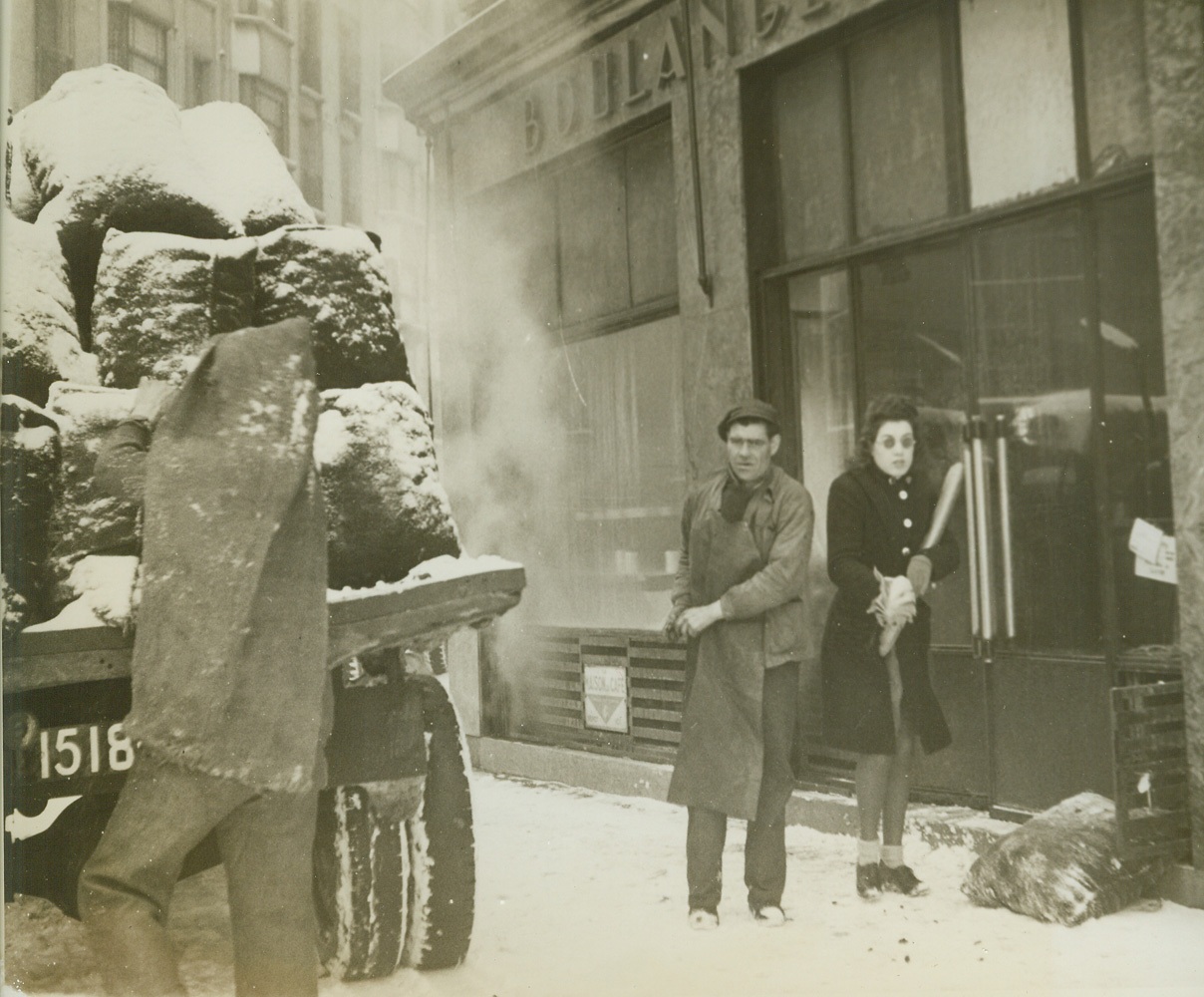
In Paris, It’s Cold and Food Is Scarce, 1/20/1945. Paris -- Parisians have had a tough time keeping warm this winter and almost as tough a time getting their daily ration of food. Homes, offices, style salons, all have a near constant temperature of near zero centigrade and no relief is in sight. Warm clothing is scarce, coal is nonexistent even in the black market and the small quantities of firewood on hand are hard to get and prohibitive in price. As for food, French officials say the situation is “normal” after four years of occupation, but all food supplies are very limited. This series of photos, by Alan Montrose for the War Picture Pool, shows what Parisians are enduring this very cold winter. New York Bureau There is some coal in Paris but it goes to hospitals and to baker’s ovens to provide necessary rations of bread for the none-too-well-fed people of the city. This coal is being unloaded in front of a bakery shop. A woman, shivering against the cold, clutches her all-important loaf. Credit: ACME;
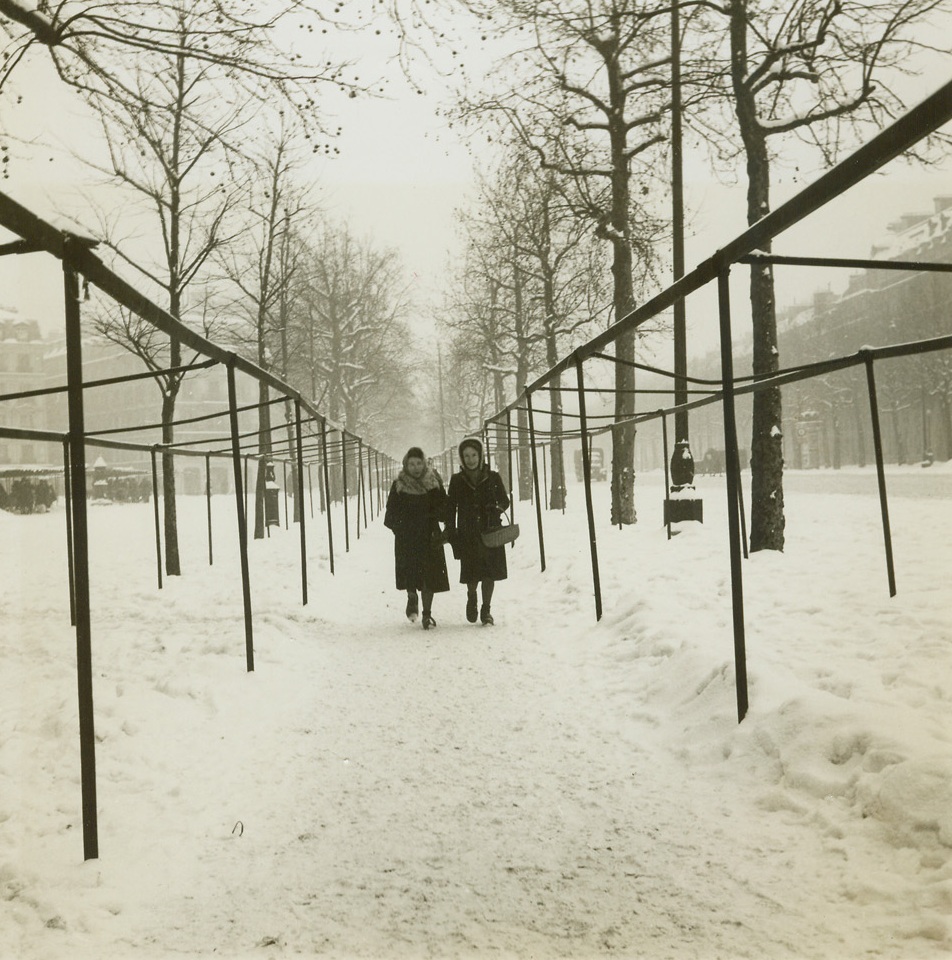
In Paris, It’s Cold and Food Is Scarce, 1/20/1945. Paris -- Parisians have had a tough time keeping warm this winter and almost as tough a time getting their daily ration of food. Homes, offices, style salons, all have a near constant temperature of near zero centigrade and no relief is in sight. Warm clothing is scarce, coal is nonexistent even in the black market and the small quantities of firewood on hand are hard to get and prohibitive in price. As for food, French officials say the situation is “normal” after four years of occupation, but all food supplies are very limited. This series of photos, by Alan Montrose for the War Picture Pool, shows what Parisians are enduring this very cold winter. New York Bureau Two heavily-clothed women walk past empty booths in one of Paris’ largest open-air shopping districts. This was an “open” day but because of food shortage and a possible heavy snowfall halting deliveries, a majority of the stalls were empty. In background at left crowds gather round the few stalls that had enough foodstuffs to open for business. Credit: ACME;
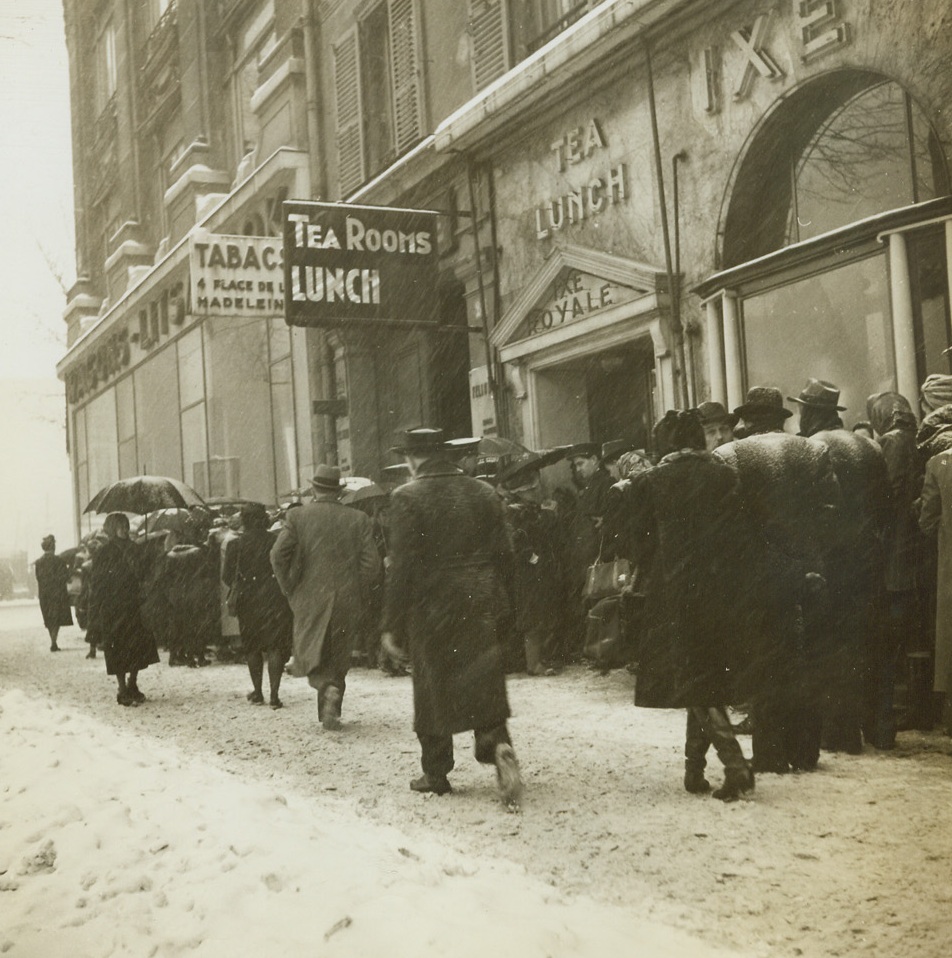
Making Do on a Cold Paris Morning, 1/20/1945. Paris, France – Weathering the first heavy snowfall of the year, Parisians line up in the morning before a café to get their ration of ersatz “coffee.” Parisians are battling limited food supplies and coal shortages during what has been a bitterly cold winter. Credit: ACME;
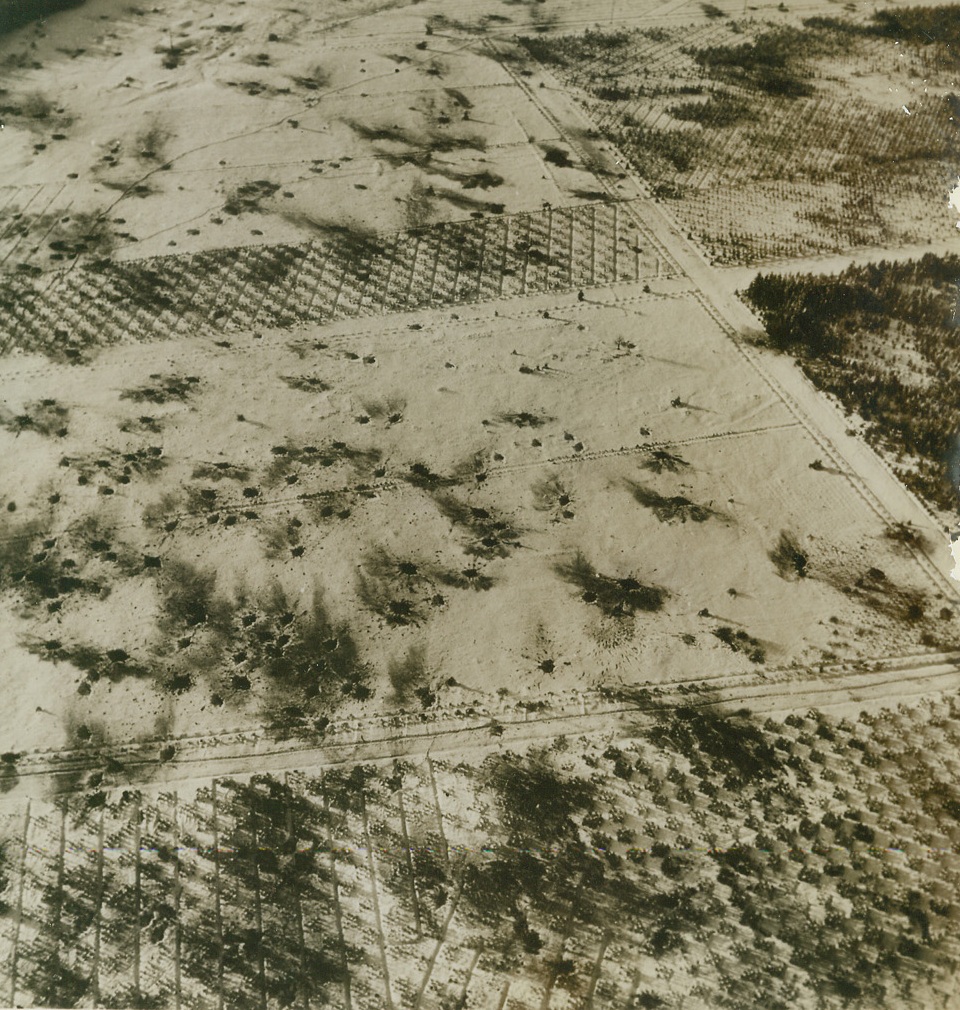
Scene of Battle, 1/27/1945. On the snow-covered terrain of the Ardennes, bomb bursts form crude pock-marked patterns as a result of the Battle of the Bulge near town of Langlir, Belgium. Credit: ACME;





 Trash & Recycling
Trash & Recycling
 Online Payments
Online Payments
 City Documents
City Documents
 Parks
Parks
 Traffic Court
Traffic Court
 CITY PARKS
CITY PARKS
 RECREATION
RECREATION
 Volunteer
Volunteer
 Home
Home TRANSLATE
TRANSLATE
